

12 Top-Rated Attractions & Things to Do in Santiago de Compostela
Written by Lisa Alexander Updated Dec 24, 2023 We may earn a commission from affiliate links ( )
Pilgrims once traveled, by foot, from all over Europe to reach Santiago de Compostela. During the Middle Ages, the city was equal to Jerusalem and Rome as a pilgrimage destination. The aim of this months-long journey, known as the Chemin de Saint-Jacques (or Camino de Santiago ) was to arrive at the Tomb of Saint James, housed in the Catedral de Santiago.
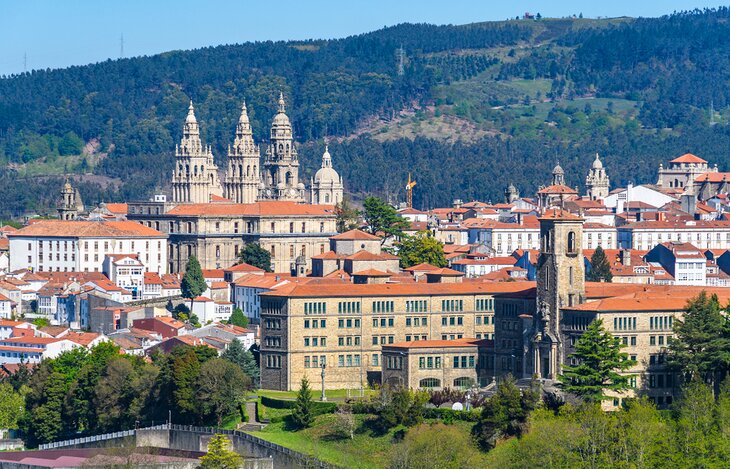
Still one of the most revered shrines in Christendom, Santiago de Compostela continues to draw modern-day pilgrims.
Besides its religious monuments, the city offers many cultural attractions. Interesting museums, a quaint Old Town, and enchanting botanical gardens await if you take time to explore the hidden corners of Santiago de Compostela.
No matter how or why you arrive here, Santiago de Compostela is a rewarding destination at the heart of the beautiful Galicia region. The UNESCO -listed historic center, especially the magnificent Cathedral of Santiago, is not-to-be-missed on a tour of Northern Spain .
Make the most of your time in this fascinating historic city and discover the best places to visit with our list of the top attractions and things to do in Santiago de Compostela.
See also: Where to Stay in Santiago de Compostela
1. Catedral de Santiago
2. hostal de los reyes católicos, 3. plaza del obradoiro, 4. camino de santiago and museo das peregrinacións, 5. explore casco antiguo (old town), 6. parque de la alameda, 7. centro galego de arte contemporánea, 8. casa do cabildo, 9. museo do pobo galego, 10. cidade da cultura de galicia, 11. colegiata de santa maría la real de sar, 12. day trip to the seaside town of vigo, where to stay in santiago de compostela for sightseeing, tips and tours: how to make the most of your visit to santiago de compostela.
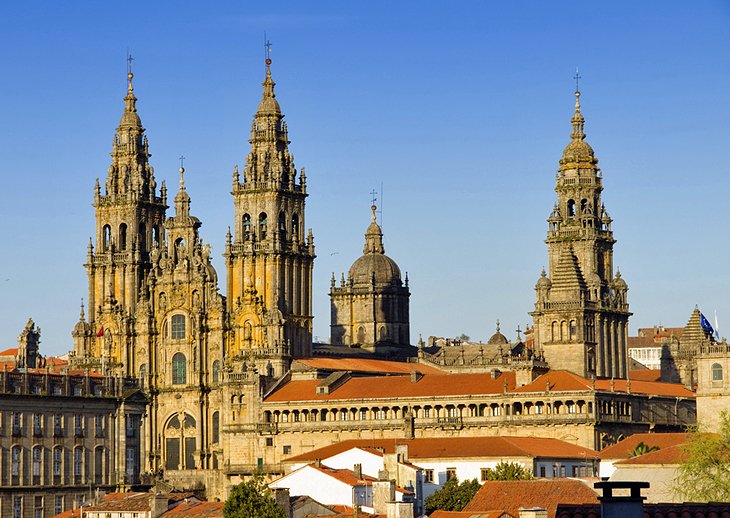
The sight of this magnificent cathedral rewarded medieval pilgrims after lengthy and arduous journeys, and still delights modern-day visitors. A masterpiece of Romanesque and Baroque architecture, the Catedral de Santiago is considered Spain's most sacred Christian church.
Welcoming pilgrims and tourists alike is a splendid entrance called the Portico de la Gloria . Created by Master Mateo in 1188, this doorway is a profusion of sculpture featuring 200 figures from the Apocalypse story and the figure of Saint James the Apostle.
The Obradoiro Facade (facing the square) was created by Fernando de Casas y Novoa. This lavish facade is considered to be the finest example of Spanish Baroque style.
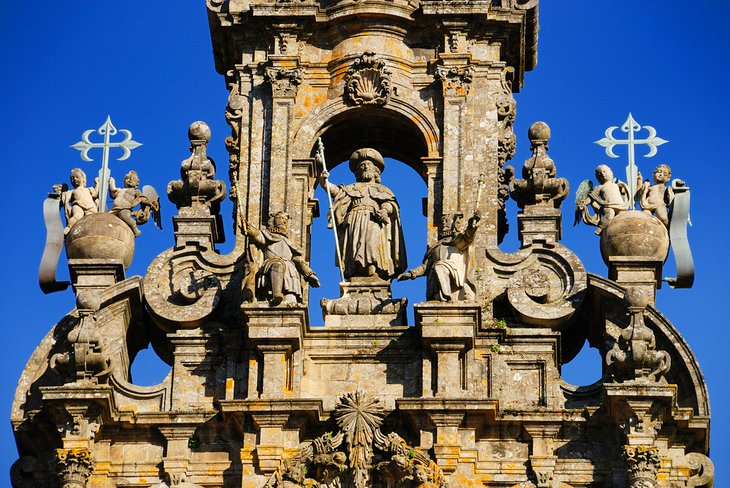
The Catedral de Santiago makes a grand first impression, setting the stage for an inspiring spiritual experience. Upon entering the sanctuary, you are awed by the grandiose and serene space of three naves with an astounding surface area of about 8,300 square meters.
Directly beneath the opulent Baroque main altar is the main draw for all pilgrims to Santiago, the Crypt of Saint James the Apostle, patron saint of Spain. The crypt contains the Tomb of Saint James , the object of veneration for pilgrims.
The Capilla de las Reliquias , the first chapel in the south aisle, contains tombs of kings and queens of the 12th to 15th centuries. Beyond the south transept to the right of the Puerta de las Platerías is a gorgeous Renaissance (16th-century) Plateresque cloister, one of the largest in Spain.
Located within the cloister, the Cathedral of Santiago Museum illustrates the history of the cathedral and presents an assortment of artworks. Highlights are the tapestries by Rubens and Goya. The museum also contains the Cathedral Treasury .
The Fiestas del Apóstol Santiago are held every year during the last two weeks of July. Festivities include music concerts, folkloric dance performances, traditional parades, street entertainment, light shows, and fireworks. On July 25th, a High Mass celebration takes place at the Catedral de Santiago.
Address: Plaza Obradoiro, Santiago de Compostela
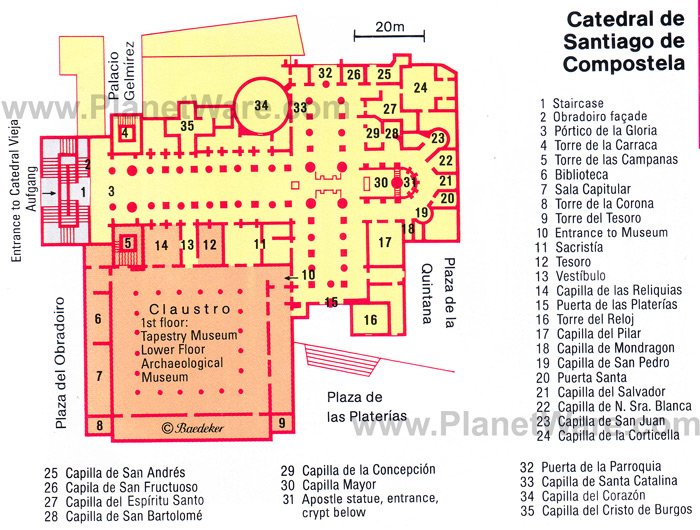
This former pilgrims' hostel is a splendid example of Gothic Plateresque architecture. Noteworthy elements include the decorative facade and four peaceful interior courtyards (cloisters).
In 1499, the Catholic Monarchs created a place of lodging for weary pilgrims. It's easy to imagine the joy travelers must have felt when they reached this beautiful destination.
The Hostal de los Reyes Católicos is Spain's oldest hotel. Continuing the tradition of hospitality, the historic building has been renovated and now houses the five-star Parador de Santiago de Compostela .
At this luxurious accommodation, you will enjoy plush modern guest rooms, top-notch services (room service, butler service, concierge, valet parking), and authentic Galician cuisine. The hotel offers two dining options: a fine-dining restaurant and a casual restaurant.
The Hostal de los Reyes Católicos also has an exquisite chapel, the Capilla de Enrique de Egas , which guests may use for silent prayer.
Address: 1 Plaza Obradoiro, Santiago de Compostela
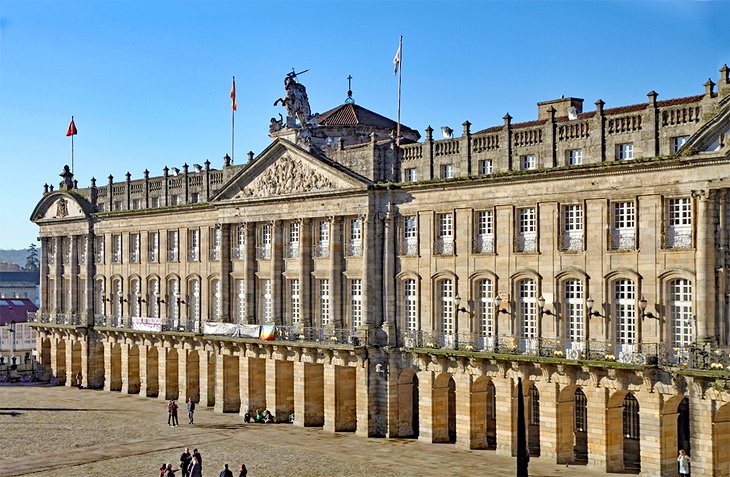
The Cathedral of Santiago de Compostela forms the east side of the Plaza del Obradoiro. This large pedestrian-only public square represents the heart of the Casco Antiguo (Old Town).
The plaza's name, which translates to "Workshop Square," originates from the time when the cathedral was being built. For years, numerous stone masons worked here, constructing the edifice we see today.
This grand square is boxed in by three other historic landmarks, including the Hostal de los Reyes Católicos to the north; Palacio de Raxoi (City Hall) to the west; and the 17th-century Colegio de San Jerónimo, which is now a part of Santiago University, to the south.
Next door to the cathedral, the Monasterio de San Martiño Pinario is another landmark building with a rich history. The monastery has a church and museum that are open to the public. Guided tours are available.
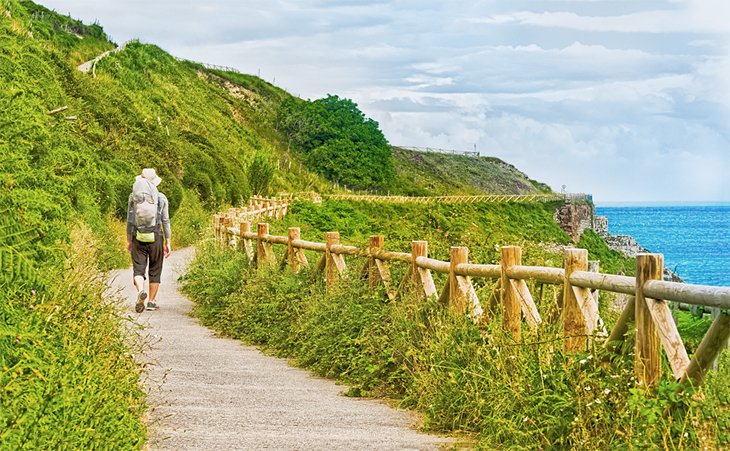
The Camino de Santiago is the name for the pilgrimage trail to Santiago de Compostela. This medieval pilgrimage began in the 9th century with various routes originating all over Europe. Pilgrims set out on this walk with the goal of venerating the Tomb of Saint James.
During the High Middle Ages, a pilgrimage culture flourished. Splendid Romanesque churches were built at key stopping points along the way.
The pilgrims' symbol is the scallop shell, and historic sites related to the Camino de Santiago are indicated with a shell icon. Modern-day pilgrims tie the scallop shells to their backpacks.
The Museo de las Peregrinaciones y de Santiago (Pilgrimage Museum) presents the fascinating history of the pilgrims of Saint James. The museum explains the importance of the Saint James' relics to the pilgrims, and illustrates the cult of Saint James through ancient artifacts and religious objects.
Historical exhibits explain the origin of Jacobean worship, beginning with the archaeological transfer of the Saint's apostolic body (relics) from Jaffa in the Holy Land to Libredón, the name of the hilltop site that is now part of Santiago de Compostela.
At the museum, you will learn about the influence of pilgrimages on the development of Santiago de Compostela's artistic crafts guilds. The museum has two sites: One is located on Calle de San Miguel and another at Plaza de Las Platerías, the square facing the cathedral.
Address: 4 Calle de San Miguel & Plaza de Las Platerías, Santiago de Compostela
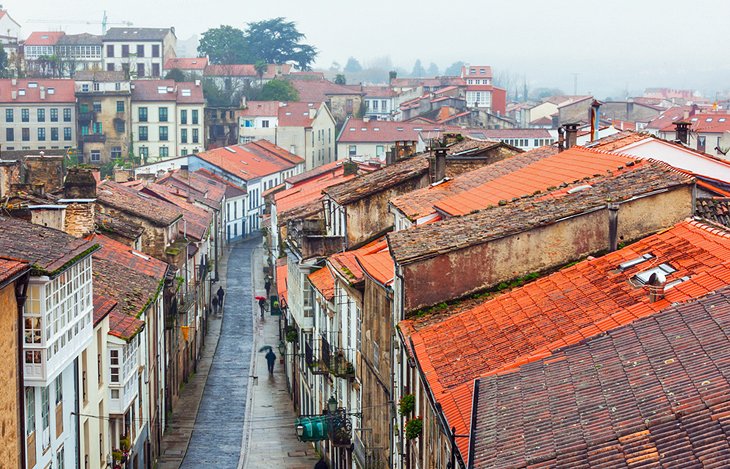
UNESCO has designated the entire Casco Antiguo (Old Town) of Santiago de Compostela as a World Heritage Site. Packed with centuries-old landmarks, the area brims with historic charm.
The Casco Antiguo extends south of the cathedral and the Plaza de Las Platerías , the square that faces the cathedral's Romanesque facade. This fountain-adorned square is enclosed by ornate Baroque monuments.
At the heart of the Casco Antiguo are two parallel streets, the Rúa Nueva and the Rúa del Villar with the 18th-century Casa del Deán at its near end. These two arcaded streets are filled with cafés, restaurants, and boutiques. You will enjoy strolling around these lively pedestrian-only streets.
Much of the Casco Antiguo is closed to automobile traffic, adding to the quaint old-world ambience.
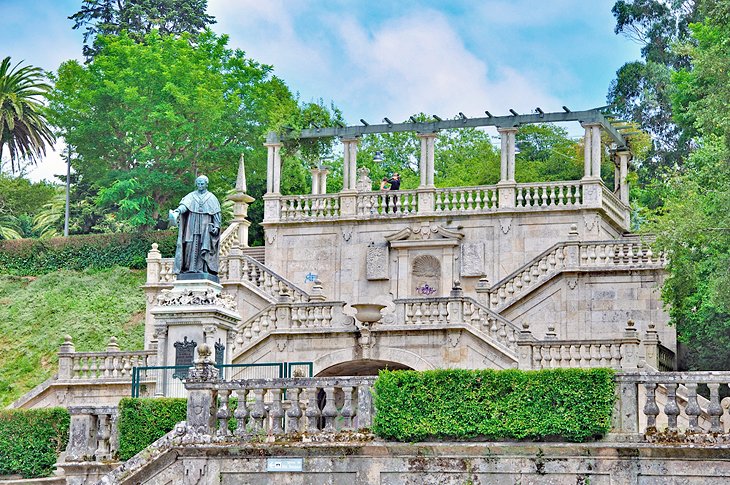
Locals and tourists alike adore this elegant landscaped park. Located adjacent to the Old Town, the park offers wonderful views of the cathedral's west facade.
The lush eight-hectare park includes three separate gardens and noteworthy monuments such as the Iglesia de El Pilar (built in 1717) and the famous Porta dos Leóns (Door of the Lions) dating to 1835. Mediterranean vegetation flourishes here, along with subtropical species and exotic flowers.
For two centuries, La Alameda has been residents' favorite place to take a stroll, a fact memorialized by the As Marías monument, a sculpture of two sisters (well-known local residents) who once took their afternoon walk here each day at 2pm, usually wearing colorful dresses.
A highlight of La Alameda is the Jardínes de Méndez Núñez , a delightful wooded area with a rose garden and an assortment of statues honoring illustrious historical figures of the Galicia region. The Jardínes de Méndez Núñez hosts gastronomy fairs, dance performances, music concerts, and other events throughout the year.
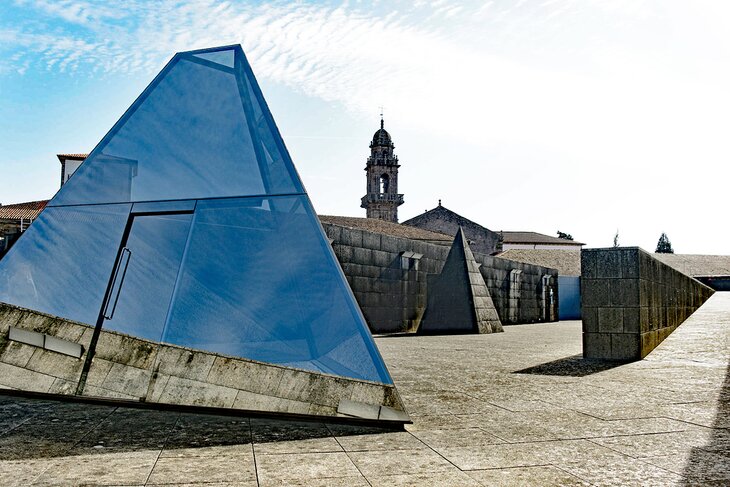
Visit the Galician Center of Contemporary Art to discover the region's modern-day culture. The center is dedicated to contemporary Galician art.
The collection is displayed in the sleek exhibition halls of a building designed in the late '80s and early '90s by Portuguese architect Álvaro Siza. From the building's rooftop terrace, you can admire views of the historic quarter.
In addition to the permanent collection, the center also hosts temporary exhibits related to trends in art.
The museum is open Tuesday through Sunday, from 11am until 8pm, and is closed on Mondays. Admission is free of charge.
Address: 2 Rúa de Ramón del Valle Inclán, Santiago de Compostela
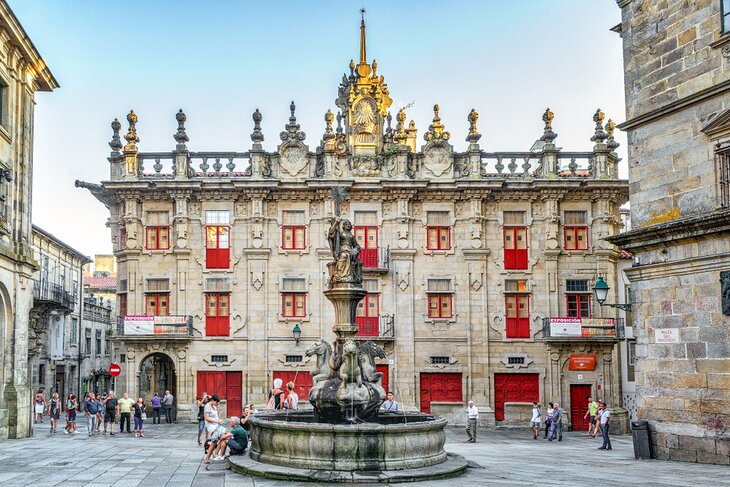
The Casa do Cabildo is considered one of the finest examples of Baroque architecture in the Galicia region. This opulent aristocratic house was built in 1758 and is renowned for its exquisite facade.
Spanish author Valle-Inclán found inspiration at the Casa del Cabildo, which he describes in his story Mi Hermana Antonia .
The building was renovated in 2011 and converted to an exhibition space. The Casa del Cabildo is open to the public when art exhibitions are hosted here.
Address: 2 Plaza de Platerías, Santiago de Compostela
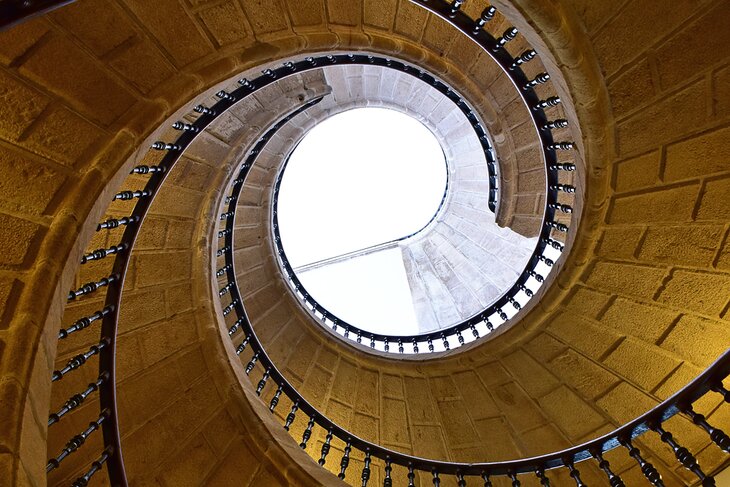
The Museum of Galician People is housed in the former Convent of Santo Domingo de Bonaval. The permanent collection illustrates the cultural heritage of the Galicia region.
Exhibits include archaeological findings and historical objects. The folk culture of the region is well-represented with traditional costumes, crafts, paintings, and sculptures.
The museum is open Tuesday through Saturday from 11am until 6pm, and on Sundays (and holidays) from 11am until 2pm. The museum is closed on Mondays and on December 25th and January 1st.
Address: Calle San Domingos de Bonaval, Santiago de Compostela
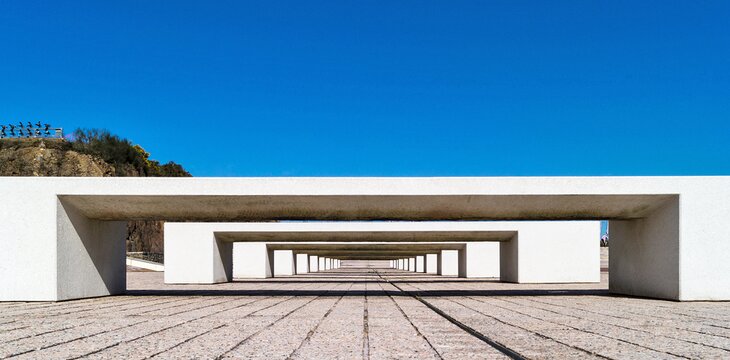
The Cidade da Cultura de Galicia stands in stunning contrast to the historic architecture of Santiago de Compostela. This ultra-modern building complex definitely has 21st-century flair.
Within the Cidade da Cultura complex are several places to visit, including a museum, library, research centers, gardens, theater, outdoor performance space, and a cafeteria/restaurant.
The Museo Centro Gaiás is an art museum that hosts temporary exhibitions, many of which are installations too large to be displayed in most venues. The museum is open daily, free of charge, and has a café with an outdoor terrace.
Guided tours are available. You may choose from a guided visit to the Museo Centro Gaiás, which offers commentary about the current exhibition on display, or a guided visit of the Cidade da Cultura to learn about the various landmarks and outdoor spaces in the complex.
The Cidade da Cultura is a short bus ride from the historic town center of Santiago de Compostela.
Address: Monte Gaiás, Santiago de Compostela
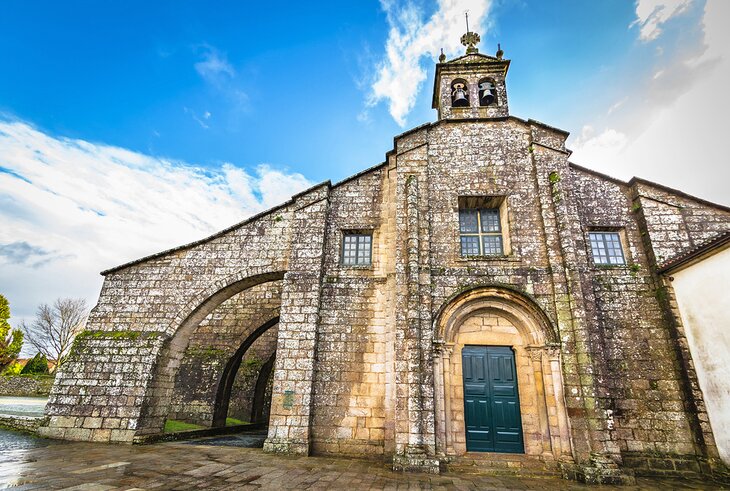
Outside of the city center, the Colegiata de Santa María la Real de Sar is a remarkable Romanesque church that has retained much of the original 12th-century architecture.
Typical of a Romanesque church, the floor plan has three naves separated by pillars with ornately carved capitals. The spaciousness and luminous quality of the sanctuary give it a soul-inspiring ambience.
Be sure to visit the cloister, a marvelous example of Romanesque architecture. The arcaded colonnades feature intricately sculpted decorative details, and offer views of a peaceful garden.
The church has a museum, the Museo da Colexiata do Sar , which displays an archaeological collection along with 18th-century religious objects.
The church is open for visits Monday through Saturday (with an admission fee). Hours are 10am until 2pm.
Address: Plaza de la Colegiata de Sar, Santiago de Compostela
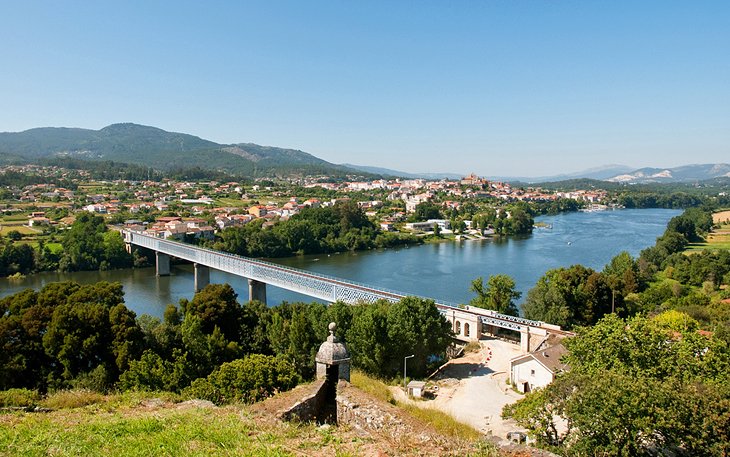
Along the Atlantic Ocean shores and the estuary of the Rías Baixas, the seaside town of Vigo is 87 kilometers from Santiago de Compostela. The town's historic quarter has the ambience of a fishing village. As you would expect, Vigo is renowned for its Galician cuisine based on fresh local fish.
The town has an interesting 20th-century church, the shrine of Nosa Señora da Guía , inspired by the Baroque architecture of Santiago de Compostela.
Housed in a 17th-century palace, the Museo da Cidade Quiñones de León (Municipal Museum of Vigo) has a collection of archaeological findings and paintings by Galician artists. The palace is surrounded by a park with fountains, ponds, and gorgeous French formal gardens.
Another interesting cultural attraction is the Museo do Mar de Galicia (Museum of the Sea). At this fascinating museum, you will learn about the history of fishing and the traditional seafaring way of life of the Galicia region.
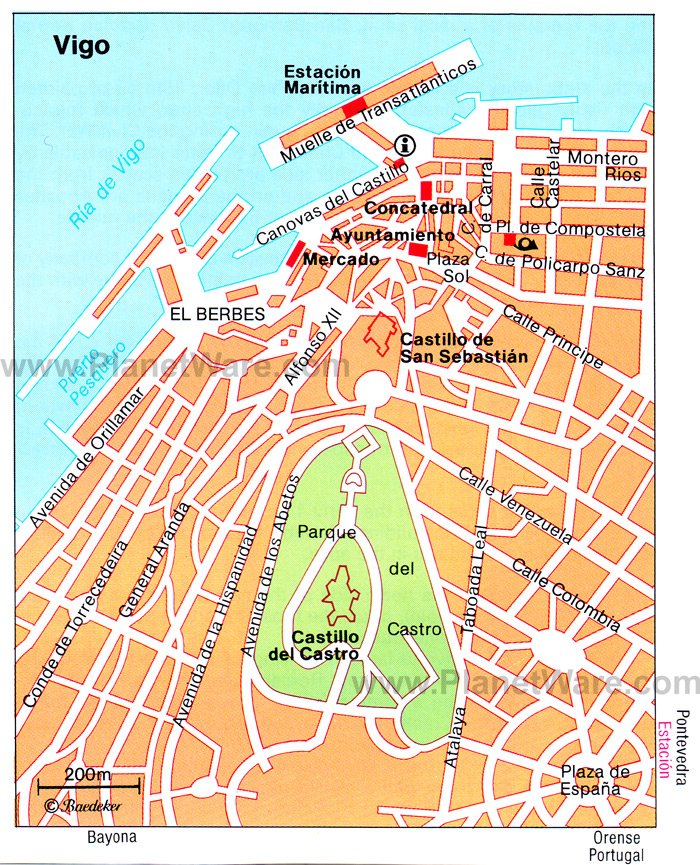
Luxury Hotels:
- The Parador de Santiago de Compostela is one of the most historically significant hotels in the world, located on the Plaza del Obradorio, next to the Catedral de Santiago, in the heart of the Old Town. Highlights of this five-star luxury hotel are the peaceful gardens, elegant reception halls, and gourmet dining options. The hotel also has a museum on the premises.
- Hotel Spa Relais & Chateaux A Quinta da Auga offers historic charm and exceptional service. Guest rooms and suites feature old-fashioned French country-style decor and views of the garden, farm, or forest. This four-star Relais & Châteaux property has a spa, indoor pool, hammam, sauna, and fitness center. The hotel's restaurant serves traditional Galician cuisine prepared from seasonal ingredients. Accommodations include a gourmet breakfast.
Mid-Range Hotels:
- A four-star hotel with mid-range prices, San Francisco Hotel Monumento is centrally located in the Old Town just steps from the cathedral. The hotel has an indoor swimming pool, a central courtyard, and a garden. The on-site restaurant offers room service.
- A Tafona do Peregrino offers spacious modern guest rooms and top-notch services (airport transportation, concierge, and a breakfast buffet). Families traveling with children appreciate the triple rooms and suites. Foodies, take note: The hotel's on-site Restaurat A Tafono has a Michelin star. A breakfast buffet is available.
Budget Hotels:
- Hotel Atalaia B&B may not have the frills and amenities of more expensive accommodations, but the guest rooms feature stylish modern decor and have city views. The friendly service and comfy beds make you feel at home while staying right in the Old Town.
- Within walking distance to the Old Town attractions, the three-star Hotel Altair offers excellent value, with stylish rooms. In addition to an amazing breakfast with homemade jams, amenities include a 24-hour front desk and concierge service.
- Exploring the Costa da Morte : A full-day sightseeing Finisterre & Costa da Morte day tour from Santiago de Compostela is an excellent way to see the picturesque stretch of coastline known as the "Costa da Morte" (so-named because many shipwrecks have occurred here) . This tour along the Atlantic coastline includes visits to Cape Finisterre, the fishing village of Camelle, and the Dolmen de Dombate megalithic monument.
- Visiting Santiago de Compostela from Portugal : Tourists staying in northern Portugal can take a full-day tour from Porto to Santiago de Compostela , led by an expert guide. The tour includes a visit to the Catedral de Santiago and plenty of time to have lunch and explore the Casco Antiguo. The tour stops in Valença do Minho on the way back, a quaint town on the border of Spain and Portugal that is known for its towered fortress.
More Related Articles on PlanetWare.com
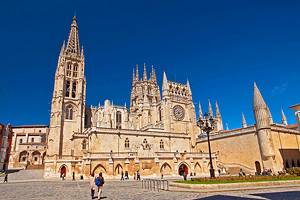
Pilgrimage Churches : As pilgrims made the long journey along the Camino de Santiago, they would visit churches in other Spanish cities on the route. Pamplona , although more famous for its annual Running of the Bulls, is home to a Romanesque church that was on the Way of Saint James. The medieval town of Burgos also welcomed many pilgrims traveling to Santiago de Compostela.
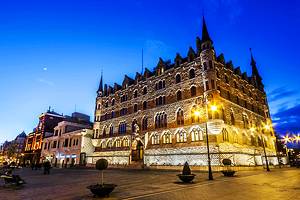
Exploring Northern Spain: Santiago de Compostela is a good base for exploring the attractions of northern Spain , such as the pre-Romanesque churches of Oviedo and the historic city of León. Another important stop along the Way of Saint James pilgrimage trail, León boasts an amazing Romanesque church and a remarkable Gothic cathedral.
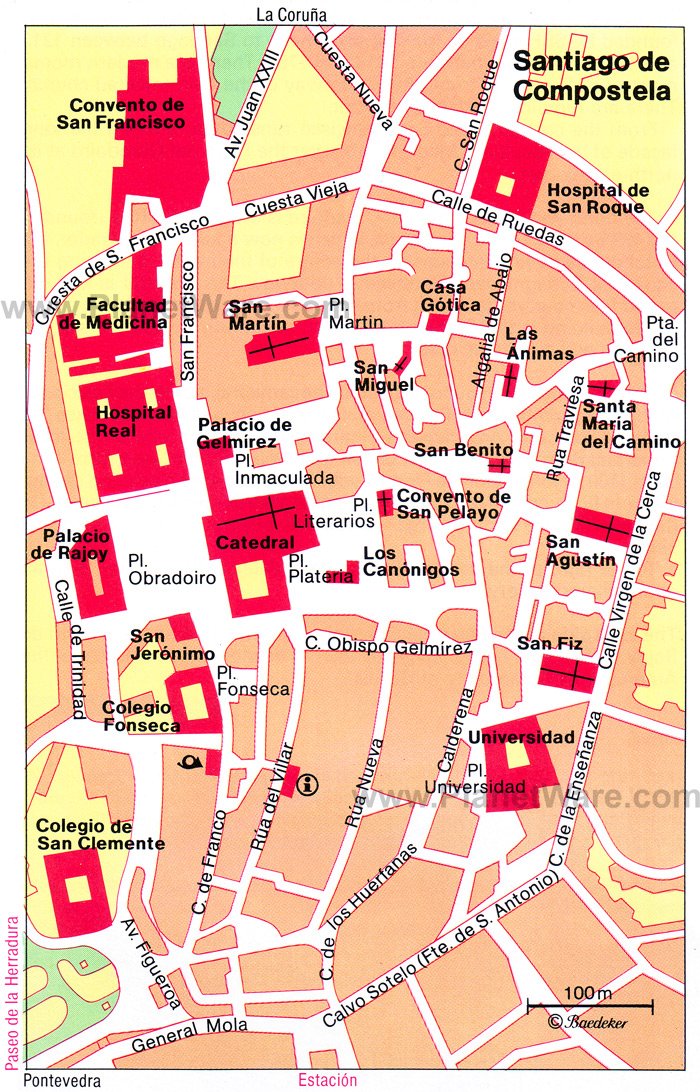
More on Spain

Travel Safe
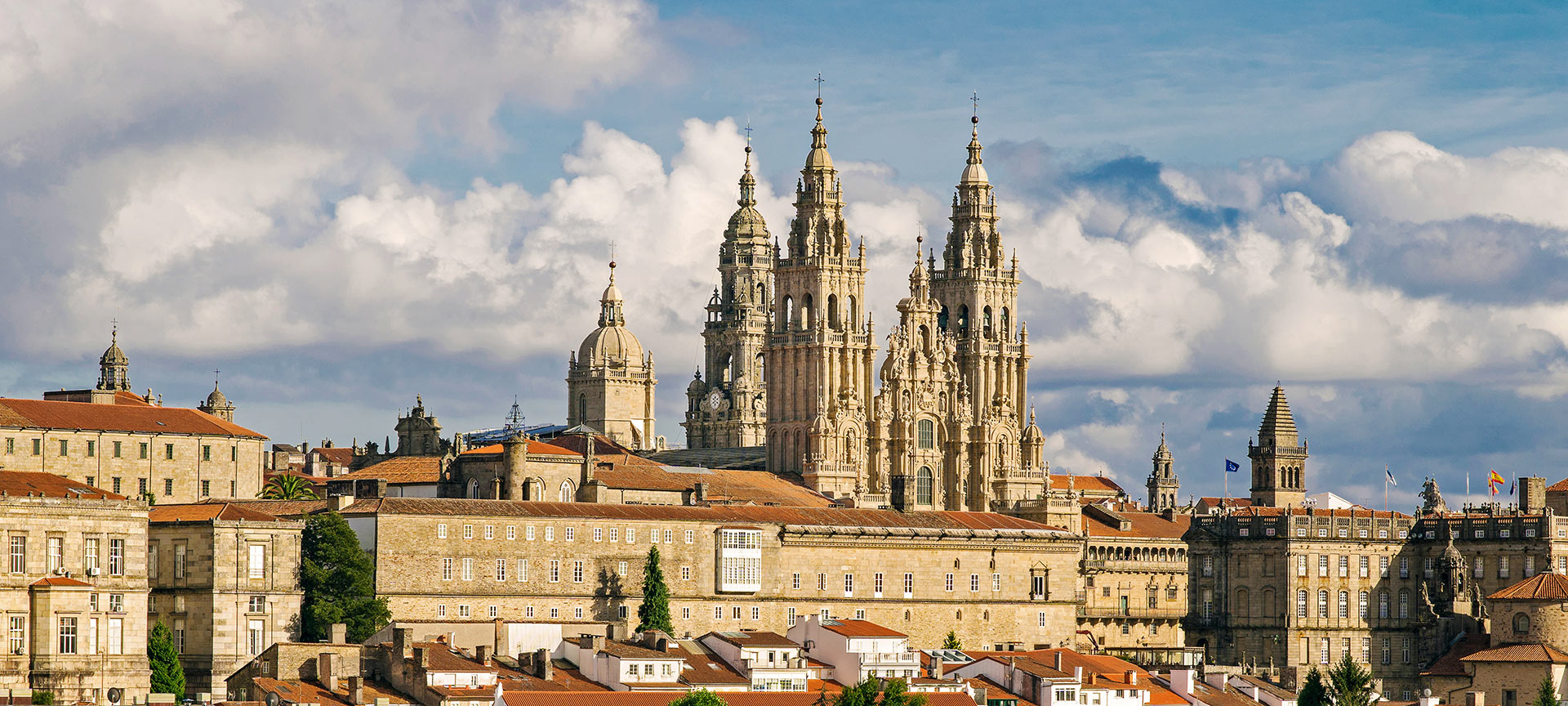
Santiago de Compostela
The final destination of St. James’ Way

What to visit
Select from the list or hover over the map to find out about points of interest.
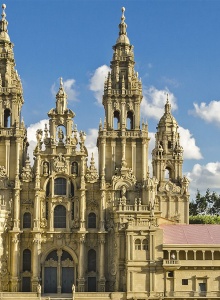
Santiago de Compostela Cathedral Museum

Casa do Cabildo house
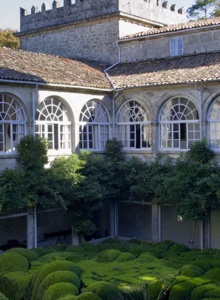
San Lorenzo de Trasouto
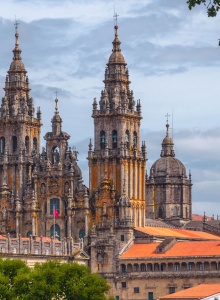
Santiago de Compostela Cathedral
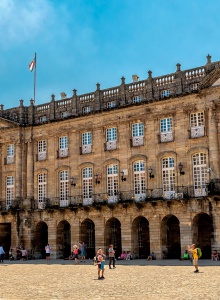
Raxoi Palace
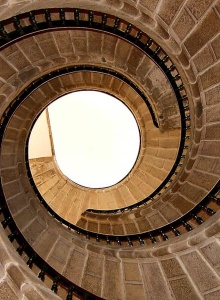
Museum of the Galician People
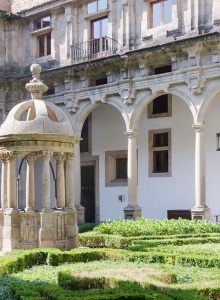
Hostal de los Reyes Católicos
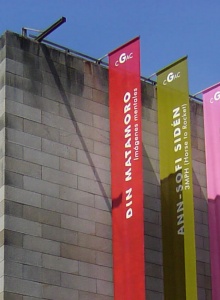
Galician Contemporary Art Centre (CGAC)
Other ideas for your trip
A day of culture in Santiago de Compostela
Thousands of people flock to Santiago de Compostela with a single desire: to discover the Cathedral, the end point of the Camino de Santiago.…
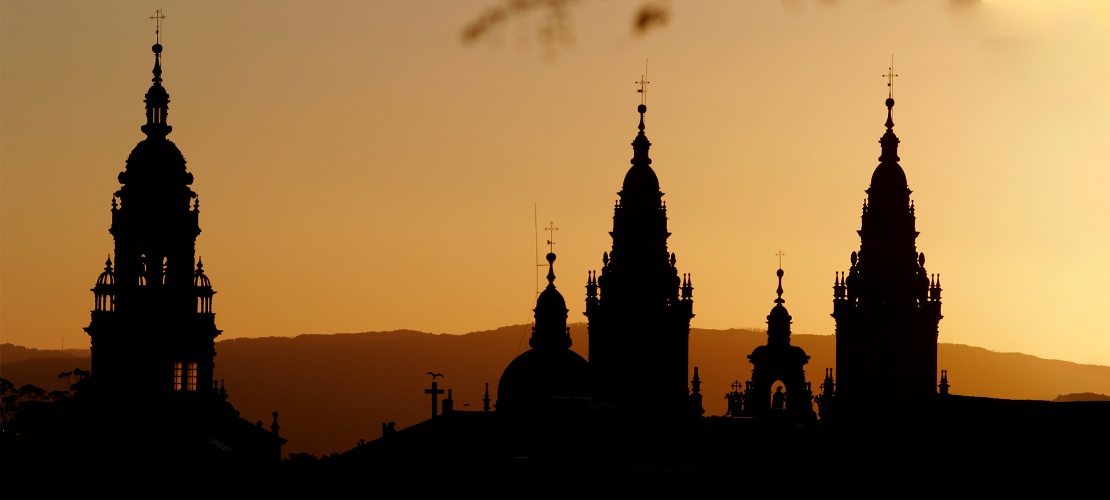
French Route
From the Pyrenees to Santiago de Compostela, the French Way passes through the regions of Aragón, Navarre, La Rioja, Castile and Leon, and Galicia on a route…
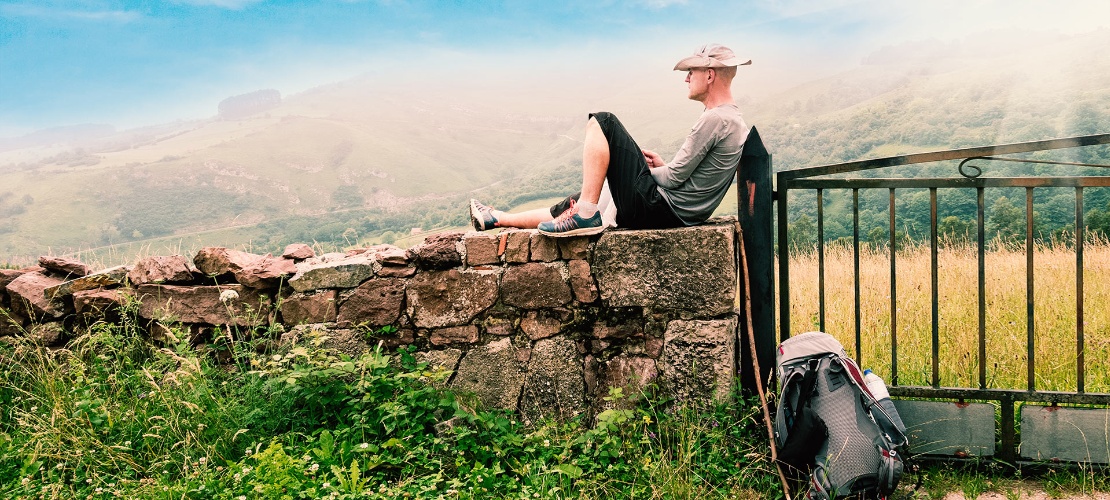
Santiago de Compostela, destination for a couple’s getaway
Santiago de Compostela, in the region of Galicia (northern Spain) is well-known for the lively atmosphere of its pretty cobbled streets, full of pilgrims and…
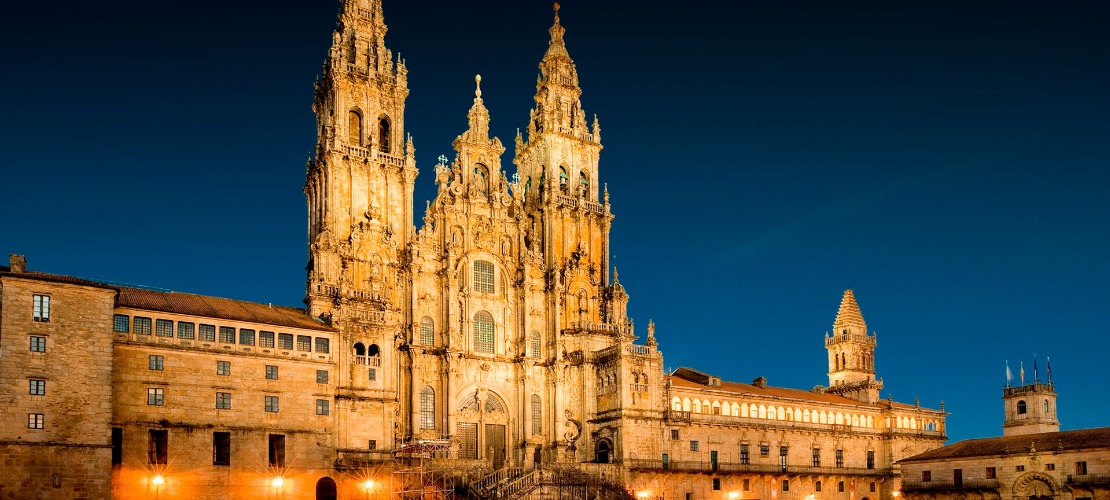
Discovering the unknown heritage of Galicia
Galicia is usually associated with monumental sites like Santiago de Compostela Cathedral or the Tower of Hercules, and beaches like Las Catedrales.…
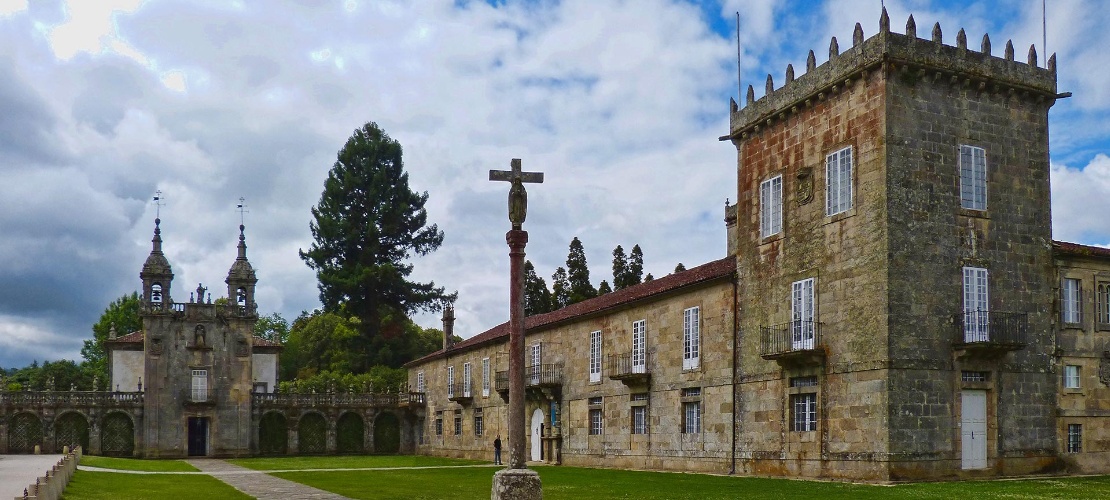
Spain’s most popular stops along The Way of Saint James
Among the many routes of The Way of Saint James, there’s one which lets you discover the north of Spain in a different way.…

From the Pyrenees to Santiago de Compostela, the French Way…
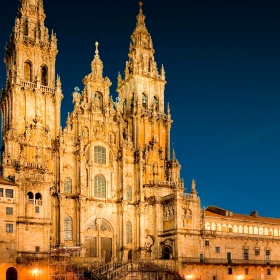
Santiago de Compostela, in the region of Galicia (northern Spain)…
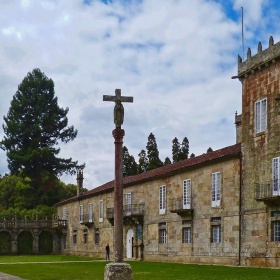
Galicia is usually associated with monumental sites like Santiago…

Among the many routes of The Way of Saint James, there’s one…
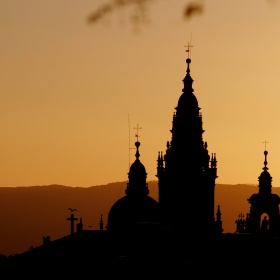
Thousands of people flock to Santiago de Compostela with a single…
How to get there - transport information
Select the means of transport to see how to get there or how to get around at your destination.
How to get to aeroplane
Santiago Airport is 10 kilometres outside the city.
There are taxis and bus services between the airport and the city. The bus service runs from the airport to Plaza de Galicia, with stops at the Pazo de Congresos, Capilla San Lázaro and the bus and coach station.
Bus to the city centre: 30 minutes.
Car to the city centre: Approximately 15 minutes on the N-634.
More information
How to get to train
Trains run from Santiago de Compostela Railway Station to Madrid, San Sebastián, Hendaye and Barcelona.
You can also change trains to reach Bilbao, Portugal and Paris. Book tickets
The No. 6 bus from Plaza de Galicia goes to the station.
The Transcantábrico, a luxury tourist train, travels slowly through northern, Green Spain to Santiago de Compostela. More information
How to get to bus
Coaches run from Santiago de Compostela bus and coach station to countries including Portugal, Germany, Belgium, France, Switzerland, the Netherlands and Romania.
Coaches also leave every hour for other towns in Galicia, like Vigo, Pontevedra and A Coruña.
How to get there by road
The A-6 and A-52 motorways connect Galicia to the rest of Spain and link to Santiago via the AP-9.
The A-8 motorway connects Galicia and France via the Cantabrian coast.
How to get around in bus
Over 20 city bus routes connect every part of the city. More information.
The No. 5 bus from Plaza de Galicia goes to the coach and bus station.
How to get around in train
The tourist train (actually a type of bus) starts from Plaza del Obradoiro and tours the whole historic quarter.
How to get around in other means of transport
By taxi . Find information here on how to contact the 24-hour teletaxi service.
Vehicle rental .
Excursions to nearby destinations
The village of Combarro is located in the Rías Baixas estuaries, six kilome...
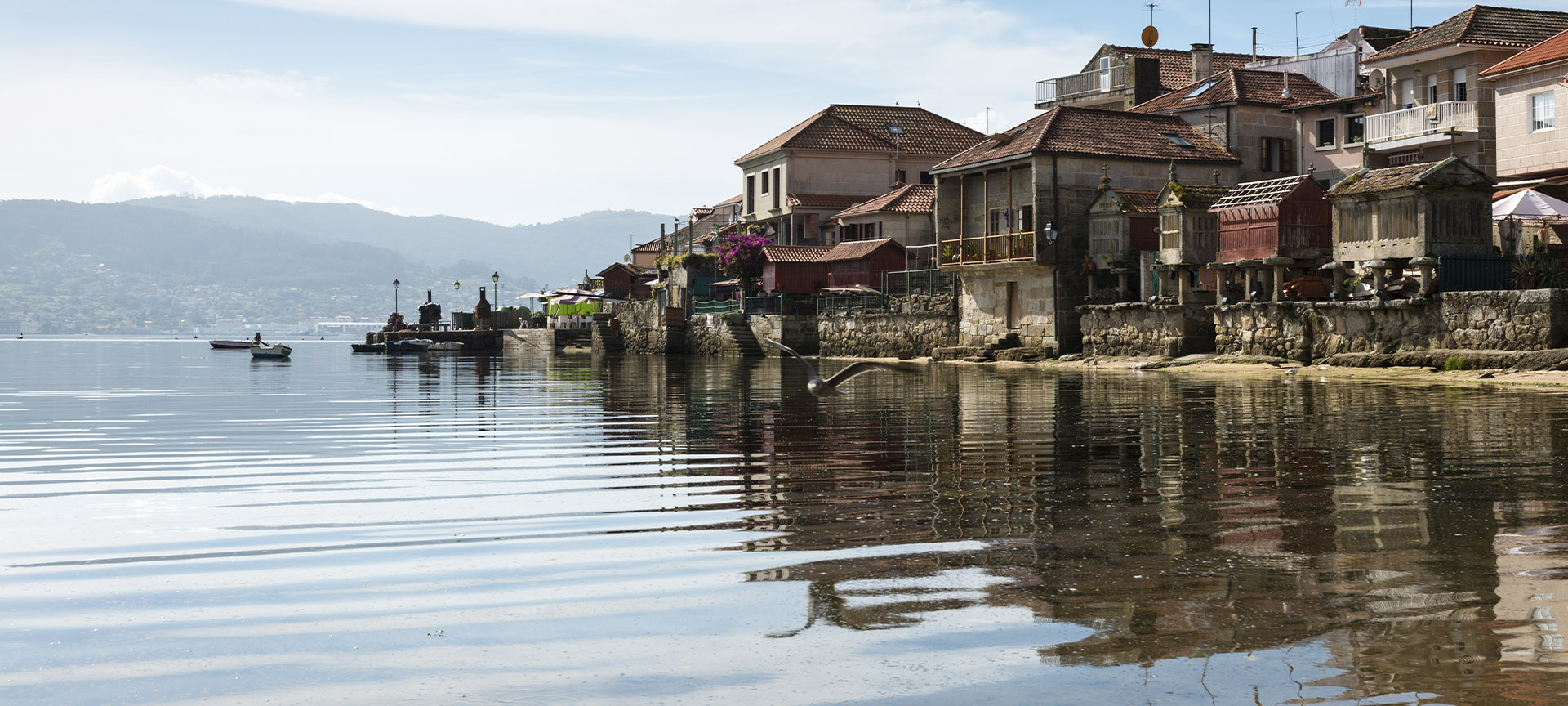
No-one questions the fact that Sanxenxo holds the honorary title of tourism...
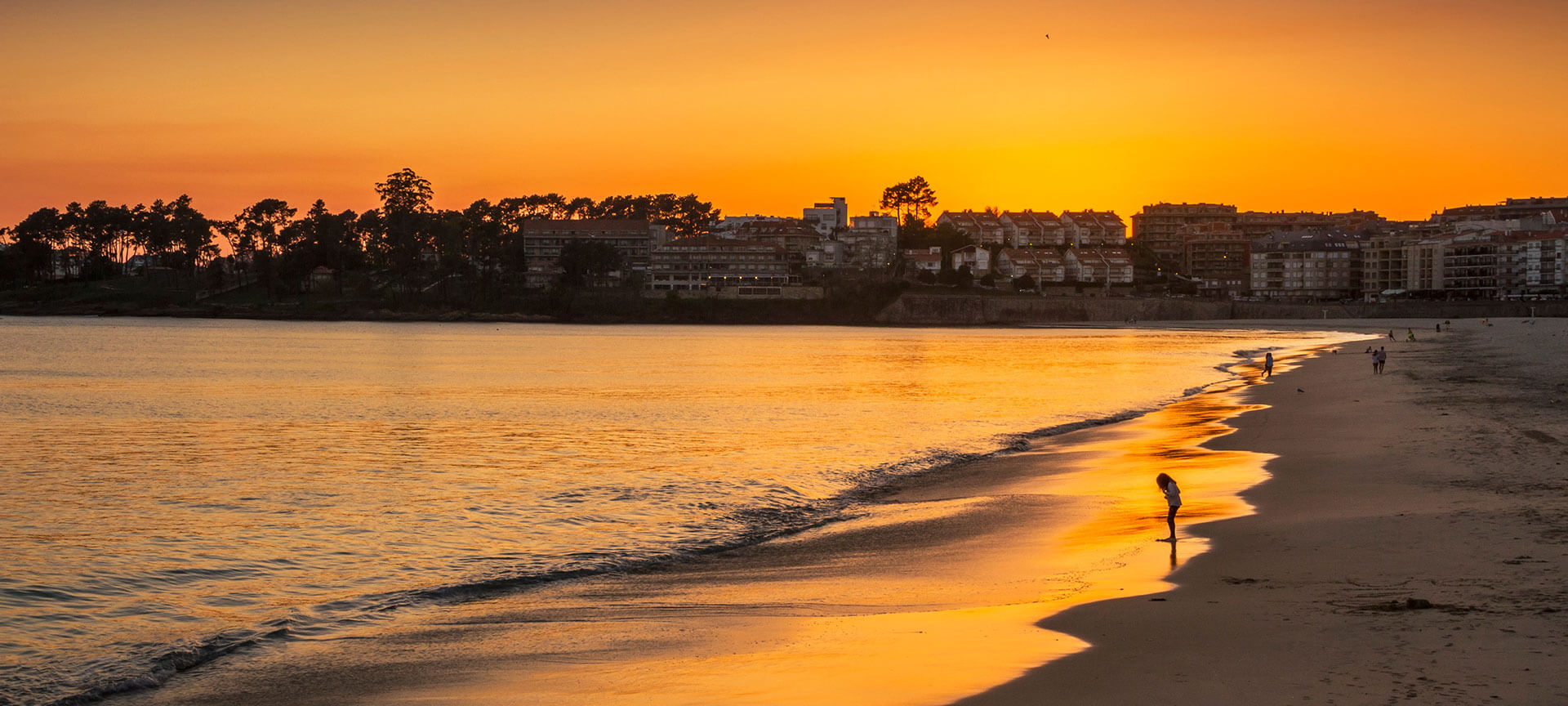
In the Galician province of Pontevedra, situated on the shores of the Atlan...
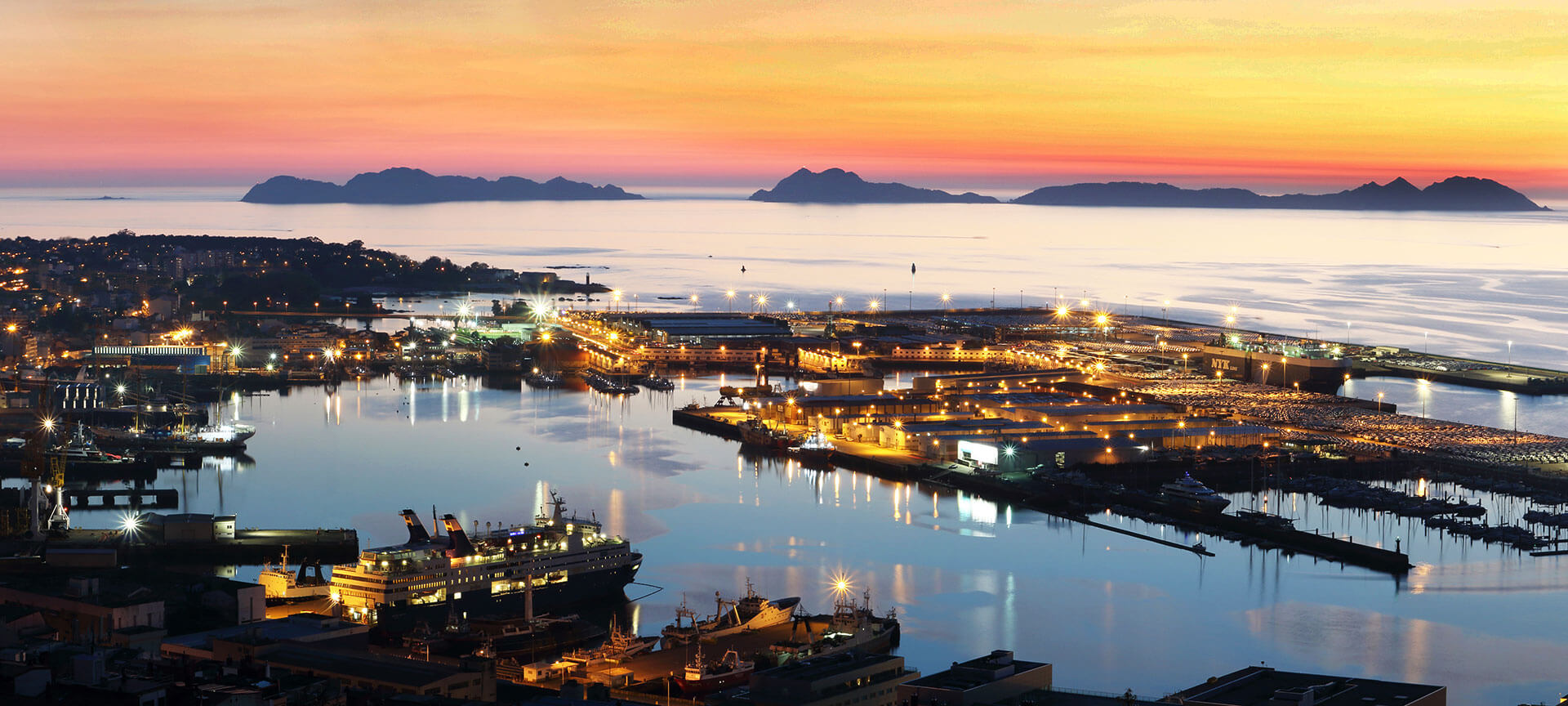
Stretching out on the banks of the river Miño is the city of Ourense, which...
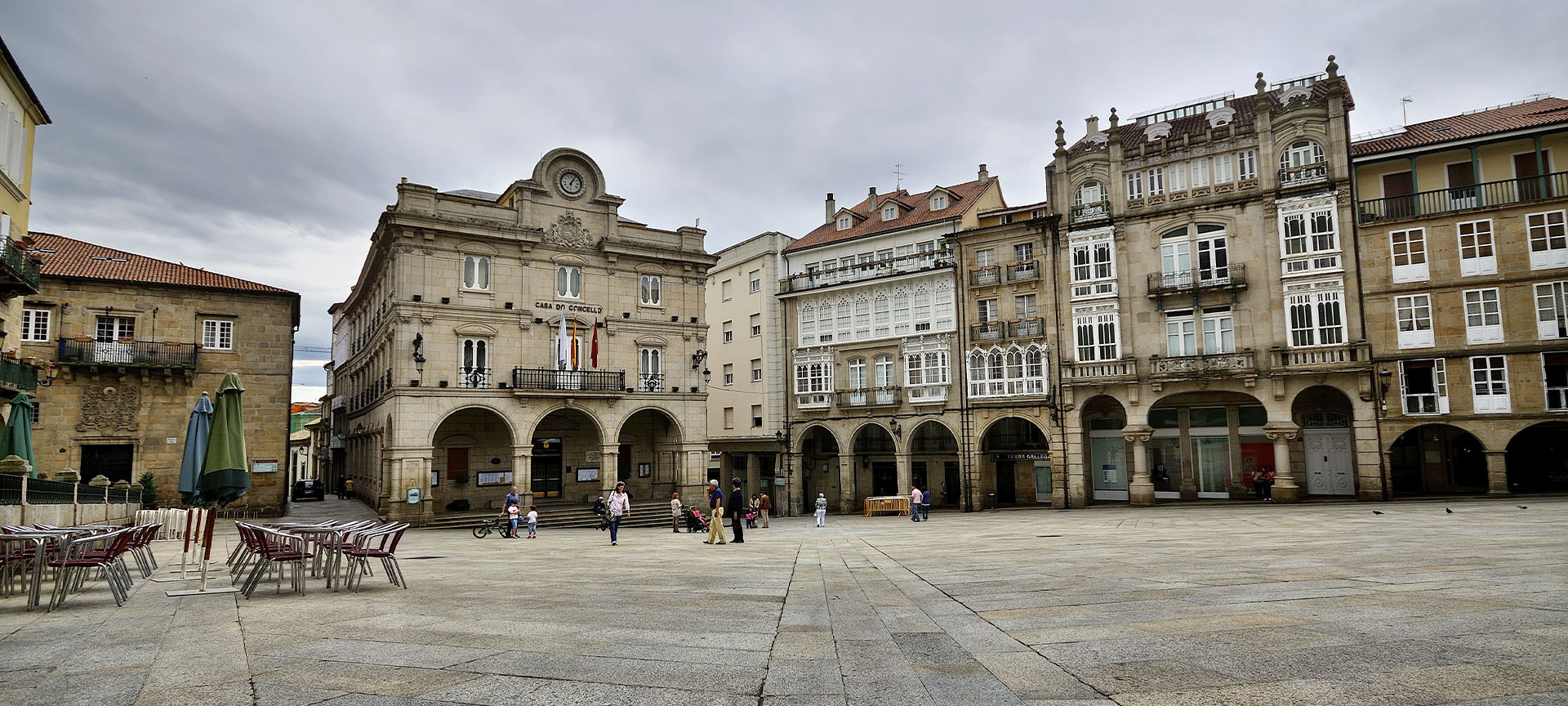
Facing the Atlantic Ocean, A Coruña is a city whose history is closely inte...
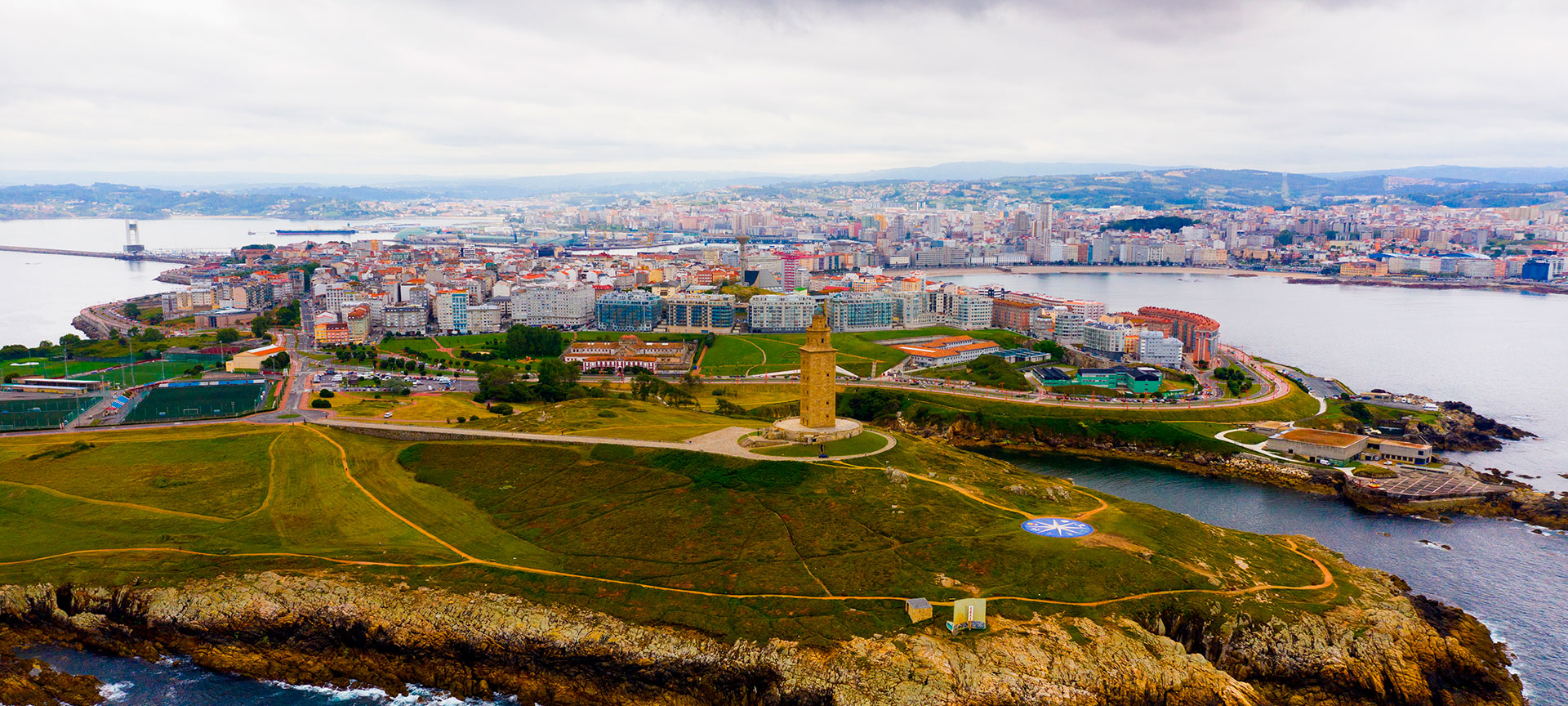
Shows, festivals, sports...
View some of the most relevant events you will be able to enjoy at the destination.
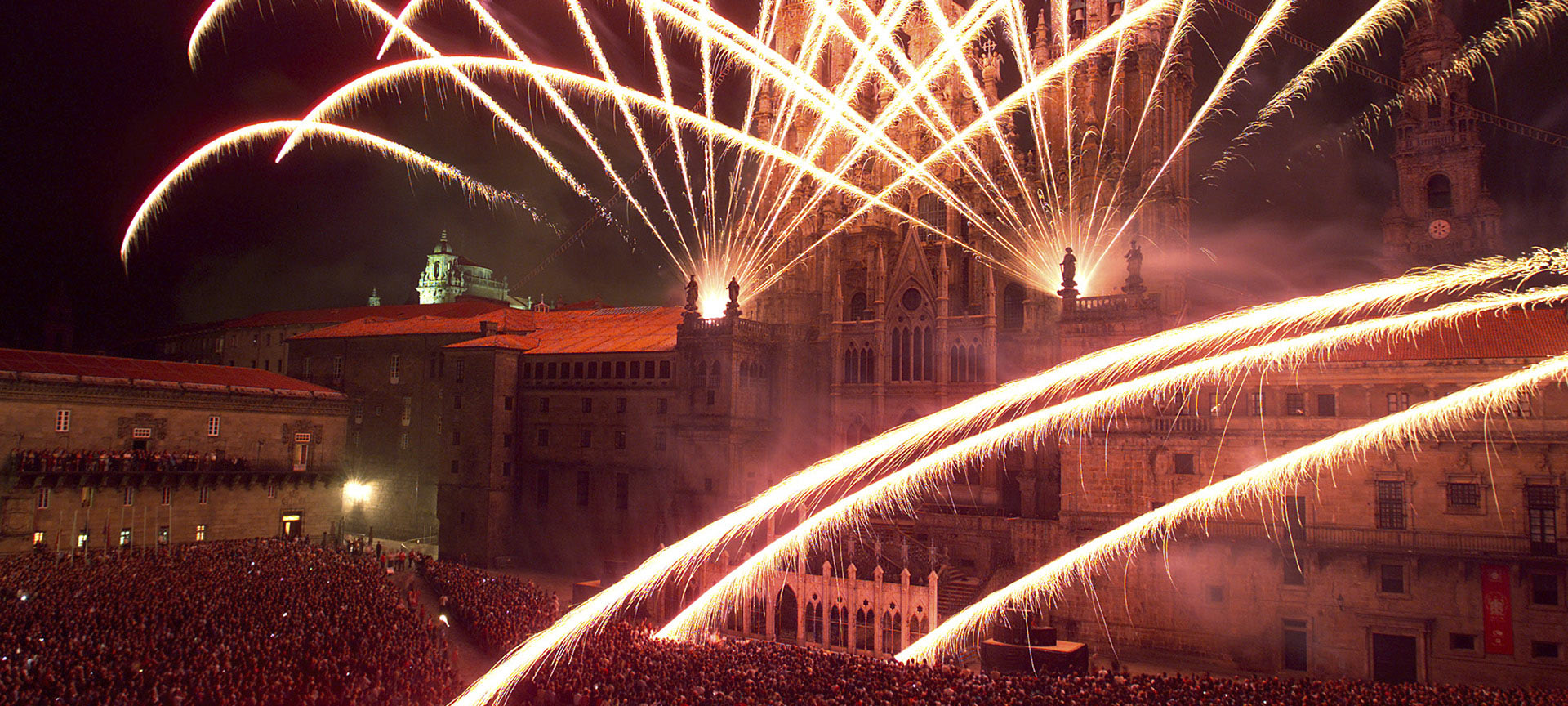
Festivities in honour of Santiago Apóstol
24 July 2024 - 25 July 2024
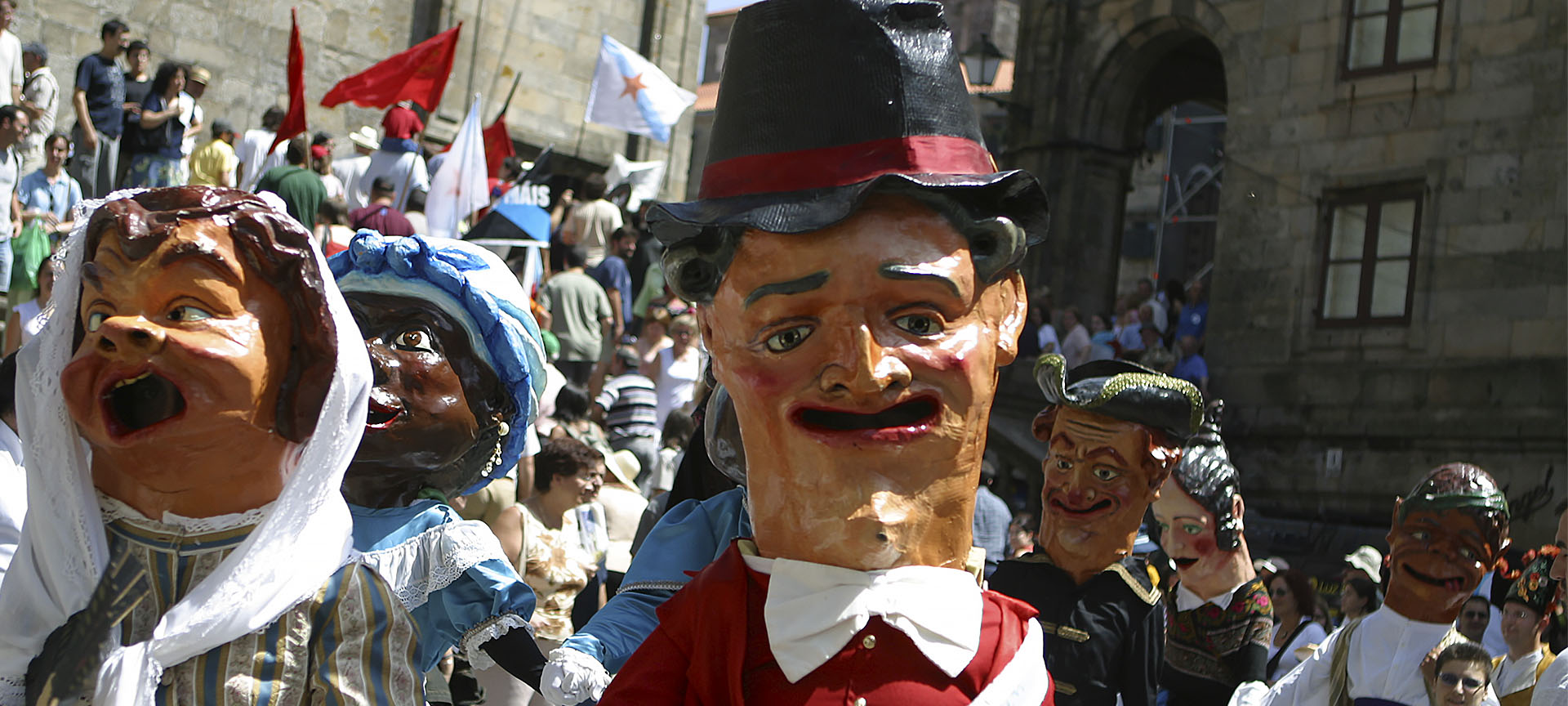
The Ascensión Festivities
08 May 2024 - 12 May 2024

Santiago (é) Tapas

Choose between thousands of activities to live your best life on holiday.

- 20 Must Visit Attractions In...
20 Must-Visit Attractions in Santiago De Compostela

Santiago de Compostela may be small, but it’s brimming with historic buildings, stunning architecture, museums, monasteries and luxury hotels. Here’s our pick for the top 20 must-visit attractions in this Galician city.
1. catedral de santiago de compostela.
The Santiago de Compostela Cathedral is without a doubt the city’s most famous sight – the culmination of various pilgrimage routes across Spain and Portugal. Construction of the Cathedral began in 1075; however, it wasn’t consecrated until 1211. It comprises multiple architectural styles including Romanesque, Gothic, Baroque, Plateresque and Neoclassical. When inside, look out for the Botafumeiro – one of the largest censers in the world, weighing 53 kilograms (117 pounds) and measuring 1.5 metres (4.9 feet).
Catedral de Santiago de Compostela, Praza do Obradoiro, Santiago de Compostela, Spain , +34 981 58 35 48

Santiago de Compostela, Spain | © bernavazqueze / Flickr
2. Museo de la Catedral de Santiago de Compostela
Cathedral, Church, Museum

To learn more about the Cathedral, head next door to the Cathedral Museum . Here you’ll find out how a small tomb and church became one of the world’s most famous and most impressive cathedrals. Marvel at objects, which date from the 13th to the 18th centuries, from the cathedral, and view its collection of textiles and tapestries.
Museo de la Catedral de Santiago de Compostela, Praza do Obradoiro, Santiago de Compostela, Spain , +34 881 55 79 45

Santiago de Compostela Cathedral | © Elentir / Flickr
3. Centro Galego de Arte Contemporáneo

The Galician Centre for Contemporary Art is the place for Galician art, and it also offers one of the best views of the city. It sits in a modern building, designed by the Portuguese architect Álvaro Siza. Its permanent collection houses 1,200 pieces, and there are also changing temporary exhibitions to see.
Centro Galego de Arte Contemporáneo, Rúa Valle Inclán, 2, Santiago de Compostela, Spain , +34 981 54 66 19

Centro Galego de Arte Contemporánea | © Kippelboy / WikiCommons
5. Hostal dos Reis Católicos

The Catholic Monarchs commissioned the Hostal dos Reis Católicos – which sits on Praza do Obradoiro square, next to the Cathedral – in 1501 as a hospital for sick pilgrims who walked the Camino de Santiago. Today, the building serves as one of the most luxurious Parador hotels in Spain – the five-star Hotel Parador .
Hostal dos Reis Católicos, Hotel Parador, Praza do Obradoiro, 1, Santiago de Compostela, Spain , +34 981 58 22 00

Hostal dos Reis Católicos, Santiago de Compostela | ©Angel Torres / Flickr | ©Angel Torres/Flickr
6. Museo de las Peregrinaciones y de Santiago
Santiago de Compostela is most famous for being the last stop on the Camino de Santiago, so why not find out all about it at the Museum of Pilgrims and Santiago ? Housed in the old Banco de España building, it was redesigned by award-winning architect Manuel Gallego Jorreto and reopened as a museum dedicated to the city and its famous pilgrimage route in 2012.
Museo de las Peregrinaciones y de Santiago, Rúa da Fonte de San Miguel, 4, Santiago de Compostela, Spain , +34 981 58 15 58

Pilgrim and Santiago Museum, Santiago de Compostela | © Nemigo / WikiCommons | © Nemigo/WikiCommons
7. Restaurante Pulpería Fuentes
You can’t visit Galicia without trying its most famous regional dish – pulpo a la Gallego or Galician-style octopus. The octopus is boiled and then chopped up into small chunks, served on a layer of potatoes and sprinkled with paprika. One of the best places to try this dish in Santiago is the traditional Restaurante Pulpería Fuentes .
Restaurante Pulpería Fuentes, Rúa do Campo de Conxo, 5, Santiago de Compostela, Spain , +34 981 52 10 07

Pulpo a la Gallega, Galicia | © Javier Lastras / WikiCommons | ©Javier Lastras / Flickr
8. Museo do Pobo Galego
Housed inside the old Convento de Santo Domingo de Bonaval, built in the 14th century, the Museum of Galician People is dedicated to the preservation and promotion of Galician culture. It houses 11,500 items, including art, archaeological and agricultural objects, costumes, jewellery and musical instruments. Museo de Pobo Galego, San Domingos de Bonaval, Santiago de Compostela, Spain , +34 981 58 36 20

Convento de San Domingos de Bonaval, Santiago de Compostela | © juantiagues / Flickr
9. Cidade da Cultura de Galicia

The City of Galician Culture sits on the outer edge of Santiago de Compostela and measures about the same size as the city’s Casco Historico. The building, designed by American architect Peter Eisenman, winner of a design competition, features lots of undulating roofs and leaning towers. Although the project ran out of funding and was never properly finished, it does house a library, an opera house, a museum and spaces for various cultural events.
Cidade da Cultura de Galicia, Monte Gaiás, Santiago de Compostela, Spain , +34 881 99 75 65

Cidade da Cultura, Santiago de Compostela, Galicia | © Luis Miguel Bugallo Sánchez / WikiCommons | © Luis Miguel Bugallo Sánchez/WikiCommons
10. Museo Casa de la Troya
The Museum of the House of Troya is the museum of the famous boarding house, run by Doña Generosa at the end of the 19th century and written about by the writer Alejandro Pérez Lugín in his novel La Casa de la Troya . The house is set up exactly how it was in Lugín’s time and features photographs, books and objects belonging to the writer.
Museo Cada de la Troya, Rúa da Troia, 5, Santiago de Compostela, Spain , +34 981 58 51 59
11. Monasterio de San Martín Pinario

A group of Benedictine monks founded the Monastery of San Martín Pinario in the 10th century, after the discovery of the remains of Saint James. Baroque in style, today it’s a church-museum, which also houses temporary exhibitions.
Monasterio de San Martín Pinario, Praza da Inmaculada, 5, Santiago de Compostela, Spain , +34 981 58 30 08

Monasterio de San Martín, Santiago de Compostela | © Diego Delso / WikiCommons
12. Plaza de las Platerías

Platerías Square sits south of the Cathedral. It was named after the silversmith ( plata is silver in Spanish) workshops, which used to be located here under the arches. The Cathedral’s single Romanesque façade, the Casa del Cabildo and the Casa del Deán – an 18th-century palace-house – borders the square. In its centre sits the Fuente de los Caballos (Fountain of the Horses). Plaza de las Platerías, Santiago de Compostela, Spain

Plaza de las Platerías, Santiago de Compostela | © Diego Delso / WikiCommons
13. Parque de la Alameda
The most spectacular park in Santiago de Compostela is the Parque de la Alameda, which features graceful stairs, fountains and manicured lawns. It was originally created in the 16th century; however, many of the elements you can see today were made in the 19th century.
Parque de la Alameda, Paseo Central de Alameda, Santiago de Compostela, Spain , +34 650 12 55 89

Alameda Park, Santiago de Compostela, Spain | © Diego Delso / WikiCommons
14. Mosteiro de San Paio de Antealtares
Monastery, Museum
The Monastery of San Paio de Antealtares was originally built in the 11th century to house Benedictine monks; however, it was virtually destroyed years later and rebuilt during the 17th and 18th centuries. Today, it houses the Museo de Arte Sacra – the Museum of Sacred Art, where you can see objects such as the original altar that was above St. James’ tomb and the silver reliquary where St. Palayo’s arm is kept.
Mosteiro de San Paio de Antealtares, Rúa de San Paio de Antealtares, 23, Santiago de Compostela, Spain , +34 981 56 06 23

San Pelayo de Antealtares Monastery | © José Luis Filpo Cabana / WikiCommons
15. Fundación Eugenio Granell
The Foundation of Eugenio Granell is dedicated to the surrealist artist Eugenio Granell, who was born in A Coruña and lived in Santiago de Compostela during his childhood. The museum features the artist’s oil paintings, sculptures, drawings and collages, as well as pieces from some of his contemporaries, such as Miró, Caballero, Copley, Rodríguez Luna and Duchamp.
Fundación Eugenio Granell, Praza do Toural, 8, Santiago de Compostela, Spain , +34 981 57 21 24

Museo Granell, Santiago de Compostela | © Luis Miguel Bugallo Sánchez / WikiCommons
16. Pazo de Xelmírez

The Palace of Xelmírez is a beautiful 12th-century Romanesque building, which was once the Bishop’s Palace and commissioned by the Archbishop Diego Xelmírez. Inside, you can see an old medieval kitchen and the 13th-century dining hall used for meals.
Pazo de Xelmírez, Praza do Obradoiro, Santiago de Compostela, Spain

Pazo de Xelmírez, Santiago de Compostela, Spain | © Luis Miguel Bugallo Sánchez (Lmbuga) / WikiCommons
17. Museo de Tierra Santa
The Museum of the Holy Land sits inside the Hotel Monumento San Francisco, which, in turn, is housed inside the old San Francisco monastery. It houses around 700 pieces from the Paleolithic era to the present – artefacts all brought from Jerusalem in the Holy Land. There’s everything here from ornaments and carvings to military objects, models and ceramics.
Museo de Tierra Santa, Hotel Monumento San Francisco Campillo de San Francisco, 3, Santiago de Compostela, Spain , +34 981 58 16 34

Hotel Monumento San Francisco, Santiago de Compostela | © Hotel Monumento San Francisco
18. USC: Museo de Historia Natural
Santiago’s Museum of Natural History is part of the University area and lies within an innovative building designed by César Portela. The structure, built as a series of cubes, has various rooms dedicated to natural sciences, including a soil room, an African savannah room and a South American jungle room.
USC: Museo de Historia Natural, Parque Vista Alegre, Santiago de Compostela, Spain , +34 881 81 63 50

Santiago de Compostela University, Spain | © largo Pillado / WikiCommons
19. Museo da Colexiata do Sar
Church, Museum
The Collegiate Church of Sar’s Museum is a small museum housed in the Romanesque Church of Santa María de Sar. It houses a number of important historical documents, gold and silver items from the 18th century and a series of pieces from the old Romanesque cloister.
Museo da Colexiata do Sar, Rúa de Sar, Santiago de Compostela, Spain , +34 981 57 22 89

Colegiata de Santa Maria de Sar, Santiago de Compostela | © José Antonio Gil Martínez / Flickr
Casco Historico
Lastly, you simply can’t miss a meander around Santiago’s Old Town, filled with its charming winding alleyways, cobbled streets, delicious tapas bars and souvenir shops. Take a look at our article on the ‘ Best Shops in Old Town Santiago de Compostela ’ for some ideas of places to go.

Since you are here, we would like to share our vision for the future of travel - and the direction Culture Trip is moving in.
Culture Trip launched in 2011 with a simple yet passionate mission: to inspire people to go beyond their boundaries and experience what makes a place, its people and its culture special and meaningful — and this is still in our DNA today. We are proud that, for more than a decade, millions like you have trusted our award-winning recommendations by people who deeply understand what makes certain places and communities so special.
Increasingly we believe the world needs more meaningful, real-life connections between curious travellers keen to explore the world in a more responsible way. That is why we have intensively curated a collection of premium small-group trips as an invitation to meet and connect with new, like-minded people for once-in-a-lifetime experiences in three categories: Culture Trips, Rail Trips and Private Trips. Our Trips are suitable for both solo travelers, couples and friends who want to explore the world together.
Culture Trips are deeply immersive 5 to 16 days itineraries, that combine authentic local experiences, exciting activities and 4-5* accommodation to look forward to at the end of each day. Our Rail Trips are our most planet-friendly itineraries that invite you to take the scenic route, relax whilst getting under the skin of a destination. Our Private Trips are fully tailored itineraries, curated by our Travel Experts specifically for you, your friends or your family.
We know that many of you worry about the environmental impact of travel and are looking for ways of expanding horizons in ways that do minimal harm - and may even bring benefits. We are committed to go as far as possible in curating our trips with care for the planet. That is why all of our trips are flightless in destination, fully carbon offset - and we have ambitious plans to be net zero in the very near future.

Places to Stay
The best hotels to book in catalonia.

Guides & Tips
Reasons why you should visit andalucia, spain.

Reasons Why You Should Visit La Rioja, Spain

The Best Private Trips to Book for a Foodie Adventure

Top Tips for Travelling in Spain

The Most Unique Temples and Churches in the World

The Best Private Trips to Book for Your Spanish Class

The Best Hotels to Book in Salou, Catalonia

The Best Places to Travel in June

See & Do
Getting a taste of picasso in malaga.

Bars & Cafes
The best wine bars in la rioja, spain.

The Most Beautiful Train Stations in the World
Culture trip spring sale, save up to $1,100 on our unique small-group trips limited spots..

- Post ID: 1656356
- Sponsored? No
- View Payload

15 Best Things To Do in Santiago, Spain
Are you planning to travel to Santiago , Spain soon ? Read our tips below on the things to do in Santiago with suggested tours!

Santiago de Compostela is the capital of northwest Spain’s Galicia region. It is the home of the famous Camino de Santiago or the ‘Way of Saint James’ in English. It is a popular pilgrimage that leads you to the shrine of the apostle Saint James the Great. A lot of people follow their routes to retreat for their spiritual growth. However, you can also go hiking or cycling in this spiritual area. Organized tour groups are also available in case you’re interested in going to this place.
Of course, aside from the Camino de Santiago, Santiago also has a lot of beautiful and magnificent places that you should discover. Let’s all take a look at the places and things that you should try when you visit this wonderful city in Spain.
Other articles you can read:
- Weekend in Santiago, Spain: How to Spend 3 Days in Santiago, Spain
- 15 Best Things To Do in South Tenerife, Spain
- 10 Things to Do in Zaragoza, Spain [Plus a Sample Weekend Trip DIY Itinerary]
- 5 Tips on Visiting Casa Batllo in Barcelona, Spain
- 10 Reasons Why Almeria In South of Spain Is Worth A Visit
Table of Contents
15 Things that you should do and visit in Santiago, Spain
1. catedral de santiago de compostela.
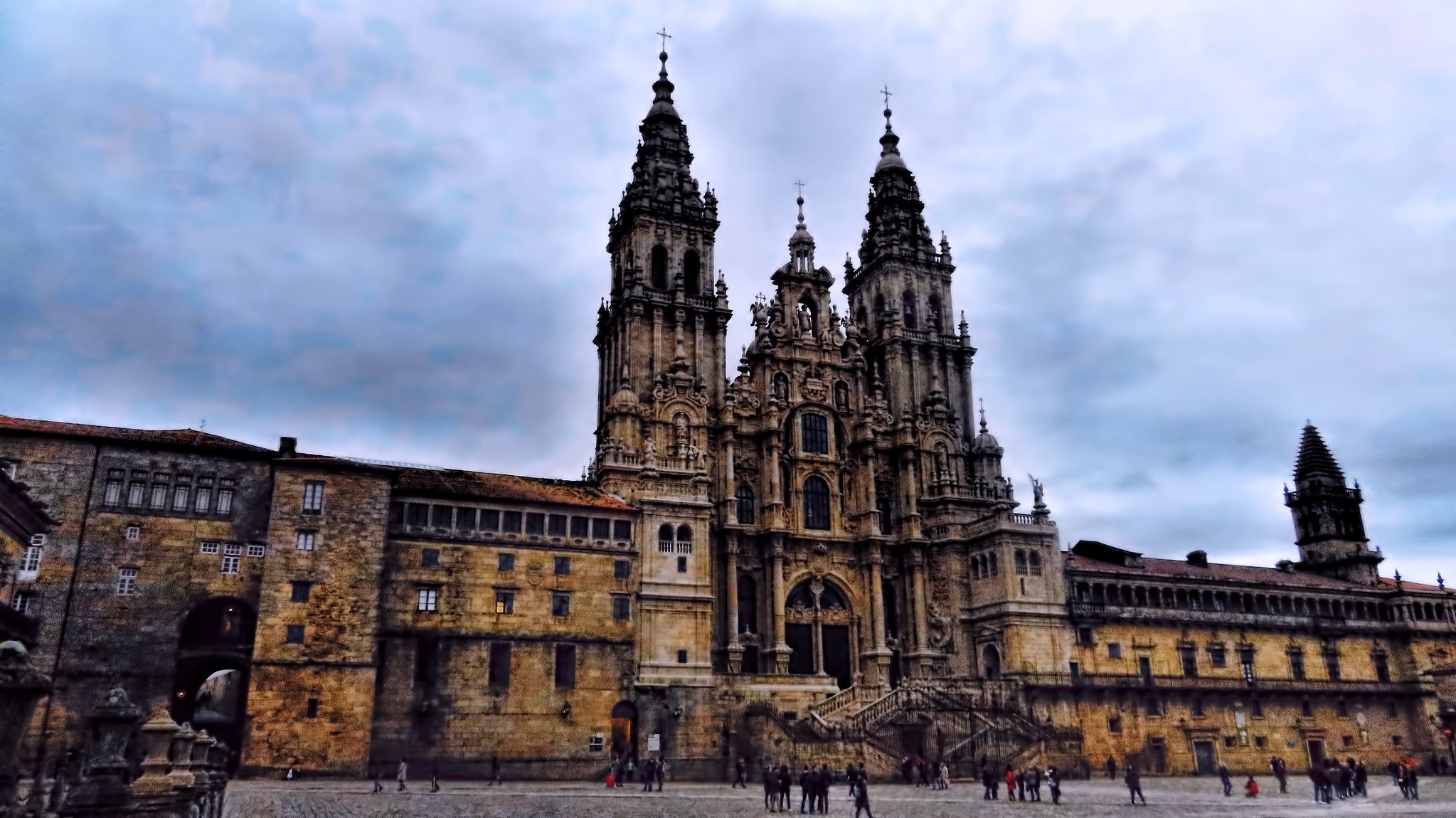
Catedral de Santiago de Compostela is a world heritage site in Galicia, Spain. It is believed to be the burial place of Saint James the Great, the apostle of Jesus Christ. Upon visiting this Catedral, you’d see a combination of the original Romanesque structure, then later added Gothic and baroque flourishes. It was constructed between 1075 until 1211.
Suggested Tour: Finisterre Day Trip from Santiago de Compostela
2. Hostal de Los Reyes Catolicos (or Hostal dos Reis Catolicos)
View this post on Instagram A post shared by ⚜️ORPHEUS⚜️ (@orpheus_ea) on Dec 18, 2019 at 6:14am PST
Hostal de Los Reyes Catolicos is not your ordinary 5-star hotel. It was constructed in 1486 as Religious works. It serves as a lodging place for pilgrims on their way to Camino de Santiago. To continue its purpose, it was renovated and now known as the luxurious hotel ‘Parador de Santiago’. It’s also considered as the oldest operating hotel in the world and the most beautiful hotel in Europe. Imagine seeing this stunning hotel as you visit Santiago.
3. Casco Antiguo (Old Town)
View this post on Instagram A post shared by @angelnarduzzi on Feb 11, 2018 at 12:09pm PST
One of the UNESCO World Heritage Sites. This street has a lot of cafes, restaurants, and boutiques. Travelers will surely enjoy walking in this place as they look at the awesome structure of unique buildings around the area.
4. Parque Alameda
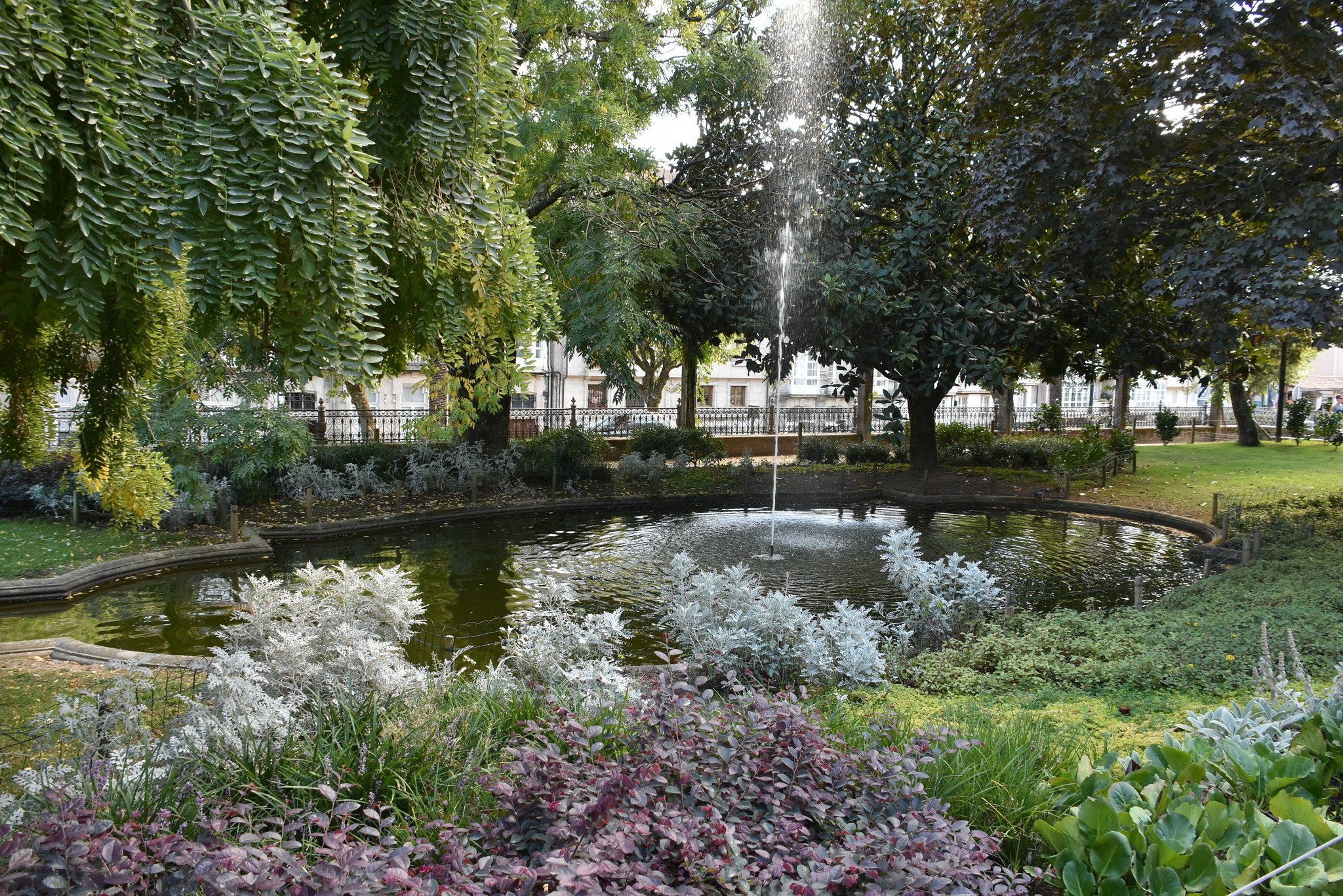
Parque Alameda or Alameda Park is Santiagos’ most popular park. It’s a 16th-century park that has historical monuments and a garden that features a lot of ornamental trees and shrubs. Furthermore, you won’t get bored as you stroll around this beautiful garden as you will see different monuments and plenty of statues.
5. Centro Galego de Arte Contemporanea
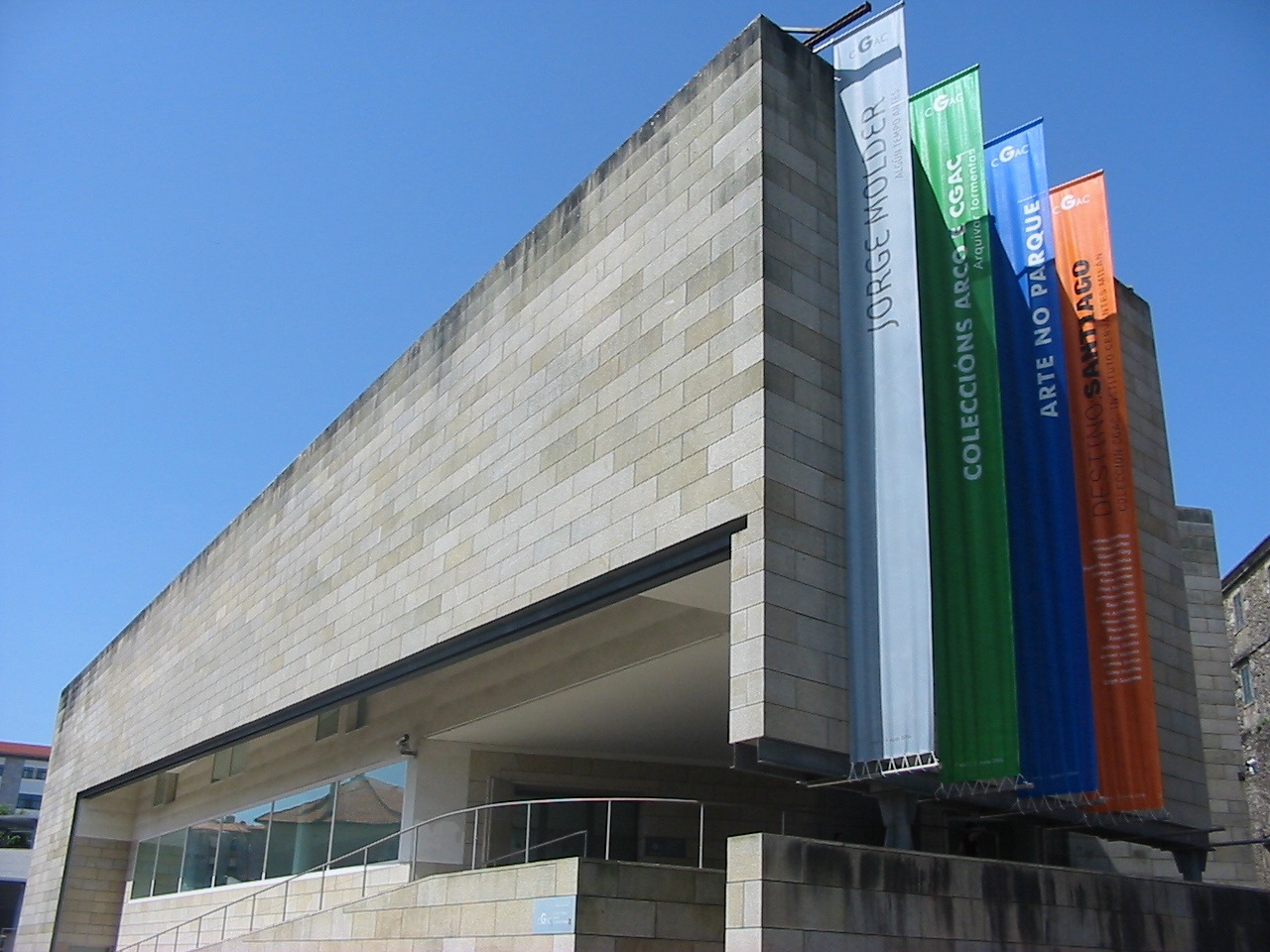
Centro Galego de Arte Contemporanea is a contemporary art gallery in Santiago de Compostela. You’d definitely enjoy seeing a number of contemporary arts. The building itself also has a magnificent architecture. Visitors won’t surely get bored as they walk through this place full of stunning arts.
6. Casa do Cabildo
View this post on Instagram A post shared by Kim Gabriel Hansen ??? (@kimghinstagram) on Jul 27, 2016 at 3:26pm PDT
Casa do Cabildo is a historic house in Galicia, Spain. It was built in 1758, in a baroque style that will make the visitors stunned. The building is also open to the public when there’s an art exhibition. So if you get lucky enough and there’s an art exhibit during your trip, don’t miss the chance!
7. Museo del Pueblo Gallego
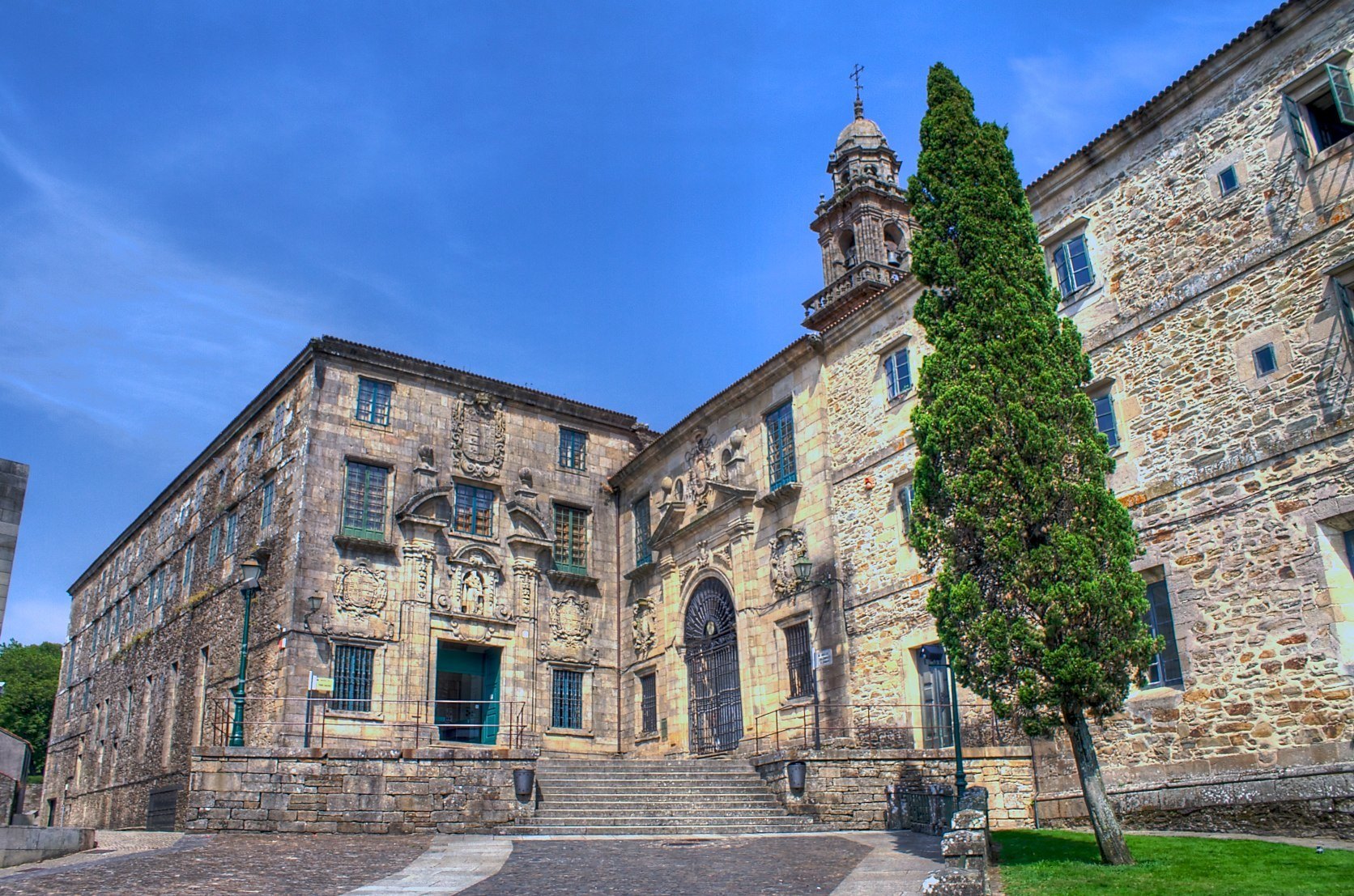
Museo del Pueblo Gallego opened in 1976. It features Galician’s culture and their relationship with the sea, the land and each other. In the exhibit, visitors would also see the evolution of Galician people, from prehistory through the modern-day.
8. Cidade da Cultura de Galicia
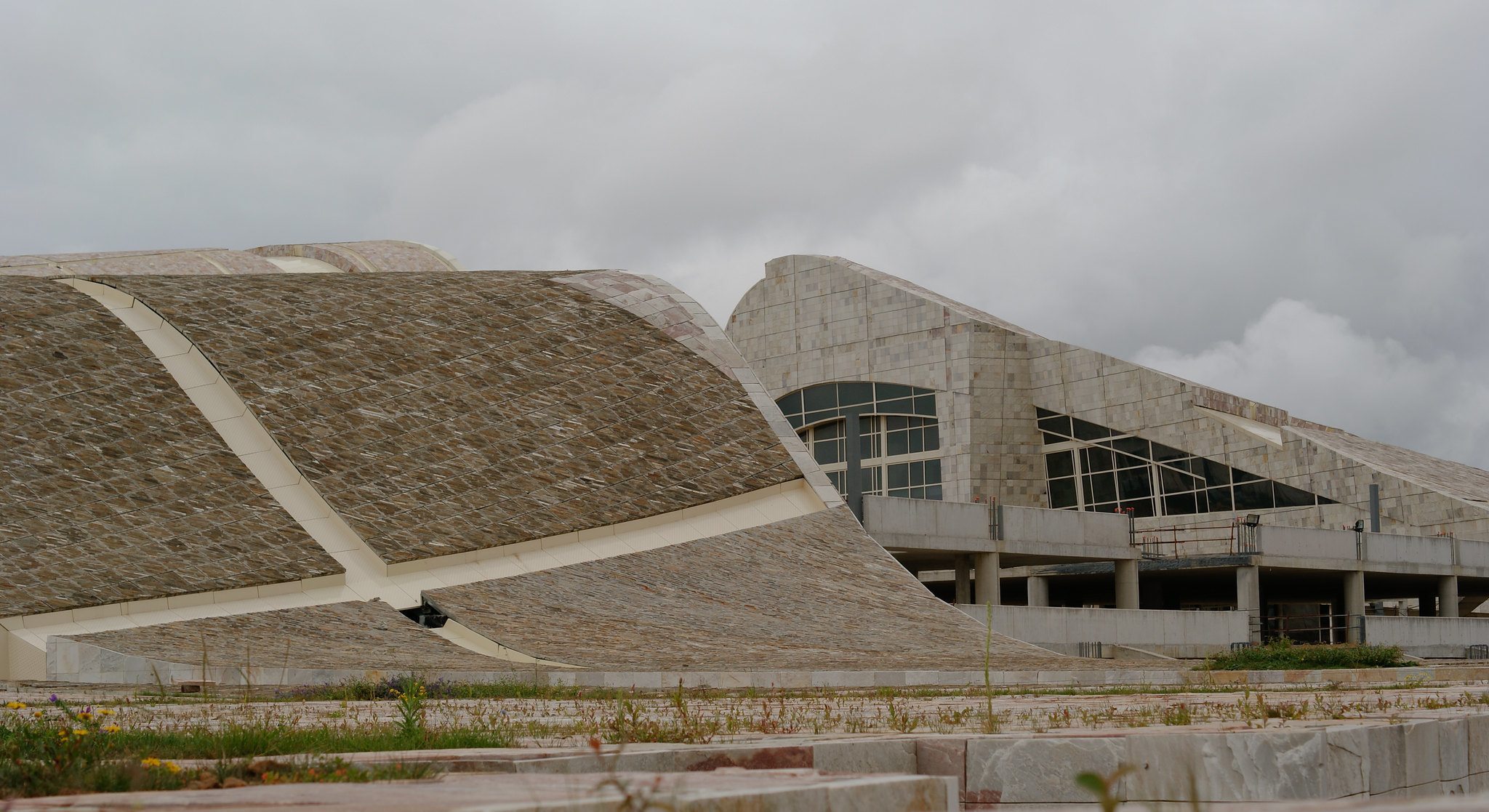
Cidade da Cultura de Galicia or the City of Culture of Galicia is a cultural building in Santiago de Compostela, Spain. Peter Eisenman designed it. The building itself is such a beautiful sight to see! It also looks like rolling hills. You shouldn’t miss this one.
9. Colegiata de Santa Maria la Real de Sar
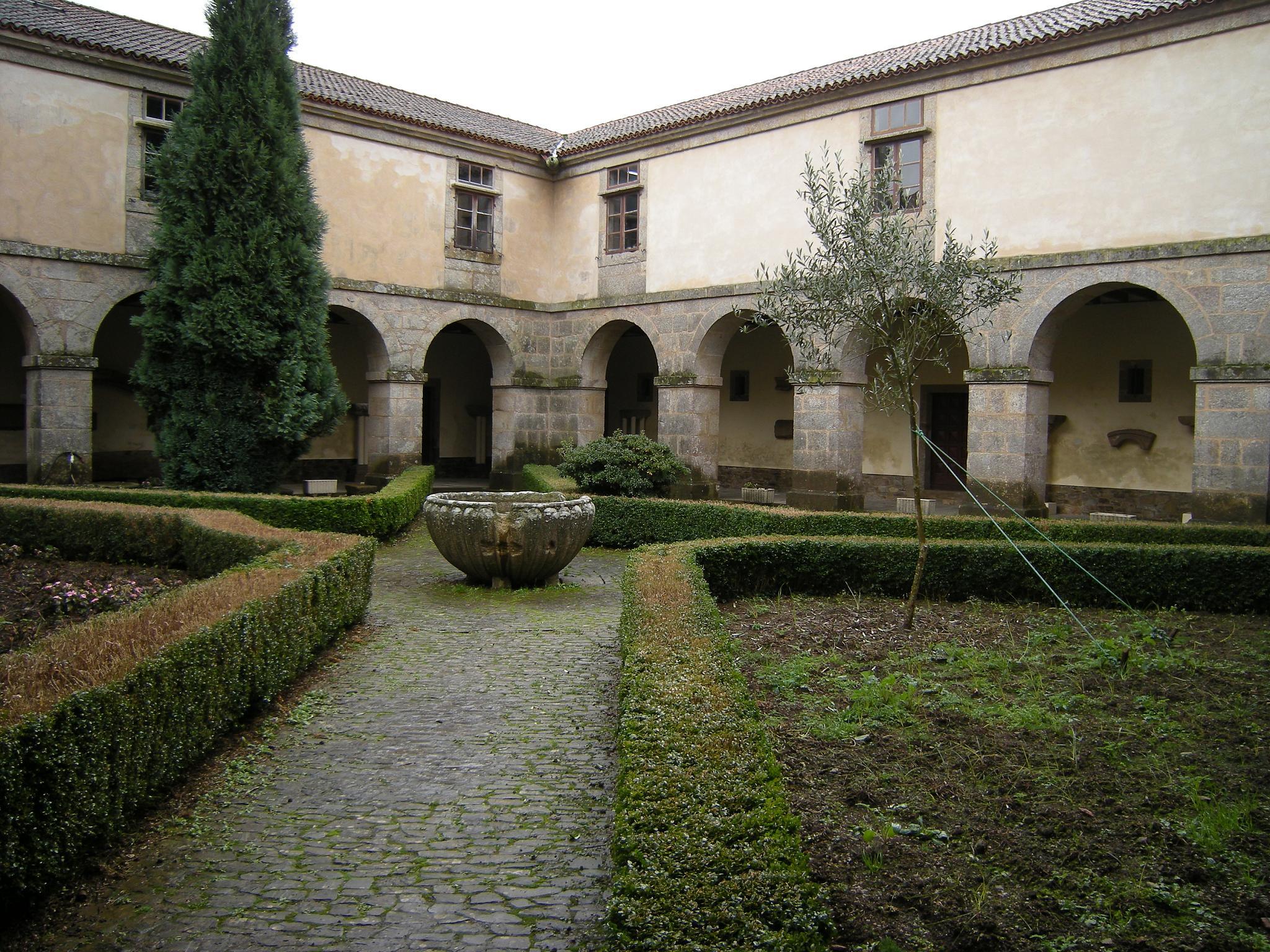
Colegiata de Santa Maria la Real de Sar or the Church of Santa Maria a Real de Sar is a church located in Santiago de Compostela, Spain. It is a typical Romanesque Church, the interior of the church will make you stunned as it is illuminated by a rose window. It also has a peaceful garden that you really make you feel relaxed.
10. Camino de Santiago
View this post on Instagram A post shared by Alexander (@jakobsweg_caminodesantiago) on Dec 3, 2019 at 12:53am PST
Camino de Santiago is a famous pilgrimage in Santiago de Compostela, Spain. You can go hiking or cycling here. Pilgrims go on for a walk with the goal of reaching the Saint’s tomb in Santiago. However, walking through this path would take you a long time, at least 30 days to be exact.
Suggested Tour: Camino de Santiago 100 km 7-Day Hike
11. Finisterre and Coast of Death
View this post on Instagram A post shared by Mehreen Chida-Razvi (@mchidarazvi) on Sep 22, 2019 at 4:15pm PDT
A tour that you’d surely enjoy. Enjoy breathtaking views, explore Galicia’s Atlantic coast, and learn the region’s history with an informative guide. You’d also be able to go to the end of the world (according to Christopher Colombus), so this trip would be a really memorable experience for you!
Suggested Tour: Finisterre, Muxía and Coast of Death: Full-Day Cultural Tour
12. San Domingos de Bonaval Park
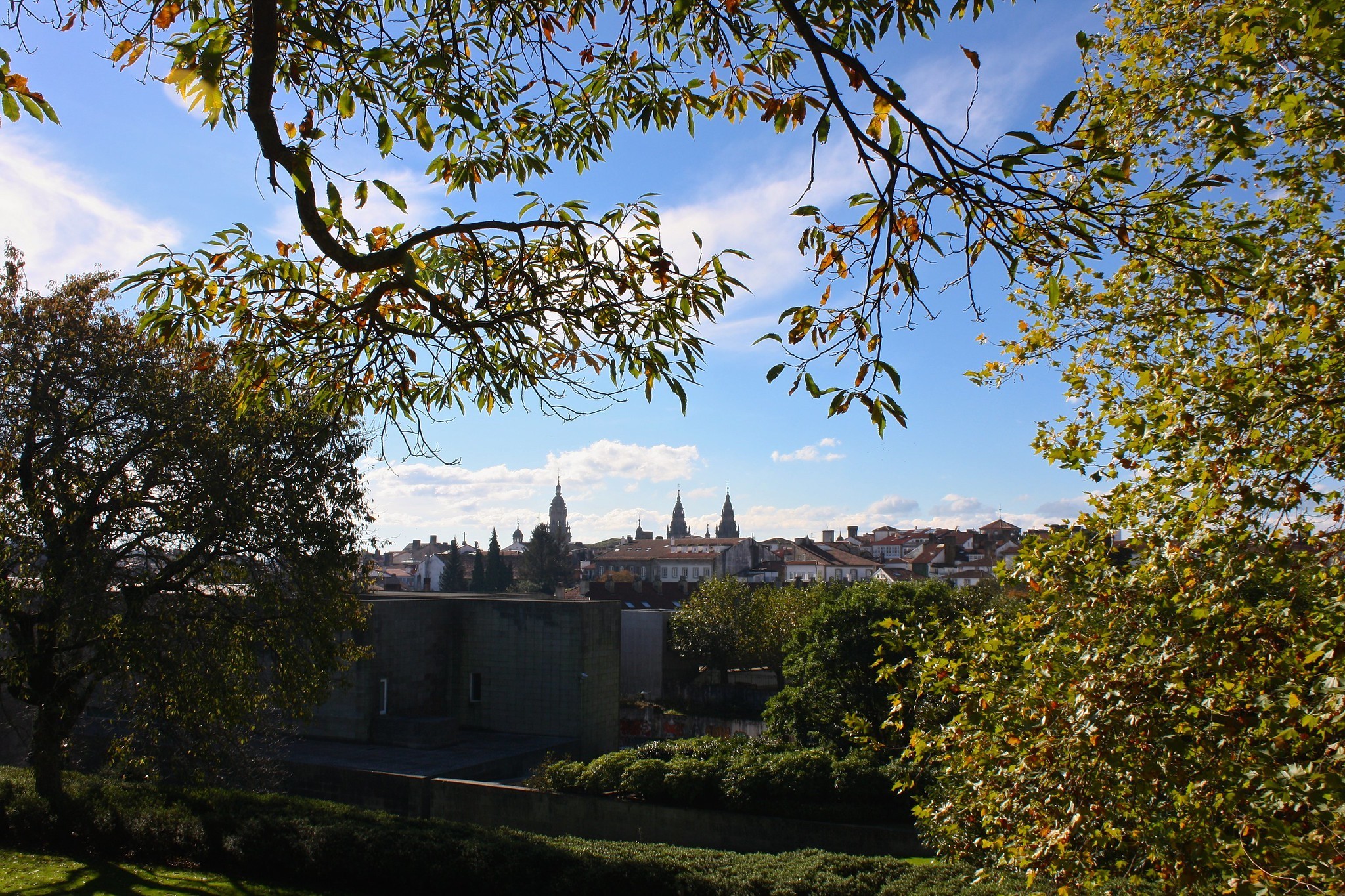
A peaceful park with gardens, views of nearby landmarks, and ruins of an old cemetery. San Domingos de Bonaval Park is perfect for a family or friends getaway trip, you can go picnic as there are a lot of picnic areas, or you can just simply walk around and explore this beautiful park.
13. Monasterio e Iglesia de San Pelayo
View this post on Instagram A post shared by Jessica Méndez (@jessi95_5) on Feb 10, 2018 at 12:01pm PST
This magnificent baroque decorated church can be a perfect place for you to relax and unwind. It’s very peaceful and quiet. The interior was designed to impress Catholic worshippers with their beauty. Get to learn more about the history of this monastery.
14. Praza da Inmaculada
View this post on Instagram A post shared by Scoprendo il mondo… ✈️? (@simon.l1985) on Feb 9, 2020 at 2:41am PST
Praza da Inmaculada has areally great location. It’s the space between the Cathedral and the Monastery San Martino Pinario. It is close to everything and lots of market stalls around. Because of that, this place is the one that you shouldn’t miss while you’re in Santiago, Spain.
15. Monasterio de San Martin Pinario
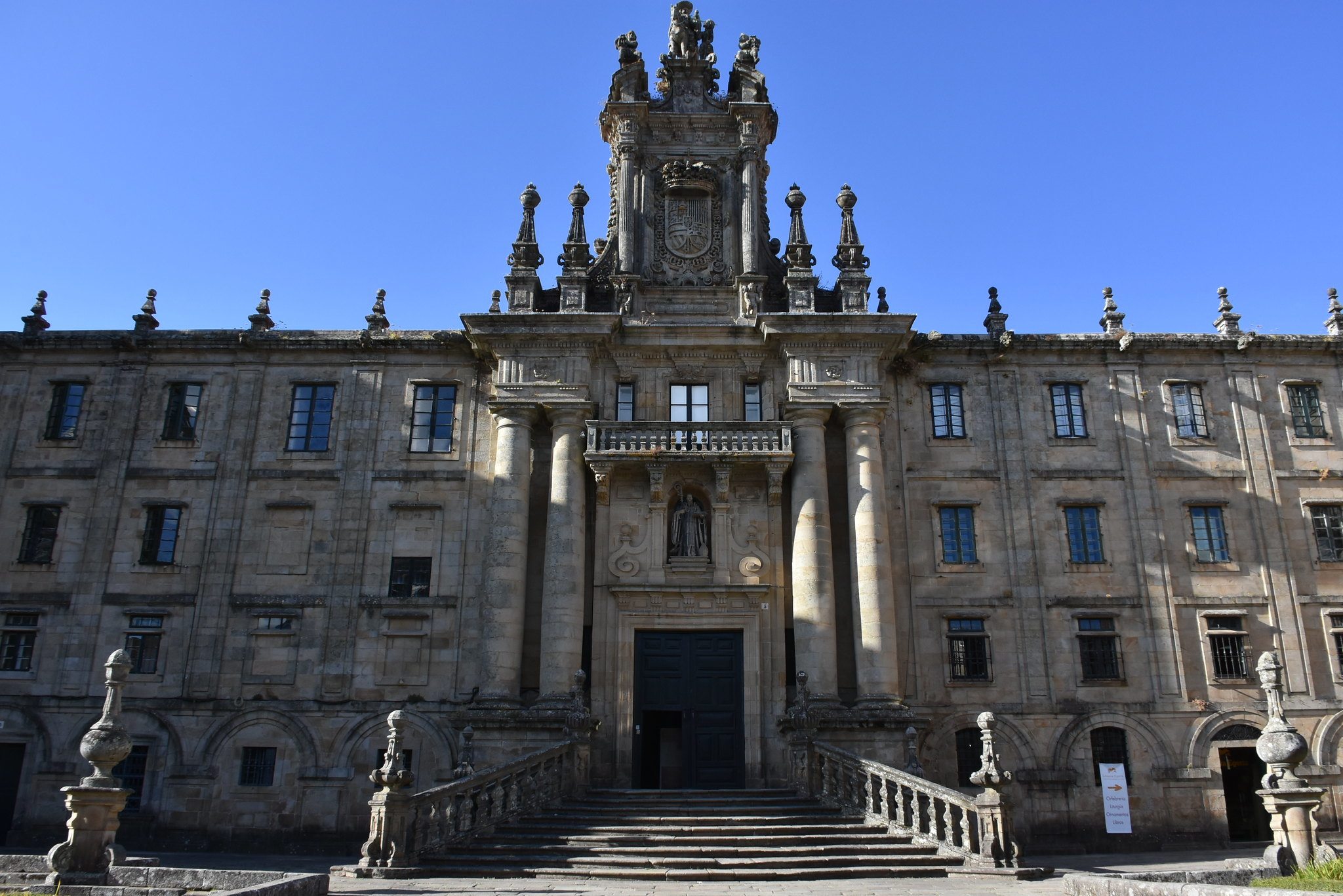
It is the second-largest monastery in Spain and one of the largest building complexes in Europe as well. The original design of the church dates back to the 12th century but only little remains of the original building as it has been largely renovated since the 16th century.
16. Find accommodation in Santiago, Spain
These are the possible things you can do in Santiago, Spain. So if you are ready to have a fun and exciting trip, you know what to do and where to go! So pack your things now and prepare yourself for a wonderful adventure in Santiago .
Extra Tip: Check out Plumguide for the best holiday homes and vacation rentals in Spain .
How to go to Santiago, Spain from the UK
Via Ryanair: (one way)
*From London Stansted to Santiago Airport
Ticket Price: £45.53
Via Easyjet: (one way)
*From London Gatwick to Santiago Airport
Ticket Price: £57.47
* Prices are subject to change.

Are you on Pinterest? Pin these!
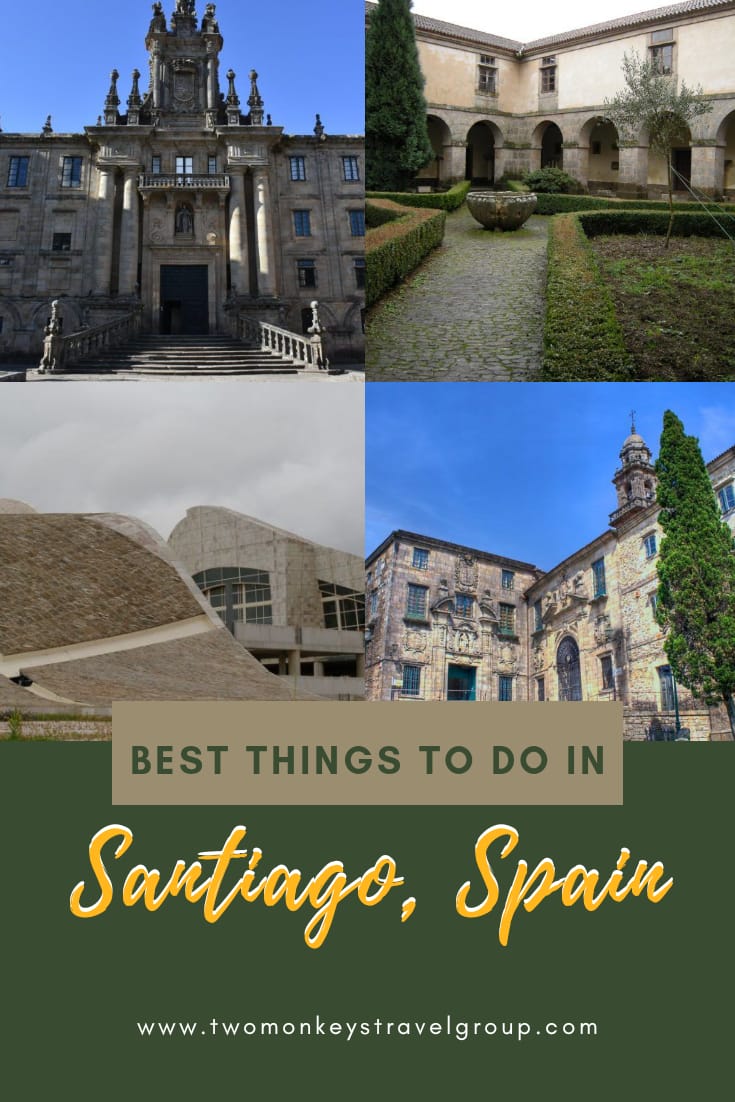
About the Writer

Leave a Reply Cancel reply
Your email address will not be published. Required fields are marked *
This site uses Akismet to reduce spam. Learn how your comment data is processed .
COPYRIGHT DISCLAIMER: Many of the articles on Two Monkeys Travel Group are guest posts by a number of Approved Contributors and are hosted by Two Monkeys Travel Group. Approved Contributors control their own work and post freely to our site. This includes all text and images that they use within their own work. All contributors are instructed to follow internationally recognised copyright and intellectual property guidelines. Two Monkeys Travel Group takes its own responsibilities very seriously, so if you feel that any part of this work is abusive in any way, please send us an email so that we can investigate - [email protected]
DISCLOSURE: Please note that some of the links above are affiliate links. So when you make a purchase we sometimes make a small commission, at no extra cost to you. The cost to you remains the same, sometimes even cheaper if we have negotiated a special deal for our readers.We use all of the companies we have listed here and that’s why they are in this list, but of course we need to keep Two Monkeys Travel Group running as well as it can, which is exactly what you’re helping with if you do decide to buy or book something through an affiliate link! If you have any more questions about the companies we use or any other companies you’re looking at, just email us and we’ll be happy to help. Please see our full disclaimer page for more information.
Written by Two Monkeys Travel - Contributor
Two Monkeys Travel Group – Community Travel Blog is a travel blog and website. We quickly grew into a valuable source of inspiring travel stories, advice, itineraries and travel guides, with the aim of demonstrating how to live a sustainable life of travel, whilst living your own definition of success. If you'd like to contribute and write a guest post, contact us at [email protected]
48 Hours in Tokyo – Exploring Japan’s Vibrant Capital
How to find the best hotels in new york, top california destinations for families to enjoy, scuba diving and snorkeling in the philippines, what are the benefits of booking flight tickets in advance, related posts, 8 best things to do in lustica bay, montenegro, culloden estate and spa – the best luxury hotel in belfast, northern ireland @cullodenestate, 6 places to visit in france with your family [a perfect french retreat], 5 hidden gems of southern bohemia, czech republic @budvaruk, previous post, best cat cafes in tokyo, japan [ with tips and rates included], 11 things you must have for your home office – work from home equipment and essentials, subscribe to our newsletter.
Receive tips on how you can live a sustainable long-term travel lifestyle!
- First Name *
- Phone This field is for validation purposes and should be left unchanged.
Take advantage of the search to browse through the World Heritage Centre information.
Share on social media
Unesco social media, santiago de compostela (old town).
- Description
This famous pilgrimage site in north-west Spain became a symbol in the Spanish Christians' struggle against Islam. Destroyed by the Muslims at the end of the 10th century, it was completely rebuilt in the following century. With its Romanesque, Gothic and Baroque buildings, the Old Town of Santiago is one of the world's most beautiful urban areas. The oldest monuments are grouped around the tomb of St James and the cathedral, which contains the remarkable Pórtico de la Gloria.
Description is available under license CC-BY-SA IGO 3.0
Vieille ville de Saint-Jacques-de-Compostelle
Ce célèbre lieu de pèlerinage situé dans le nord-ouest de l'Espagne est devenu un symbole de la lutte des chrétiens espagnols contre l'islam. Détruite par les musulmans à la fin du X e siècle, la ville a été complètement reconstruite au siècle suivant. La vieille ville de Saint-Jacques constitue l'un des plus beaux quartiers urbains du monde avec ses monuments romans, gothiques et baroques. Les monuments les plus anciens sont regroupés autour de la tombe de saint Jacques et de la cathédrale qui s'ouvre par le magnifique portail de la Gloire.
مدينة سانتياغو دي كومبوستيل القديمة
يقع موقع الحجّ الشهير هذا في شمال غرب اسبانيا. جرى تدميره أواخر القرن العاشر ولكن أُعيد بناؤه بالكامل في القرن اللاحق. ومدينة سانتياغو دي كومبوستيل القديمة هي من أجمل أحياء العالم الحضريّة بتحفها الرومانيّة والقوطيّة والغريبة. وتلتف التحف الأقدم حول مقبرة القديس يعقوب والكاتدرائيّة ذات بوابة المجد العظيمة التي تمهّد لولوجها.
source: UNESCO/CPE Description is available under license CC-BY-SA IGO 3.0
圣地亚哥–德孔波斯特拉古城
西班牙西北部这个著名的朝觐圣址成为西班牙基督教反对伊斯兰教的重要象征。古城在公元10世纪末期遭到了穆斯林的严重毁坏,但在11世纪就得到彻底重建。圣地亚哥古城内有各式罗马式建筑、哥特式建筑和巴洛克式建筑,堪称世界上最美丽的城市之一。城中最古老的古迹都坐落在圣雅各的坟墓和奉有圣雅各圣骨的教堂周围。
Ciudad vieja de Santiago de Compostela
Sede de uno de los más célebres lugares de peregrinación de la cristiandad y símbolo de la lucha de los cristianos españoles contra el Islam, esta ciudad del noroeste de España fue arrasada por los musulmanes a finales del siglo X. Totalmente reconstruida en el siglo siguiente, Santiago de Compostela es una de las zonas urbanas de mayor belleza del mundo, realzada por sus monumentos románicos, góticos y barrocos. Los más antiguos se concentran en torno a la catedral, tumba del apóstol San Santiago, a la que se accede por el magnífico Pórtico de la Gloria.
サンティアゴ・デ・コンポステーラ(旧市街)
source: NFUAJ
Santiago de Compostela (Oude stad)
Bedevaarten waren een essentieel onderdeel van het West-Europese geestelijke en culturele leven tijdens de Middeleeuwen. Santiago de Compostela is een beroemd bedevaartsoord in het noordwesten van Spanje en het werd een symbool in de strijd van de Spaanse christenen tegen de islam. De stad werd aan het eind van de 10e eeuw verwoest door de moslims, maar volledig herbouwd in de volgende eeuw. Met zijn romaanse, gotische en barokke gebouwen is de oude binnenstad van Santiago een van 's wereld mooiste stedelijke gebieden. De oudste monumenten zijn gegroepeerd rond het graf van Sint Jacob en de kathedraal die de opmerkelijke Pórtico de la Gloria bevat.
Source: unesco.nl
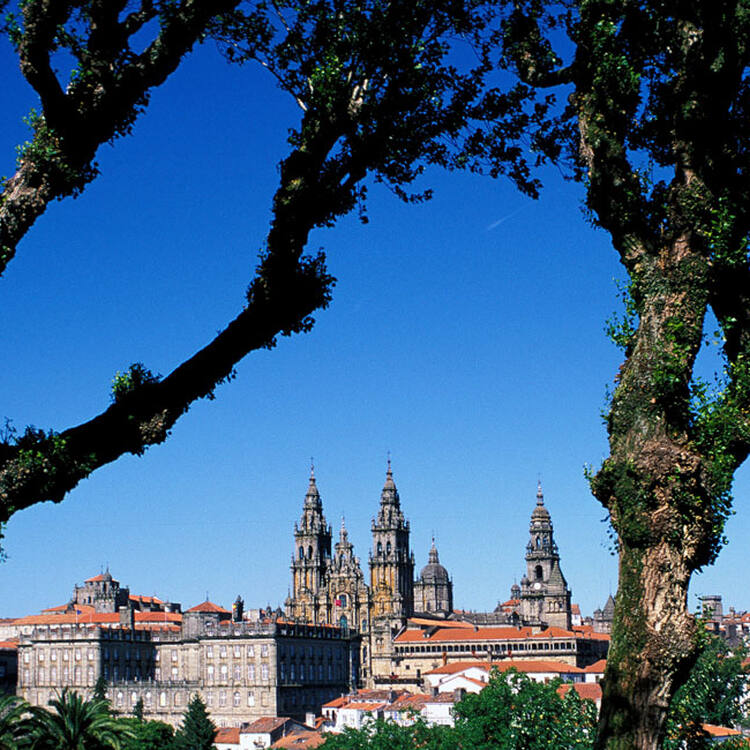
Outstanding Universal Value
Brief synthesis
Santiago de Compostela (Old Town) is located in Galicia, situated in the far north-west of Spain.
In the beginning of the 9th century, a hermit called Pelagius saw a mysterious light shining over a Roman tomb forgotten in the middle of a forest. Very soon, the incredible news spread all over the Christian world: the tomb of St. James the Greater, the beloved apostle of Jesus Christ, had been discovered in a far site near the finis terrae , the end of the known Earth, in the northwest of Iberian Peninsula. A few years later, this site became a famous pilgrimage town, one of the most important of Christianity. Pilgrims came from all over Europe following the Camino de Santiago to reach the city born around the Holy Tomb, exercising a great influence on the surrounding area. This is evidenced in the small towns, churches, hospitals, and monasteries that were built near the Camino to attend to the thousands of pilgrims who came to visit the tomb. This influence in the local architecture and art was especially strong and long-lasting in the north-west of Spain, but the fame and the reputation of the sanctuary of Santiago de Compostela went well beyond; Galicia was even known in the Nordic sagas as Jakobsland.
This famous pilgrimage site also became a symbol in the Spanish Christians' struggle against Islam. Destroyed by the Muslims at the end of the 10th century, it was completely rebuilt in the following century.
The Old Town of Santiago de Compostela, together with the outlying Santa Maria de Conxo Monastery, constitutes an extraordinary ensemble of distinguished monuments. The squares and narrow streets of the Old Town contain Romanesque, Gothic, Renaissance, Baroque, and Neoclassicist buildings. This town is not only a harmonious and very well preserved historical city, but also a place deeply imbued with faith. The cathedral, considered as a masterpiece of Romanesque architecture, keeps the remarkable Pórtico de la Gloria, a jewel of the medieval sculpture. However, the authentic symbol of the city is the Baroque western façade of the cathedral, which forms one of the sides of the square of Obradoiro, one of the world´s most beautiful urban areas.
The phenomenon of pilgrimage is not only a relevant historical fact, but also a continuous movement thanks to the celebration of the Holy Years.
Criterion (i): Around its cathedral, which is a world renowned masterpiece of Romanesque art, Santiago de Compostela conserves a valuable historic centre, known as one of Christianity´s greatest holy cities. All European cultural and artistic currents, from the Middle Ages to the present day, left extraordinary works of art in Santiago de Compostela.
Criterion (ii): During both the Romanesque and Baroque periods, the sanctuary of Santiago de Compostela exerted a decisive influence on the development of architecture and art, not only in Galicia, but also in the north of the Iberian Peninsula.
Criterion (vi) : Santiago de Compostela is associated with one of the major themes of medieval history. From the shores of the North and Baltic Seas, thousands of pilgrims carrying the symbol of the scallop and the pilgrim's staff walked, for centuries, to the Galician sanctuary along the paths of Santiago de Compostela, veritable roads of the Faith.
The property encompasses 108 ha, with a 217 ha buffer zone. Santiago de Compostela shows a remarkable state of conservation, largely due to conservation policies that have preserved the integrity of monuments and buildings that form the civil and religious architectural ensemble. Elements from the Middle Ages are integrated with those from the Renaissance, as well as the constructions from the 17th and 18th centuries into a high-quality urban fabric. The Old Town is a liveable and lively place where inhabitants and business coexist with tourism. The urban development has respected natural spaces where the green Galician fields join the historical city. In this respect, the property integrates the urban ensemble, historical oakwoods and open green spaces.
Authenticity
Throughout its history, Santiago de Compostela has received different influences, and the Old Town has integrated these different styles and currents with local traditions. The result of this mixture is a city where the original Galician architecture, with its typical wooden galleries and traditional materials, like stone, wood, or iron, combines with great monuments that constitute a splendid tour across the history of European and universal art.
Protection and management requirements
The conservation of Santiago de Compostela is the responsibility of the Consortium of Santiago de Compostela, created in 1991 and integrated by the national, regional, and local public administrations, as well as the archbishopric and the University. From its creation, the Consortium has carried out important works of restoration of monuments and public spaces, and has subsidized and implemented rehabilitation projects, both for housing and business premises in order to preserve the traditional activities of the historical centre. It also supports conservation actions carried out by the Town Hall of the city and the autonomous government of Galicia.
The regulatory framework that allows for conservation and management action is prescribed in the Special Plan for the Protection and Rehabilitation of the City of Santiago de Compostela.
In terms of management challenges, Santiago de Compostela is facing the pressures of mass tourism, which produces overcrowding around the cathedral and provokes changes in traditional commercial activities. Actions have been undertaken towards diversifying the touristic offer and diverting visitor flows to the suburbs of the city, such as with the construction of the City of the Culture of Galicia, a modern complex constructed by the Regional Government on Mount Gaias, in the proximity of the historical centre of Santiago de Compostela. In the future, adaptive changes will need to be foreseen in the Special Plan for the Protection and Rehabilitation of the City of Santiago de Compostela to preserve the traditional commercial activities in the Old Town, and to support the policies of conservation of buildings and monuments, as well as the recovery of degraded spaces.
- Ministerio de Educación, Cultura y Deporte (in Spanish)
- Ciudades Patrimonio de la Humanidad de Expaña
- Patrimonio de la Humanidad en España (in Spanish only)
- Santiago de Compostela
- World Heritage Sites in Spain (Tourist Office of Spain)
- Santiago de Compostela (World Heritage Cities of Spain)

State of Conservation (SOC)
Protections by other conservation instruments.
1 protection / 1 element
- Portuguese-Galician border ICH: a safeguarding model created by Ponte...nas ondas!
Read more about synergies

Touropia Travel Experts
Discover the World
14 Best Things to Do in Santiago de Compostela

For many travelers the capital of Galicia, Santiago de Compostela represents the ultimate stop along a shared journey. Since the ninth century, millions of pilgrims have walked the 900-km (560-mile) long Camino de Santiago, or Way of St. James, from just across the French border to Santiago, reputed to be the burial spot of the Apostle James.
Major attractions in Santiago de Compostela, therefore, center around this pilgrimage destination, but there is much more than this to this northwestern Spanish city. Other things to do in Santiago de Compostela include exploring its great museums, beautiful parks and magnificent medieval buildings.
Some say Santiago de Compostela is a big village rather than a city. This rings true when the pilgrims and students leave, cutting its population in half. It’s an immense change.
Excitement, palpable joy and worldwide languages are quickly replaced by the everyday locals who carry on tradition, culture and a seafood-rich cuisine as they have for even longer than the pilgrimage has brought travelers to its village.
14. San Francisco Monastery
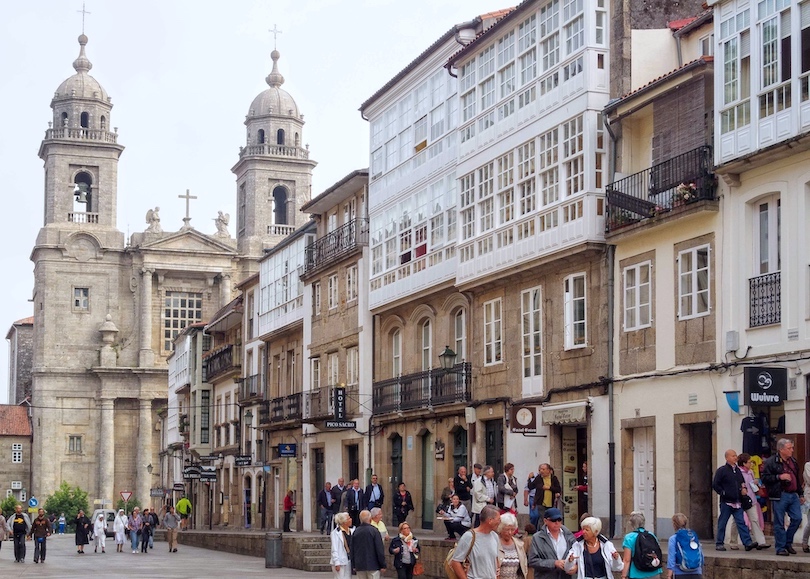
When you look down at Santiago de Compostela’s Old Town from the surrounding hills, there is a picturesque skyline that is a collective of the capital city’s best buildings and churches. One of those is the Church of San Francisco, home to the San Francisco Monastery.
Founded by St. Francis, who himself undertook a pilgrimage to this very city, the monastery dates back eight centuries. Ever since, it’s been the home of Franciscan monks.
The modern-day structure, however, was built more recently in the mid-18th century. It faces north-to-south, which is the complete opposite of traditional design. Within, you can discover an immense central nave surrounded by elaborate columns.
13. Pilgrimage Museum
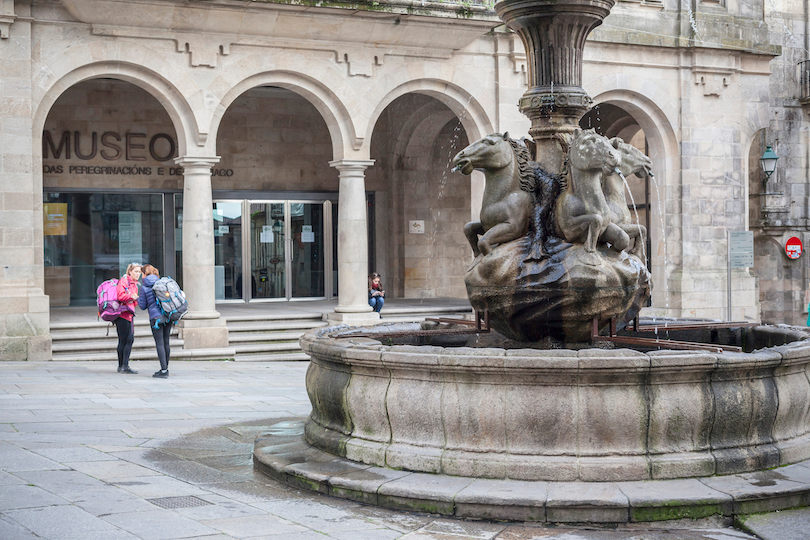
If you want to learn more about the Camino de Santiago and the history of pilgrimage in general, you must visit the Pilgrimage Museum.
The walk to Santiago is one of the most celebrated on earth and dates back to the 9th century. But it was in the Middle Ages that these ventures really flourished, so too the development of beautiful churches along the most prominent paths.
The museum dives into the history of the so-called Way of Saint James and you’ll quickly discover why he was so important. In addition, it shows how this pilgrimage has shaped Santiago de Compostela over the last 1200 years.
12. Praza da Quintana
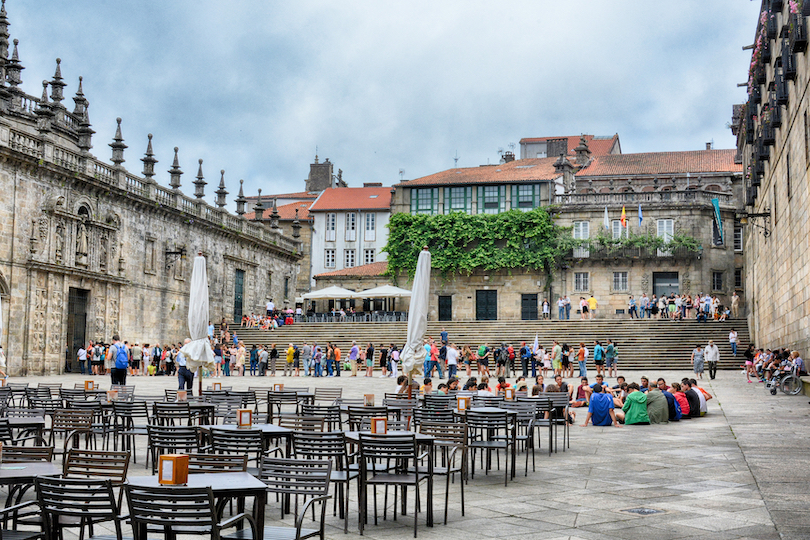
Surrounded by the past, it can be easy to overlook the Praza da Quintana. But from within the square, you can gawk up at some of the city’s most celebrated and ancient architecture.
These include the facade of the Monastery of San Paio de Antealtares. It was here that the tomb of St. James was discovered in the 9th century and would spur centuries of would-be pilgrims to take the journey of a lifetime.
Encompassing the square is the soaring clock tower affixed to the Santiago de Compostela Cathedral. The tower, known as Berengial, is around 700 years old and still rings true to this very day.
11. Cathedral Museum
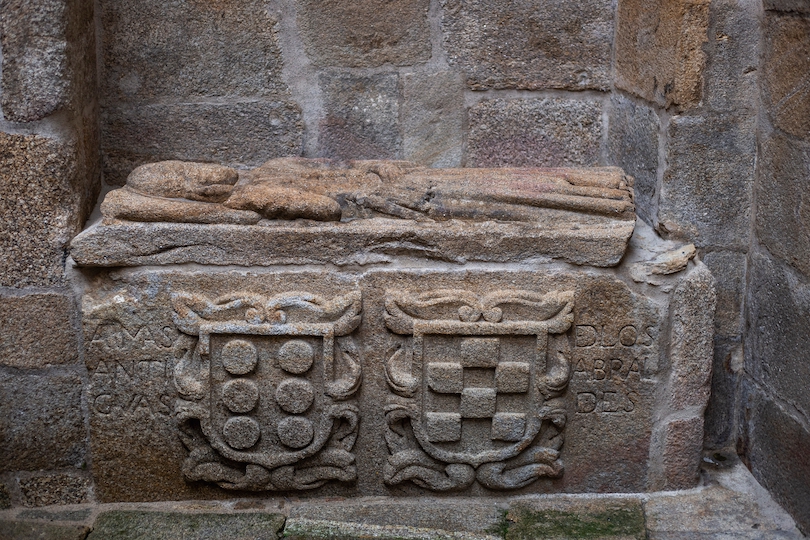
Timing a visit to the Santiago de Compostela Cathedral to experience the swinging of the Botafumeiro is a must. However, you can round out the experience by wandering through the Cathedral Museum.
In the western cloister of the cathedral, this museum showcases the history of the building and its importance to residents and pilgrims alike. Within its library are ancient collections of scripts and volumes that explore the history of Galicia, the Way of Saint James and the city in real-time.
Spread into various rooms, you’ll uncover historic sculptures, celebrated paintings and tapestries by the likes of Goya and Teniers. This along with important archaeological discoveries.
10. Monte do Gozo
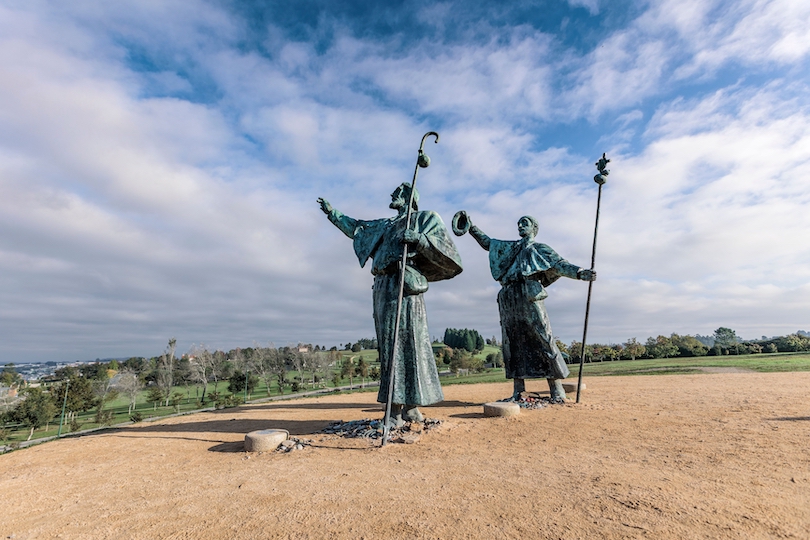
Known as the Hill of Joy, there are mixed emotions when pilgrims arrive at Monte do Gozo. At a height just shy of 400 meters, the hill towers over Santiago de Compostela and provides travelers with their first glimpse of the Cathedral towers below.
It also marks the meeting point of several “ways” or trails bringing pilgrims from different sections together for the first time. Being so close to the end provides a mix of excitement, relief and, appropriately, joy, for our wearied walkers.
But even if you aren’t on the trail, it’s well worth the visit for the views and monuments. The latter include the amazing Pilgrims Statue and the Pope John Paul II monument.
9. Cidade da Cultura
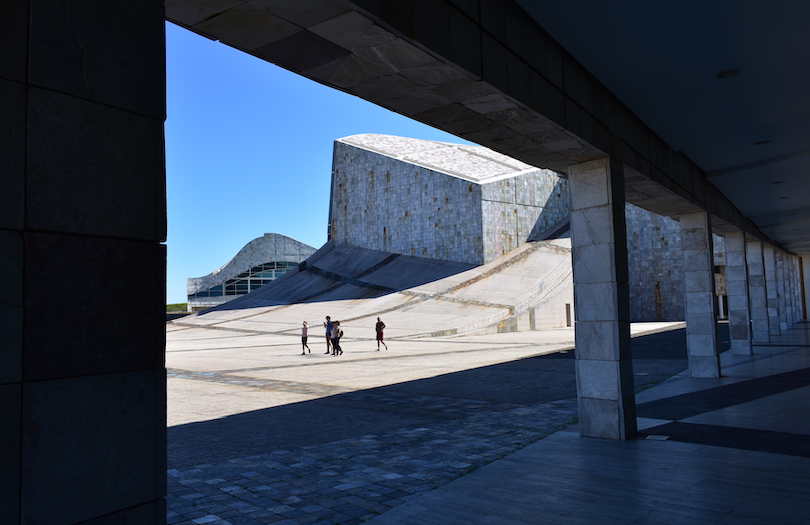
The City of Culture is found within a futuristic building at odds with the rest of Santiago de Compostela. It makes the utterly 21st century design even more noteworthy. Within you can explore the expansive museum and gardens before catching a live event at the outdoor performance area.
The main highlight is the Museo Centro Gaias, which is a free art museum with a variety of temporary events and oversized installations.
8. Parque da Alameda
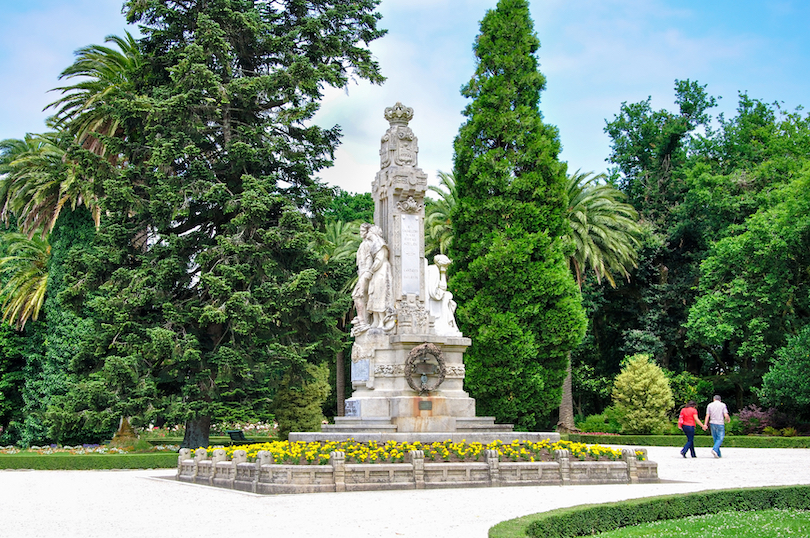
If you’re like us, then your feet will get a workout when traveling around Santiago de Compostela. At Parque da Alameda you have the chance to catch your breath, put your feet up and watch the world go by. It also wouldn’t be Santiago de Compostela if there wasn’t also a view of the beloved cathedral.
I know you’ve done a lot of walking, but once you’ve done enough people-watching and dined on a picnic of local delicacies, head along the Paseo da Ferradura. This walking path takes you along a treelined passage by cyclists, locals and a statute of Valle Inclan, a celebrated writer. If you’ve come on a weekend may also stumble upon a festival or market.
7. Museo do Pobo Galego
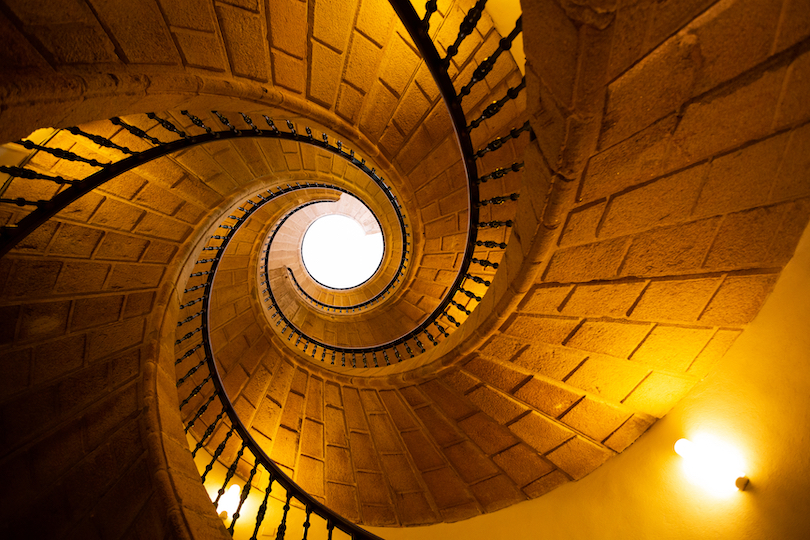
Set within the old Convent of Santo Domingo de Bonaval, the Museo do Pobo Galego is an ornament to the cultural history of the region. Galicia has a long storied past from its traditional heritage to the evolution of its mouthwatering seafood-based cuisine.
Within the Museum of Galician People, you’ll uncover the past through its array of wonderful exhibits. These include prominent archaeological discoveries that date back centuries, along with art and clothing.
These are all dispersed into different sections that take you on a trip to understand the importance that the Atlantic, the trades, traditional farming and music have played in local life over the years.
6. Casco Antiguo
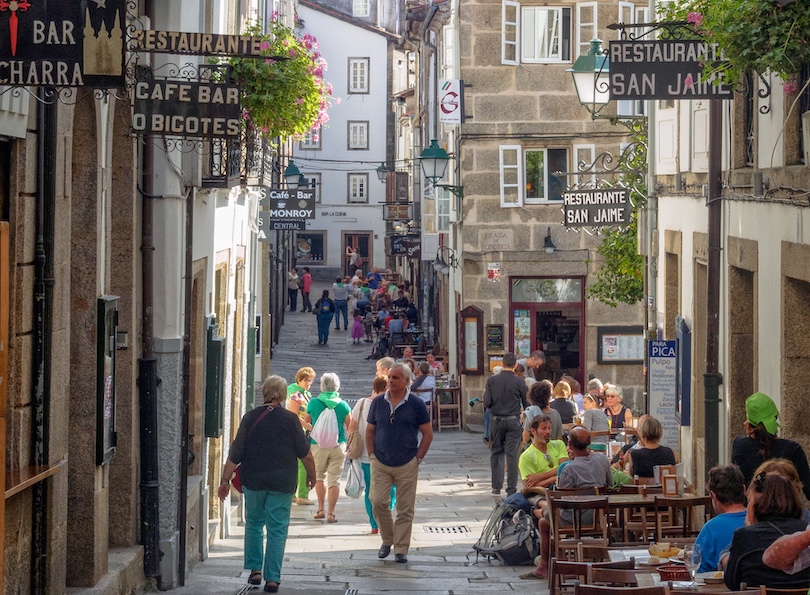
The Galician city is quite compact and a dream to walk around and purposely get lost on foot. In the heart of the city is the Old Town, known as Casco Antiguo, whose cobbled streets and narrow alleys take you on a journey back in time.
While you’ll want to have a list of things to see in the Old Town, take some time to simply wander. This way you’ll discover ample surprises from random fountains, small squares, parks where locals converse or merely enjoy the scene. Likewise, you can follow the aromas to restaurants serving delectable Galician cuisine.
If you have arrived at the height of summer, wake early to avoid the crowds. Especially if you want to check out the Plaza del Obradoiro and the cathedral.
5. Parador Hostal Dos Reis Catolicos
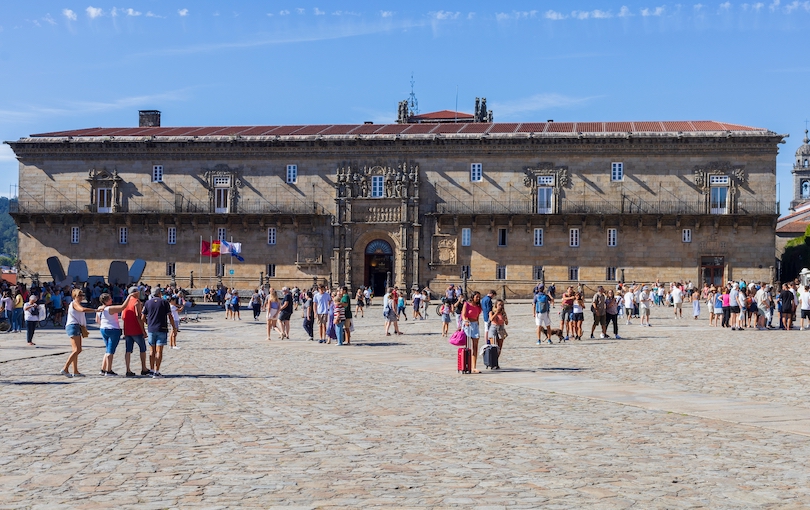
The first known pilgrimage to Santiago de Compostela occurred in the year 820. Much has changed since that journey undertaken by King Alfonso II, but there remain plenty of reminders of the trail’s enormous past.
The Parador Hostal Dos Reis Catolicos is one of the most poignant reminders. This former pilgrims hotel dates back to 1499 and is the oldest hotel in Spain.
Hospitality has long been a cornerstone of this pilgrimage and for centuries it has welcomed weary travelers. Today it is a part of the Parador de Santiago de Compostela, a magnificent five-star hotel that continues 500 years of tradition.
Without having to stay there you can still check out the Gothic facade and the beautiful interior cloisters. Plus, there’s a fantastic fine-dining restaurant inside.
4. Camino de Santiago
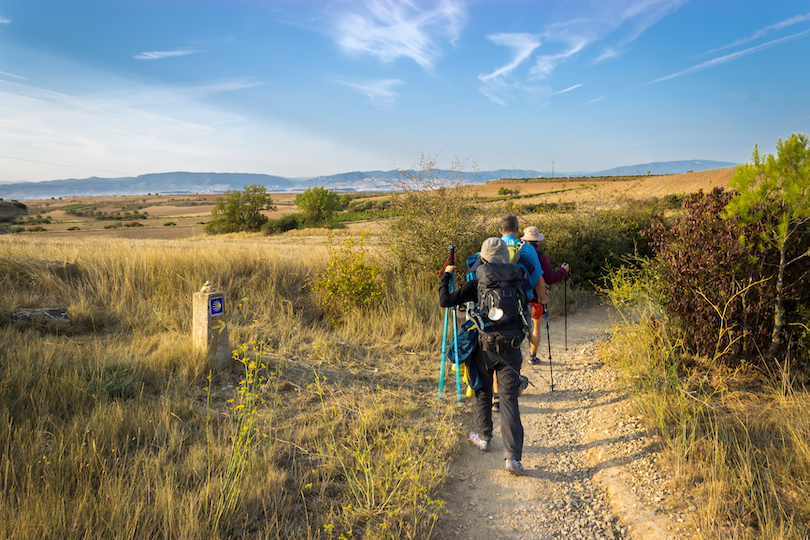
According to legend, St. James’ body was taken to Galicia by boat from Jerusalem and carried inland to where Santiago de Compostela is now located.
The Camino de Santiago (Way of St. James) is the name of any of the pilgrimage routes to his shrine in the city’s Cathedral. To earn the compostela (certificate of accomplishment) one needs to walk a minimum of 100 km (62 miles). In practice the closest convenient point to start is the small city of Sarria, as it has good connections to other places in Spain.
While many pilgrims only do that final portion of the route, there are great rewards for starting much further away and several Europeans walk all the way from their homes, following one of the many routes.
3. San Martin Pinario Monastery
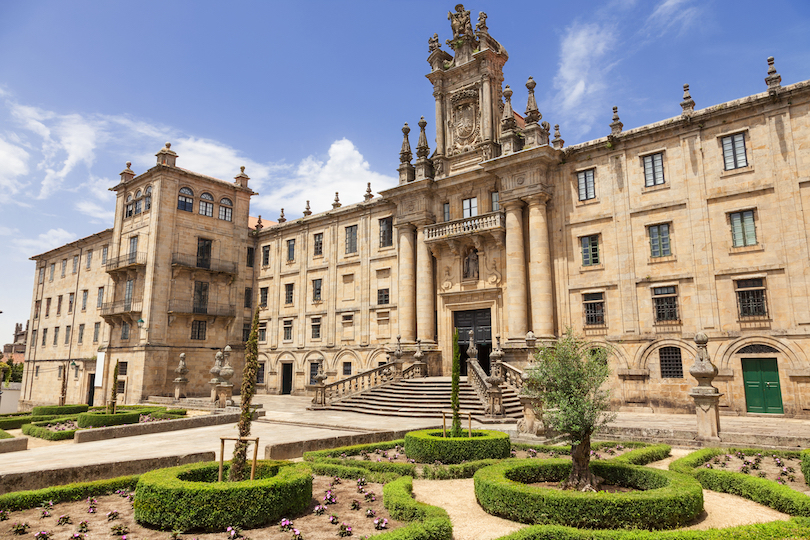
Taking you back to the 9th century, San Martin Pinario Monastery was first the home of Benedictine monks. Having heard the news of St. James and his burial, they settled.
Six hundred years later, the monastery that we can admire today was built. Now officially a part of the Benedictine Congregation, that building represents the influx of cash that quickly followed.
You can find this incredible monastery in the city’s main square, the Plaza del Obradoiro. Time will be well spent admiring its complex facade, affixed with intricate baroque architecture. Inside are memorable altarpieces from the hands of Fernando de Casas Novoa, from the 1700s.
Aside from the church, explore the museum to discover more of its past. Guided tours are also available.
2. Plaza del Obradoiro
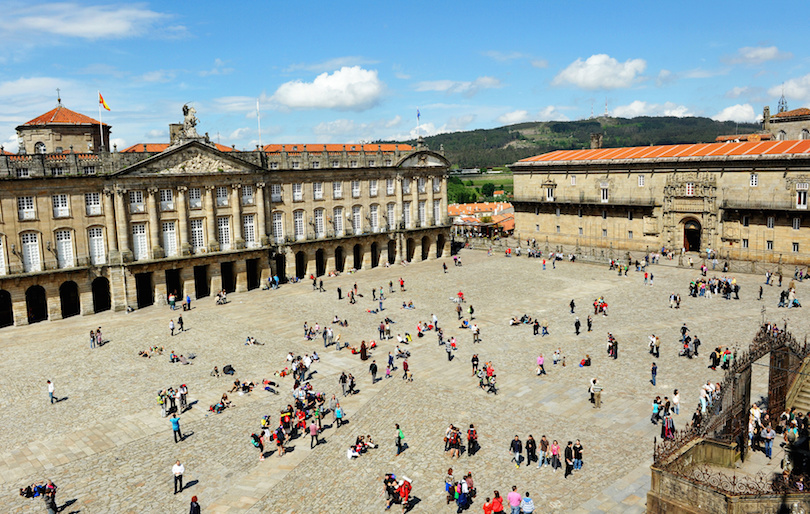
Home to the city’s famous cathedral, the Plaza del Obradoiro is often a melting pot of folks from across the globe. Thanks to the Camino’s fame, the Santiago de Compostela’s central square is affixed with locals, students and pilgrims from all walks of life.
Take a seat and pause for a second. As you listen in on the conversations, you’ll detect an array of languages. There’s excitement for the pilgrims finishing their journey, the joy of students and locals just going about their day.
In the heart of the Old Town, you’ll be surrounded by some of the best architecture in the city. This includes the City Hall, the monastery, and the Colegio de San Jeronimo, a 17th century college. Thus, you have an amazing mix of people watching and historic views.
1. Santiago de Compostela Cathedral
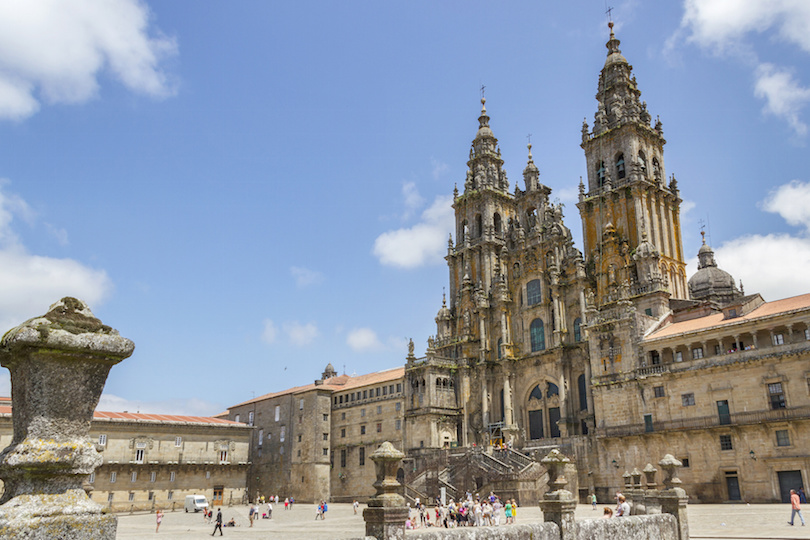
For many, Santiago de Compostela Cathedral marks the end of their pilgrimage along the Camino. It’s a fitting end for the trekkers, cyclists and horseback riders who have made the 500 kilometer (often more) journey.
Set in Praza do Obradoiro, the stunning Romanesque structure is supposedly the resting place for St. James. The cathedral harbors hints of Baroque and Gothic styles quickly capturing your eye as it comes into view.
Time your visit to coincide with the swinging of the Botafumeiro. This is a rope and pulley system that holds incense at its end. It is then swung from end to end, creating an awe-inspiring scene regardless of your religious affiliations.
Top it off with a guided tour of the cathedral’s rooftop which presents the best panoramic views in the city.
Where to Stay in Compostela
Whether you’ve completed the famed pilgrimage or are visiting the city to experience its history, you can’t go wrong by staying within the Old Town. This places you within walking distance of Santiago de Compostela’s attractions, cathedrals and squares. The area is very walkable, and its charming cobbled streets will motivate your weary feet to wander even further.
Within the old town, you’ll find the mid-range hotels in the city, the Hotel Compostela . Set within the UNESCO-recognized Plaza de Galicia, this hotel combines a historic facade with a modern interior. Upscale rooms come with warm wooden accents, A/C, Wi-Fi and views of the Old Town below.
Also in the Old Town is the budget-friendly Hotel Praza Quintana . Despite the lower costs, the hotel remains elegant with marble floors and bright accents along with views of the cathedral from some rooms. All rooms come with Wi-Fi and breakfast.
How to Get there
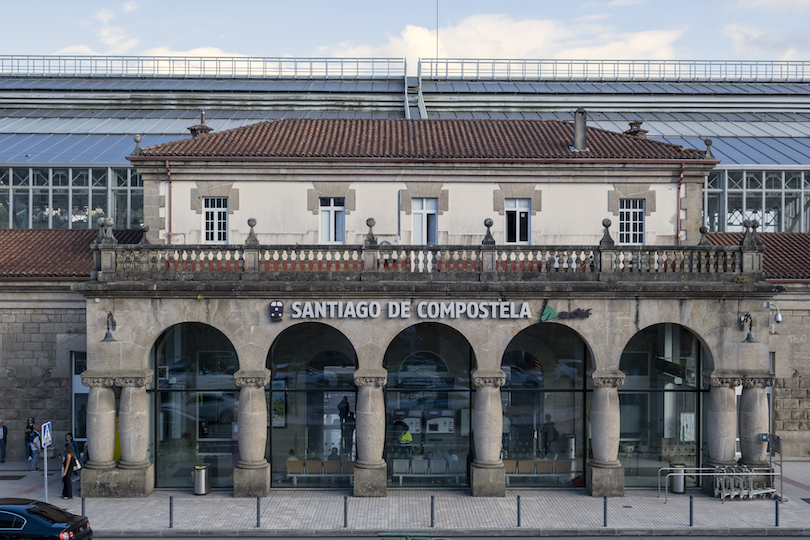
The easiest way to get to Santiago de Compostela is to fly to the nearby Santiago-Rosalia de Castro airport. You’ll find direct flights from most major cities in Western Europe. Once you’ve landed, jump aboard Bus #6 for the 25-minute ride to the city center.
Aside from flying, buses and trains depart daily from Madrid and Barcelona . However, with the latter, the journey can be over 10 hours. Lisbon and Porto also offer bus services to the Galician capital.
Of course, like many others, you can walk to Santiago de Compostela along the Way of Saint James. This tradition begins at Saint-Jean-Pied-de-Port 800 kilometers away.
Approximate travel times
- A Coruña – 40 minutes by car, 30 minutes by train
- Vigo – 1.5 hours by car, 1 hour 30 minutes by train
- Porto (Portugal) – 3 hours by car, 4 hours 30 minutes by train
- Lugo – 1 hour by car, 1 hour by train
- Leon – 2.5 hours by car, 2 hours 30 minutes by train
- Madrid – 6 hours by car, 5 hours by train
Best Time to Visit Santiago de Compostela
During this period, temperatures range from 18 to 24°C (so 64 to 75°F) with July and August of course being the hottest months. The city and the numerous pilgrimage routes leading to it are also at their busiest and most expensive.
On July 25, festivities reach a fever pitch as concerts, plays and fireworks displays are held for the Day of Galicia and Feast of the Apostle St. James. The city’s other most important event – Semana Santa or Easter – also draws huge crowds around the beginning of April.
Either side of summer, the number of people visiting the city and hiking the Camino drops off a lot. Temperatures are also a bit cooler though spring and autumn are unfortunately much, much wetter than the dry summer months.
The rest of the year, from November to March, Galicia is rather cloudy, windy and wet so pilgrims and tourists mostly stay away.
Map of Attractions in Santiago de Compostela
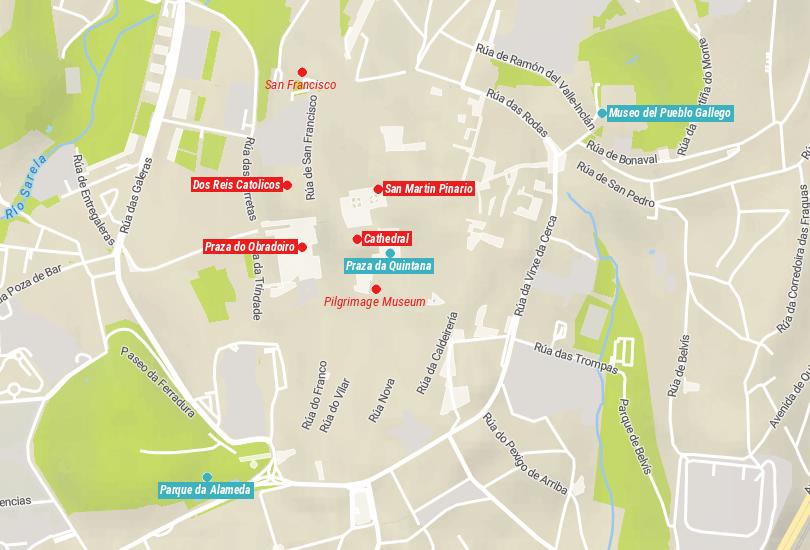
Share this post:
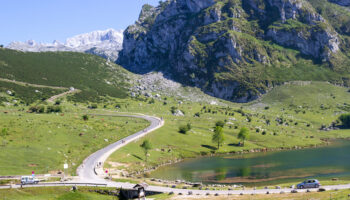
12 Best Things to do in Asturias, Spain
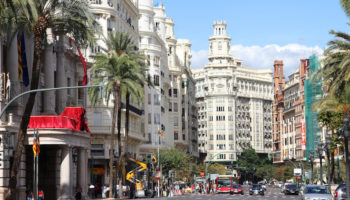
17 Best Cities to Visit in Spain
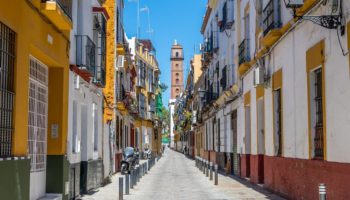
Where to Stay in Seville: Best Neighborhoods & Hotels
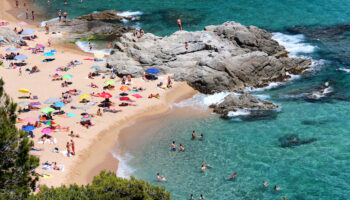
20 Best Beaches in Spain to Visit This Summer
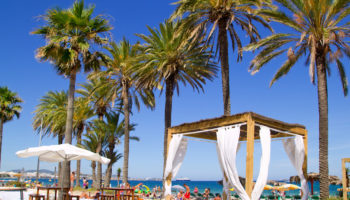
10 Best Places to Visit in Ibiza

10 Facts about the Canary Islands
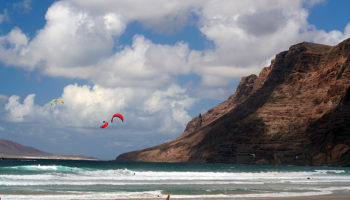
10 Best Beaches in the Canary Islands
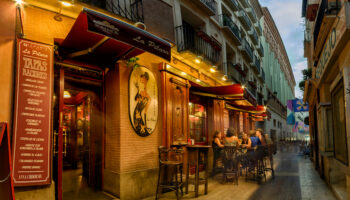
18 Best Things to do in Zaragoza, Spain
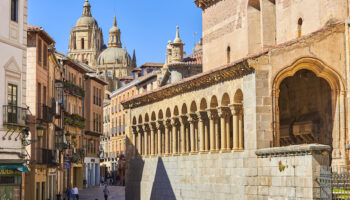
19 Best Things to Do in Segovia, Spain
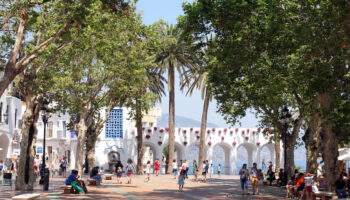
12 Best Things to do in Nerja, Spain
Reader interactions, leave a reply cancel reply.
Your email address will not be published. Required fields are marked *
This site uses Akismet to reduce spam. Learn how your comment data is processed .
Home > Blog > Top 10 Things to Do in Santiago de Compostela

Top 10 Things to Do in Santiago de Compostela
Santiago de Compostela is a beautiful and historic city that is well worth visiting. It is also the endpoint of the famous Camino de Santiago and an excellent place for pilgrims to rest after their walk. There is something for everyone, including stone streets, artistic Baroque buildings, amazing Spanish cuisine, the awe-inspiring Santiago de Compostela cathedral, and scenic landscapes.
To make the most of your time in Santiago be sure to do some homework. Gather some maps, collect brochures, Google the best restaurants and most popular things to do and then follow your instincts. Here are the top things you must never miss when you are in Santiago de Compostela.

1. The Cathedral of Santiago de Compostela
Right in the heart of Santiago is the magnificent cathedral. Santiago de Compostela Cathedral is one of the main attractions for tourists and pilgrims alike. The remains of St. James the Great, one of the twelve apostles of Jesus, are reputed to be buried here.
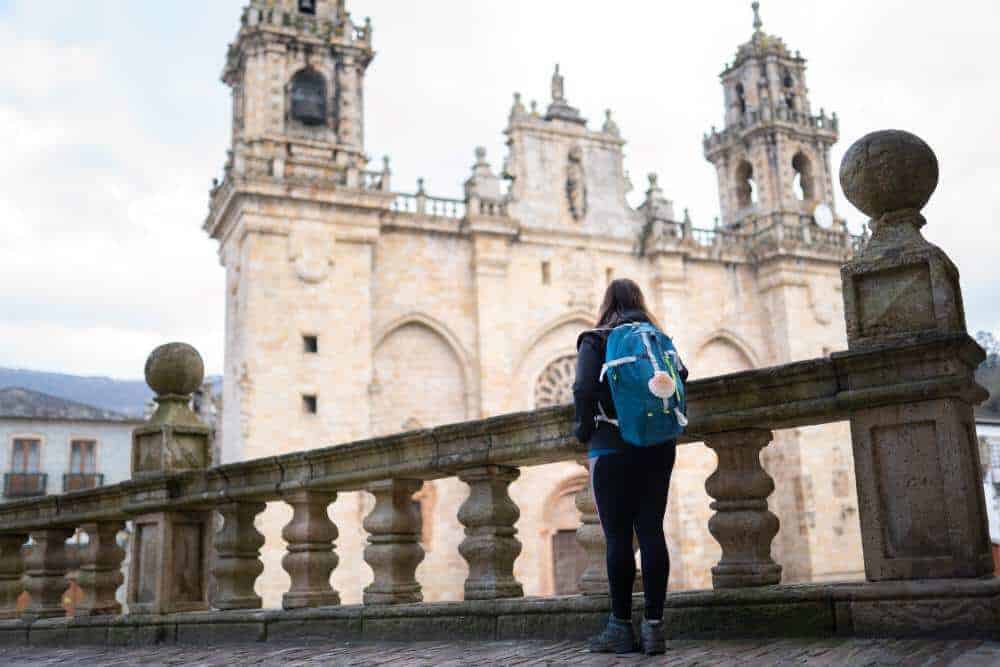
This magnificent building stands in the Praza do Obradoiro and boasts a Romanesque structure with later elements of the Gothic and Baroque styles. Make sure to see the Pórtico da Gloria (the Romanesque porch entrance by Mestre Mateo) and the Holy Door which is only opened during Holy Years on the Camino.
One of the highlights of Santiago’s cathedral is its massive swinging Botafumeiro – its giant thurible. It is not swung every day, so you will need a bit of luck to catch it in action. and, if you are not scared of heights,

Plan Your Visit to Santiago de Compostela’s Cathedral
The Basilica (Sepulchre of Saint James the Apostle) is open every day, from 7 am to 9 pm. The museum is open with visits to the permanent Collection, Gelmírez Palace, and Portico of Glory on Tuesday to Saturday, from 10 am to 2 pm and 4 pm to 7 pm, and Sundays, from 10 am to 2 pm. It is closed on Mondays.
The Pilgrim’s Reception Office at the cathedral is open from 10 am to 6 pm to claim your Compostela certificate at the end of the Camino.
2. The Charming Casco Antiguo (Old Town)
After visiting the cathedral you are in the perfect place to explore Santiago de Compostela’s Old Town. This part of the city is a UNESCO World Heritage Site that extends from south of the cathedral to the Plaza de las Platerías.

There are two main streets in the Old Town, Rúa Nueva and the Rúa del Villar. Walk down the granite streets, gaze up at the arches and people watch in the squares. There are plenty of museums around, as well as some of the oldest University buildings.
When your feet get tired find a seat in one of the wonderful cafes and restaurants. The food here is wonderful! Enjoy a cup of coffee and Spanish pastries, then wander on and buy souvenirs for loved ones back at home.
The “New Town” is less picturesque but is full of wonderful places to eat and shop.
3. The Galician Contemporary Art Centre
For those of us who enjoy art and galleries, the Galician Contemporary Art Centre is an excellent thing to do in Santiago de Compostela. The building itself is a work of art. Designed by Portuguese architect Álvaro Siza, it was awarded the Mies Van der Rohen prize in 1988 and the Pritzker prize in 1992.

Inside you will find examples of many of the main trends of art in the last few decades. There are retrospectives on internationally established artists as well as exhibitions of Galician art. Check their website before you visit to see what temporary exhibitions, lectures, artist-driven workshops may be on while you are in Santiago.
The art centre is a perfect place for those who are enthusiastic about Galician culture and art.
4. The Church of Santa María a Real do Sar
If you are looking for something that is a bit off the beaten track on your visit to Santiago de Compostela, we recommend the Church of Santa María a Real do Sar.

This church is in the outlying district of the town by the banks of Sar River. It was built here in the 12th century in the Romanesque style, with rounded arches, arcaded colonnades, rose glass windows and a remarkable cloister that offers splendid views of the garden.
In 1895, the church was declared Bien de Interés Cultural which means “Heritage of Cultural Interest”. The church is open daily to the general public for visitations. If you want to find some quiet time away from the hustle and bustle of the city, the church is one of the ideal things to do.
5. Cape Finisterre and the Lighthouse
Take a short trip from the city to visit “the end of the Earth” at Finisterre! Cape Finisterre is the westernmost point of Spain and is only 90km from Santiago de Compostela.
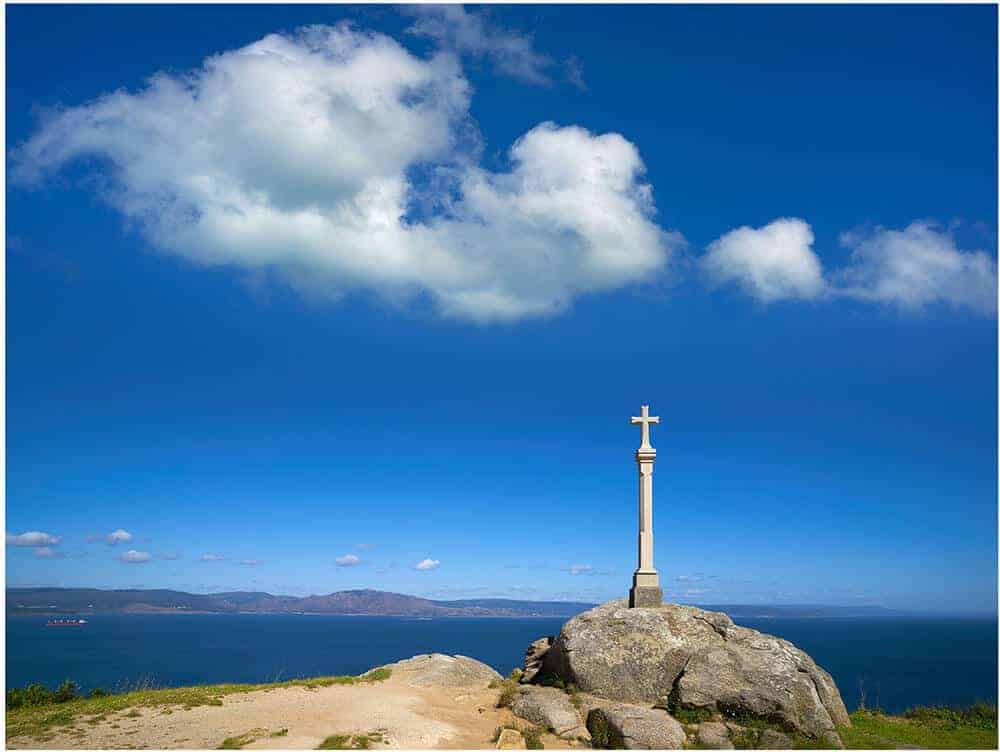
Many pilgrims on the Way of St. James will continue on after reaching Santiago and end their Camino in Finisterre. Of course, you don’t need to walk or cycle to get here. There are plenty of options to take a tour out to the coast or get a bus or shuttle.
Bring a picnic and some water with you because the cape has no shops, eateries or hotels. It is a beautiful wild destination boasting unspoiled nature and sea waves crashing into the rocky shores.
The main attraction of Cape Finisterre is the lighthouse . The Lighthouse of Finisterre stands on top of the peak of Monte Facho, a mountain on the cape. Come prepared to enjoy the ocean breeze, picturesque sunsets and Celtic spirituality. Right alongside the cape, there is a quaint fishing village by the name of Finisterra. It is a perfect stopover for travellers to get some rest and enjoy fresh seafood.
6. Casa do Cabildo house and Praterias square
Galicia is well-known for its Baroque architecture, and one of the best examples is Casa do Cabildo. This hidden gem sits on the southern side of Platerías Square.

The aristocratic residence was built in 1758 and is today a cultural and historic landmark and museum. The house is only accessible to the public during exhibitions.
7. Join a Santiago de Compostela Walking Tour
The best way to discover a city is by foot, and there are plenty of excellent walking tours available in Santiago. Ask at your accommodation for their recommendations or look online to find an option that suits you. From free walking tours (you are expected to tip) to tours focusing on food and wine , and museum tours to kid-friendly walks, there is something for everyone!
You will also find tours that focus on the history and myths of the famous Camino de Santiago .
8. Alameda Park
Alameda Park is a lovely sprawling park right in the heart of Santiago de Compostela. The park has over 90 types of plants, a flamboyant statue of the Fandiño sisters, and scenic walkways. This is the perfect place to soak in some nature and take a breather from the hustle and bustle of the city.

From Paseo da Ferradura, you get fantastic views of the Cathedral. While you can visit the viewpoint any time of the day, the views of the city are most spectacular at nighttime. The park also hosts many festivals annually, so ask your accommodation provider or check online for what might be happening during your visit to Santiago de Compostela.
9. Explore the Seaside Town of Vigo
Santiago de Compostela is not just about museums and churches. There are so many more things to do. It is also excellently located for day trips to the surrounding countryside.

Travellers who want to experience the charm and peace of an old town should take a day trip to Vigo. The fishing town lies along the shores of the Atlantic Ocean and is a place filled with warmth and beauty. You will find many cultural attractions and archaeological monuments here, as well as fantastic food!
10. Experience Galician Culture
The city of Santiago de Compostela is the hub of Galician cultural life. From religious festivals and poetry recitals to contemporary exhibitions and theatrical performances, there is so much going on in the city that will fascinate you.

You can learn loads about the development of Galicia through its food too, so make sure to explore local shops and eat what the locals eat. Try some of the delicious canned foods – canning is a huge industry in northern Spain! Munch on delicious pastries from the many bakeries, and listen to the world go by. See locals doing their shopping in the historic Mercado de Abastos and pick up some gorgeous products for yourself too!
Our biggest recommendation for things to do in Santiago de Compostela is to spend some time looking online for events, gigs, festivals, and other activities that are popping up when you arrive.

Check out the Galician Tourism website and the Spanish Tourism website for up to date information on opening times and events that are happening in Santiago.
You can also listen to our podcast about the top things to see and do in Santiago de Compostela here –
Santiago de Compostela and the Camino de Santiago
The Camino’s full name roughly translates to “the road to Saint James”, the Saint that Santiago is named after. His relics lie in the cathedral and are the endpoint of the pilgrimage. You can learn more about Saint James on our blog .
Each year, over 300,000 pilgrims and thousands of tourists visit Santiago. Pilgrims cycle or walk to the city via the ancient routes , and tourists arrive by plane, train and bus.
To join these pilgrims on the Way of Saint James to Santiago de Compostela – get in touch with us ! We can offer you a customised itinerary to suit your style and the length of time that you have available. Whether you are looking for a long weekend on the Way or a month or more walking a full Camino route, we can help.
Buen Camino!
The Camino is Open for 2024 Bookings!
Get in now to secure the best accommodation for your camino, discover this empowering journey across spain, portugal and france for yourself. journeys from 3 to 90+ days available., flexible itineraries luggage transfers private rooms & bathrooms, related posts.

Subscribe to our blog
Download free camino guide.
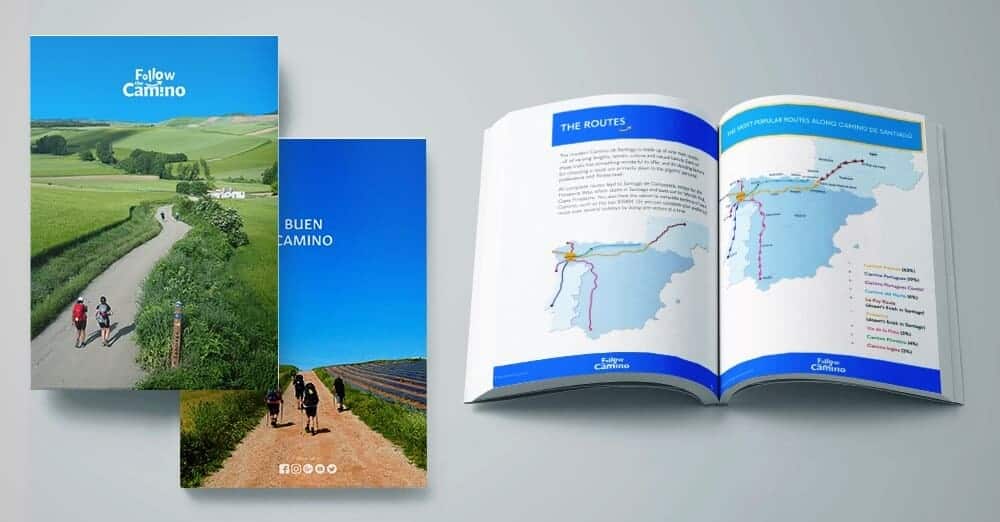
Get FREE Camino de Santiago tips
Start Planning Today and Get 10% OFF
- Santiago de Compostela
30 Fun & Unusual Things to Do in Santiago de Compostela

- 4 Pinterest
Drawing in thousands of people on foot through the famous Camino de Santiago, and offering a delicious introduction to Galician culture through food, history, culture, and tradition, Santiago de Compostela is a must-visit destination to visit in Spain’s repertoire of incredible cities!
Adventure your way through Santiago’s history and tradition by admiring the Cathedral of Santiago de Compostela, the final resting place of one of Jesus Christ’s apostles, St. James, and then make your way around Praza do Obradoiro, and try to spot out the “kilometer zero” plaque!
Tucked away in Spain’s northwesternmost region of Galicia, take advantage of the incredible day trip ideas available to you, from exploring the dramatic nature at Ribeira Sacra, or the stunning Cíes Islands for a truly breathtaking view of the wild Atlantic and jagged coastline.
Indulge in regional cuisine on a food tour, trying dishes like Gallega-style octopus and Gallega-style stew, delicious Albariño wine from the Rias Baixas area, and much more!
So, if you’re liking what you’re reading, let’s continue covering the best things to do in Santiago de Compostela for you, and your epic travels!
1 – Admire the Porch of Glory at the Cathedral of Santiago de Compostela

Built in 1075, the Cathedral of Santiago de Compostela is known as one of the most important religious structures in Spain, as it’s the final stop on the famous Camino de Santiago pilgrimage.
Said to house the remains of St. James, one of Jesus Christ’s apostles, the stunning medieval and romanesque style cathedral is also famous for the Porch of the Glory, (Pórtico da Gloria), which is a structure on the west side of the cathedral of 200 biblical figures.
Those who are of the faith may be interested in the ceremony “Hugging the Apostle” which is a tradition available to anyone interested in visiting the dressing room of the Apostle Santiago between 10:30 AM – 9:00 PM.
Also worth checking out is the Botafumeiro, a giant incense burner from the 19th century!
- Cathedral of Santiago de Compostela tours
2 – Take a self-guided tour of the Praza do Obradoiro

Walk upon the most famous plaza in Santiago de Compostela, the Praza do Obradoiro, where you’ll find some of the most famous sights in the city, including the Cathedral to the Pazo de San Xerome, the Paxo de Raxoi (town hall), and even a historic hotel specifically built for tired pilgrims during their pilgrimage.
Located in front of the Cathedral, today’s plaza is overflowing with delicious restaurants and cafes, offering visitors one of the best views in the city’s heart! Enjoy a walk through the plaza, admiring the courtyards, the buzz of the locals passing by, and a 17th-century college originally built to educate the poor.
Lookout for the “kilometer zero” sign in the middle of the plaza, indicating the final site of the Camino de Santiago!
3 – Get a taste of the Pilgrimage Experience and walk the last 10 kilometers to Santiago

So maybe you’re interested in getting a bite-size taste of what it takes to walk the Camino de Santiago, but you don’t want to do the whole thing?
Check out the Pilgrim for a day experience , where you’ll get to walk the last few kilometers of the trail with the help of a guide and see what the pilgrims see when they start to arrive in the city after a long trek!
Learn about the religious significance of this holy pilgrimage, and hear incredible stories from the experience. By the time you arrive at Praza do Obraidoro, you’ll be received with a grand welcome and congrats for completing the Pilgrim for a Day experience!
After all that walking, don’t forget to give your body some care and relaxation with a special pilgrim massage .
- Camino de Santiago – the final stage
4 – Take in the architectural beauty of the Hostal de los Reyes Catolicos

Built under the rule of the Spanish Catholic monarchy in the 16th century, the Hostal de los Reyes Catolicos was created to house tired pilgrims when they arrived at Santiago de Compostela on their pilgrimage.
The Hostal de los Reyes Catolicos is located in the famous Praza do Obradoiro, and stuns all with its Gothic style. When you step through the doorway, you’ll find two medallions with imagery of the Catholic Monarchs, and then follow the path into the incredible courtyard and the Chapel of Enrique de Egas, dedicated to the architect of the building.
Also known as one of the oldest hotels in Spain, whether you stay the night, or just pop in, the Hostal de los Reyes Catolicos is one of the best things to do in Santiago de Compostela to absorb the city’s famous history!
- Hostal de los Reyes Catolicos tours
5 – Walk amongst centuries-old oak trees at the Parque Alameda

Commonly referred to as just Alameda, take a beautiful morning stroll through the city’s main park, comprised of 3 different parts including the Paseo da Alameda, Carballerira de Santa Susana (Oak Grove), and Paseo da Ferradura.
The park and its stunning trails offer a peaceful disconnection from the busyness of the city while remaining close to the main sights like the Cathedral. Admire and breathe in the freshness of the carefully manicured gardens, quaint ponds with relaxing fountains, and plenty of benches to sit and enjoy the scene slowly.
While walking around, you’ll notice the statue of “As duas Marias” which are two Spanish sisters, showing a friendly and welcoming gesture at the entrance of the park. Their story is quite troubled, however many see their statue as a representation of marginalization and the fight for equality.
6 – Hit the Casco Antiguo (Old Town)

Marvel at the stunning Casco Antiguo (Old Town) and stop by some of the most famous sites around, from the Cathedral to the Praza do Obradoiro, Platerias Square, and its towering clock, amongst other sites!
The city is beloved by visitors and locals for its unique charm, specifically, its true-to-history atmosphere, with its similar architectural style throughout the town square, gallery-style balconies, and beautiful cobble-stone streets to get joyfully lost in!
Make sure to book a walking tour in Santiago to get a great overview of the city’s landmarks, plus check out a few hidden streets and corners of the city to spot the best tapas restaurants and more!
Walking tours are free, with a few paid options for a customized experience, so don’t hesitate to add a walking tour to your list of activities to plan on doing in Santiago de Compostela!
- walking tours in Santiago de Compostela
7 – Get into some medieval history on a Templars Tour

Join a templar tour and explore Santiago’s history of the Knights Templar, as you visit some of the most popular sites including the Corticela Chapel, Plaza de Cervantes, the Church of Santa Maria do Camiño, and many more sites!
Templars are known as religious military knights that protect and serve the pilgrims and other areas of the Catholic faith. They were prominent in Santiago de Compostela and therefore had specific areas throughout the city where they’d meet. They were known as one of the wealthiest military orders in Western Christianity.
As you stop by these religious buildings, you’ll dig more into the history of the templars in Santiago, and how they influenced the local culture and religious importance of the city.
There are a few free templar tours and others that also infuse other interesting topics!
- Templars tours in Santiago de Compostela
8 – Get cultured at the Cidade da Cultura de Galicia

Only 8 minutes away from the historic center of Santiago is the impressive Cidade da Cultura de Galicia , a cultural complex space housed inside a few modern buildings with a few notable spaces to check out!
From a grand library to the Museum of Galicia and more, you can also expect to attend live concerts, view traveling exhibits, check out a conference, or even sit in for a film screening or look at the artwork! With something happening every day of the week, you’ll never be bored or find a repeating event in this cultural space!
Join a tour of the space, and get a behind-the-scenes look at all that happens inside the space, including learning about the space’s architect’s design and inspiration. The space is open Monday to Sunday, from 8:00 AM – 10:00 PM.
9 – Visit one of the most popular Galician museums at the Museo del Pueblo Gallego

Get a glance at Gallego culture at the Museo del Pueblo Gallego, housed inside a historic convent from the 17th-18th century, which offers a great number of cultural relics and insight into the region’s history and ways of life.
From traditional wear to unique musical instruments, agricultural practices, and conventional home items, see how unique and beautiful the Gallego culture is, which has influences from both Spain and Portugal.
While visiting, check out the church and convent as well as the Panteón de Galegos Ilustres, which is a cemetery where you can find some of Galicia’s most prominent figures.
Make sure you don’t miss anything and opt for a museum tour where you’ll meet with your guide for an introduction to Galician culture from a local, which typically lasts close to 2 hours.
10 – Grab a fresh snack at the Mercado de Abastos

Enjoy a colorful display of the region’s freshest ingredients, from seafood to cheeses, vegetables, and more at the Mercado de Abastos (food market).
Considered to be the 2nd most visited site after the cathedral in Santiago, the Mercado de Abastos has been in function for at least the past 300 years, providing the locals with the freshest produce inside its stunning Romanesque-style building. Stop by some of the cafes and food stalls inside selling already-prepared Galician dishes to enjoy as you walk around the market!
The food market is a perfect place to mingle with the locals for a bit, and people watch to observe the scene of locals buying their groceries, just as they did a few centuries ago.
The Mercado de Abastos is located only a 5-minute walk from the Cathedral and the Praza do Obradoiro.
11 – Sink your teeth into Galician classics on a food tour

Speaking of delicious food and ingredients, a must-do activity in Santiago is a tasty food tour!
Known for dishes like boiled octopus with paprika, tetilla cheese, empanadas, and a special almond cake with the Cross of Saint James imprinted on it, there are tons of delicious foods to enjoy unique to this region of Spain.
When you book your food tour in Santiago de Compostela, you’ll be unlocking your entrance into some of the city’s most authentic and historic restaurants and bars around the city center.
Along your food tour experience, you’ll also be enjoying local Galician beers and Albariño wine, and afterward, you’ll leave with a sweet taste in your mouth with a stop at the local sweet shop Airas Nunes for a coffee and local pastry!
Food tours start at $38 USD.
- food tours in Santiago de Compostela
12 – See what’s inside the Praza da Quintana de Vivos

Step through the doors of the 17th-century Praza da Quintana de Vivos, a space that was created originally to host several town celebrations, including religious events with the pilgrims of the Caminos de Santiago.
Located within the Praza de la Quintana, the Praza da Quintana de Vivos (Alive’s quintana) is one of the other sections of the praza, including the Quintana de los Muertos (Death’s quintana). From here, you can take a view from different angles of the cathedral and the San Paio Monastery.
Check out the other sites inside the praza, from the abundant coffee shops and restaurants, many of which serve the traditional Torta de Santiago, an almond cake with the image of the Cross of Saint James in powdered sugar.
Check out other small shops, selling church relics, as well as city souvenirs!
13 – Plan to walk the Camino Finisterre

Embark on a mystical hike out west from Santiago de Compostela to Cape Fisterra on the Camino Finisterre!
Historically a walk that took a couple of days, the pagans would head to Cape Fisterra on what was known as the Coast of Death, and see as the sun “died” to which they’d say prayers and give offerings to appease the gods.
Today, you can make your way to this site to see the incredible Galician coast, and get views of the Atlantic Sea on a Costa da Morte tour from Santiago de Compostela. On your several-day journey on the Camino Finisterre, see the site of Ara Solis, the place where the prayers took place and where an altar stands today.
Next, stop at the fishing village of Muxia, a quaint town also famous for the site of the Sanctuary of the Virgin.
- Finisterre tours
14 – See one of the Romanesque churches in Santiago at the Colegiata de Santa María de Sar

Walk around the impressive 12th-century Colegiata de Santa María de Sar, a beautiful Romanesque church, 14 minutes away from the city center of Santiago.
Step inside, and see the intricacies of the church, from the beautiful relics to the construction errors and more, starting with the cloister and the inspiring gardens and arcade, to the slightly inclined interior walls.
Access the church museum inside, Museo da Colexiata do Sar, where you can see a great deal of 18th-century religious objects, as well as some fascinating information about the archaeological collection of the church’s foundation.
15 – Check out the religious items inside the Mosteiro de San Martiño Pinario

Make your way to the Moisteiro de San Martiño Pinario, located in Plaza de la Inmaculada, which was founded by a group of Benedictines, as soon as there was news about the findings of the remains of St. James.
After the monastery was established, it became part of the Benedictine Congregation of Valladolid, where a great deal of wealth came through, allowing the monastery to be built in a beautiful baroque style.
Considered to be one of the best examples of Baroque architecture in all of Spain, step inside the monastery, and check out a few other details within, such as the monastic rooms and the important religious altarpieces inside, and an exhibit of Galician art.
16 – Take a boat tour along the Galician waterways

Make your rounds through the scenic and sleepy coastal villages via water on a scenic boat tour! From the famous Rias Baixas to smaller towns like Padrón, Ila da Toxa, Cambados, and Comborro!
Leaving Santiago early in the morning, you’ll get to visit a few villages that not many get to see, where you’ll get to hop off the boat and explore some of the ancient histories of the towns, from crossing the longest European bridge to stopping by a few natural parks and beaches on the towns and islands!
Along your tour, stop by for a delicious lunch and then head to the markets to see locally crafted items from handmade soaps made of mineral salts, to the Capilla de las Conchas (Seashell Chapel).
Boat tours from Santiago de Compostela start at $43 USD and typically last 8-10 hours.
- boat tours near Santiago de Compostela
17 – Cruise through the Rias Baixas

Hop on board a panoramic boat tour through the southern coast of Galicia, through the Rias Baixas, known as a series of 4 inlets, and get enamored by the different landscapes, sites, and villages while stopping at a few for lunch and more!
Check out small towns like O Grove Town and breathe in the peace of the sleepy town, where you’ll enjoy a full lunch featuring fresh seafood and other regional dishes with Albariño wine. Afterward, you’ll also get to stop by local vineyards to sample a bit of the local wines, which Galicia is known for.
Next, you’ll visit the site of “La Lanzada” for a scenic walk, until reaching views of the dramatic coast to see the Atlantic Ocean and the picturesque houses on the mountains overlooking the edge of Spain.
Rias Baixas tours start at $55 USD.
- Rias Baixas tours
18 – Enjoy a libation or two on a wine tour

Relish a few of the regional wines, mostly coming from the Rías Baixas region on a delicious wine tour, with cheese tastings !
Learn from the winemakers what makes Galician wine delicious, and sample a good variety of both red and white wines, as you meet locals at the restaurant where the tasting takes place.
The tasting will take place in a central restaurant in Santiago de Compostela, so rest assured you’ll be able to spot it quickly!
On the other hand, if you want to experience wine country in the wild, check out Bodegas Grabazán , a Galician vineyard with ample activities to enjoy, including wine tastings, with mussels and cheese.
Enjoy a complete tour of the vineyard and winery, and then head into the tasting room to sample the wines produced by the local brand called Grabazán.
- wine tours in Santiago de Compostela
Read more: 15 Top Wine Regions in Spain
19 – Check out what’s happening at the Gaiás Centre Museum

Free to enter and full of different cultural events and activities throughout the year is the Gaiás Centre Museum, a modern and futuristic building that changes the historical landscape and offers numerous things to do in Santiago!
Consisting of 3 floors, the Gaiás Centre Museum has a beautiful art gallery, stunning murals created by local artists, concert spaces, reading rooms, and more within its bright and airy walls.
Opened from Monday to Sunday, from 10:00 AM – 8:00 PM, be aware that the exhibit space is closed on Mondays, and the museum has different hours of operation depending on holidays.
After you explore the interiors of the museum, make sure to check out the cafeteria and restaurant on the main floor.
20 – See modern Galician art at the Contemporary Art Center of Galicia

Tucked inside the historic center of Santiago is the Contemporary Art Center of Galicia (CGAC) an art museum dedicated to showcasing examples of regional modern art, as well as a few international pieces.
Step inside, and check out the Library of Contemporary Art, stop for a lecture, or an art workshop catering to all different ages, among the many different events that take place, allowing you to explore Galician culture through its art, and inclusively interact with modern art!
Want to get the most out of your experience? Check out one of the free guided tours offered to groups of 4+ people, available between Tuesday and Friday, 11:00 AM – 2:00 PM. Other than that, the CGAC is open between Tuesday – Sunday, 11:00 AM – 8:00 PM. Entry is free.
21 – Book your day trip to Ribeira Sacra

Home to Galician dry red wine and offering outstanding nature views of dramatic cliffs and mountains everywhere you look near the wild Atlantic, the Ribeira Sacra is one of Galicia’s best-kept secrets that you should consider visiting!
At only 1.5 hours away from Santiago de Compostela, Ribeira Sacra enchants with views of scenes of monasteries and homes dotting the canyons, along with its traditional and ancestral wine-making traditions.
From its natural beauty to its cultural richness, make sure to book your Ribeira Sacra tour to get an overview of the incredible Romanesque architecture that decorates the city, from its churches, monasteries, boutique hotels, and more!
Be taken to nature sights truly out of this world like the Balcones de Madrid, the Castro Caldelas viewpoint, and the Chantada Lighthouse, amongst many other notable sights in nature to see!
- Ribeira Sacra tours
22 – Kayak around the Ezaro Waterfall

Enjoy the unique experience of seeing the Ezaro Waterfall for yourself, the only known European waterfall and river that flows directly into the Atlantic Ocean.
Though it’s a popular site that many on the Camino de Finisterre pass by, you don’t have to go on a multi-day hike to enjoy the incredible views of this powerful waterfall! Consider a kayaking trip around the Ezaro Waterfall, as you follow and listen to your guide share with you all the interesting facts, myths, and legends that surround this mystical natural site.
On a kayaking tour, you’ll get a first-person perspective of the dense flora and fauna that lives near the waterfall, right as you are in the middle of it! Depending on the experience and time, you may even be able to jump in for a quick swim, so be prepared!
- kayaking near Santiago de Compostela
23 – Take a photo or two at Cathedrals Beach

One of the most beautiful images to come out of Galicia is the vision of the natural “naves and chambers” created by the force of the Atlantic Ocean on Cathedrals Beach.
Also known as As Catedrais Beach and Praia das Catedrais, this incredible site is located 2 hours from Santiago de Compostela, in the province of Lugo, and features transparent, blue waters all year round. Walk around, and see the resemblance for yourself of some of the towering, natural rock formations and what you’d see inside a cathedral!
Because this is a famous site in Galicia, it’s important to note that you have to make a reservation to visit Cathedral Beach or check out a planned day trip that takes care of that for you.
Check the forecast for low tide, as that is when the beach is open!
- Cathedrals beach tours
24 – See the stunning coastal city of A Coruña

Situated only 50 minutes away from Santiago de Compostela, A Coruña is one of Galica’s main port cities with exquisite views of the Atlantic Sea, and most famous for the Tower of Hercules, said to be the oldest Roman lighthouse in the world!
Explore the breezy Plaza de María Pita, the historical churches, and the stunning Gardens of San Carlos, and walk along the historic town spotting other amazing landmarks on a walking tour, and in your free time.
On your A Coruña tour, stop by the city of Betanzos, a stunning city stuck in its medieval ways as it was once part of the important 7 provincial capitals of the old Kingdom of Galicia. For lunch, you’ll try Betanzo’s famous Tortilla de Betanzos (omelet) prepared a little runnier than traditional Spanish omelet, and without onions.
- A Coruña tours
25 – Get educated at the Pilgrimage Museum

Learn all there is to know about the famous Camino de Santiago pilgrimage, considered to be one of the most popular pilgrimages in the world to do, with an estimated 350,000 people doing it annually!
At the Pilgrimage Museum, located inside the Bank of Spain building in Praza das Praterias, you’ll find a wealth of information, stories, and histories dating back to the origins of this famous walk, to answer everyone’s question of why people do it.
The museum does a great job of collecting artifacts, materials, objects, and all sorts of information to display at the museum, to educate those who may not know about the pilgrimage, in its permanent exhibits.
Other exhibits showcase some of the world’s other popular pilgrimages, further opening up your mind to this fascinating cultural phenomenon of walking long treks for religious meaning.
26 – Check out the medieval cities of Vigo and Baiona

Book your tour to explore more of Galicia’s enchanting corners, this time Vigo and Baiona, two important medieval towns with much to see both in town and in nature.
Vigo is known as the largest city in Galicia, and one of the most important port cities in all of Spain, with incredible views of the wild Atlantic Ocean. As for nature, you’ll get to visit Monte do Castro, and if time permits climb up the mountain and see even more wide views of the ocean and the incredibly green landscape of the mountains!
Next up, Baion is a beautiful little town doused in medieval charm, starting with its charming castle and historic center. Here is where you’ll enjoy lunch, in which you must give the local seafood dishes a try!
Vigo and Baiona tours start at $42 USD.
- Vigo and Baiona tours
27 – Take the ferry to Cíes Islands

Set on the panoramic Vigo estuary is the archipelago known as the Cíes Islands, made up of three islands that house stunning natural parks on the Atlantic!
With awards like “The Best Beach in the World” and repeated good reviews from past travelers, it’s safe to say that a visit to the Cíes Islands is a must-do when you’re near Santiago, only 1 hour away from Vigo, and then a 45-minute ferry to the islands.
Consider booking a Cíes Island tour, get picked up from Santiago, and head to the islands for a full day of fun excursions! Start at the Atlantic Islands of Galicia National Park, and then check out the award-winning beaches on the island of Monteguado.
Lastly, get a view of the whole archipelago when you visit the Cíes Lighthouse for the best photo op on the islands!
- Cíes Islands tours
28 – Visit the Celtic wonderland of Pazo do Faramello

Visit the heritage home of Pazo do Faramello, a stunning historical building surrounded by a dense cherry and chestnut tree forest, two rivers, and a gorgeous 19th-century French garden, setting the scene for a romantic escape!
Situated on what was the old Portuguese Camino de Santiago, the Pazo do Faramello is only 15 minutes away from Santiago de Compostela, and lucky for you, there is a Pazo do Faramello tour that includes ground transport, a guide, and even a sampling of local products and wine!
Tuck inside the historic Royal Faramello Paper Pill dating back to 1710, which is mentioned in a few Galician literature pieces, while immersing yourself in the Celtic influence that still lingers on the property.
Step inside the house, and see pieces of artwork and the chapel with antiques of the house’s past lives, and more!
29 – Enjoy to the fullest a traditional Gallega dinner

Are you down for some spooky stories and a delicious Galician dinner? Then you must make room in your Galician itinerary to explore a traditional Gallega dinner with an addition of a walking tour where you’ll walk the streets of Santiago at night, listening to the local legends that seem to haunt the streets as soon as the sun goes down.
On this unique experience, you’ll get to devour traditional local dishes like Pulpo á feira (Galician-style octopus), Galician empanadas, Lacón con grelos (pork shoulder with turnips), grilled meat dish varieties, and the special Cocido Gallego (Galician stew).
After dinner, continue on your tour, and participate in an ancient tradition of Queimada, used to “speak” with the ghosts using a regional drink in a special ritual!
The tour involves alcohol, therefore the tour is not recommended for anyone under 18.
- traditional gallegan dinner
30 – Find your new favorite dish at the best restaurants

Enjoy a delicious meal on an open terrace when you hit up Abastos 2.0 , located within the famous Mercado de Abastos, featuring a great range of Galician dishes! Expect high-quality ingredients, including fresh meats and seafood, in its seasonally rotating menu!
Relish the warm and unique interiors of the Casa de Xantar O Dezaseis , a fabulous restaurant serving incredible Galician dishes, specifically seafood, from prawn croquettes with garlic to queen scallops with caramelized onion and a regional cheese called Arzúa, and mussels in a citrus marinade. Another great place for seafood? A Taberna do Bispo , which also features a great selection of Portuguese wines!
Go where the locals go at Don Quijote , a Michelin-starred restaurant beside the Cathedral, that’s been a local favorite since the late 70s! Serving dishes made with historic recipes from the region, with an added twist, you’re going to be in for a treat!
How to get to Santiago de Compostela?
Before arriving at Santiago de Compostela Airport (SCQ), be sure to look into pre-booking an easy and convenient airport transfer to your hotel in the city! Available at different price points, an airport transfer is the best option that you can prepare ahead of time, without worrying about where to catch the bus or hail a taxi!
Where to stay in Santiago de Compostela?
Overlooking the gorgeous historic district of Santiago de Compostela, check out Hotel Montenegro Compostela and its 16th-century charm. Situated in one of the historic buildings in the city center, this hotel integrates modern comforts like the indoor Montenegro Cafe, tv, and high-speed internet within its traditional style, true to the city’s beauty.
Hotel Virxe da Cerca by Pousadas de Compostela is another wonderful option and is only a few moments away from the Mercado de Abastos and the Cathedral! Dine deliciously at the hotel’s indoor restaurant, featuring a complete menu of Galician classics and a few modern twists on the region’s award-winning gastronomy.
Enjoy the comfortable and sleek rooms and ambiance at Hotel Universal , located in the heart of the historic center of Santiago de Compostela! Featuring stunning views of the city’s most recognizable sights, stylish interiors, clean rooms, and a wonderful staff to take care of you!
- best hotels in Santiago de Compostela
Visiting Santiago de Compostela on a budget?
Get an understanding of the city first on an educative and fun free walking tour in Santiago de Compostela ! Enjoy a few hours of walking through the city’s historic sites discovering a few hidden gems and neighborhoods, as you learn from your local guide the city’s best-kept secrets while learning the lay of the land!
Where to go next?
A little under an hour away from Santiago de Compostela is the westernmost city of Vigo, enamoring visitors with its fresh seafood dishes, stunning historic district, wild nightlife, and incredible museums housed in a 17th-century heritage house like the Quiñones de León Museum!
In A Coruña, get nerdy at the National Museum of Science and Technology, get your picture with the city’s emblematic Hercules Tower, and relax for a while amidst the locals at the city’s main plaza, the Praza de Maria Pita!
Relish the Gothic architecture of the Igrexa da Virxe Peregrina and a few other holy sites in Ponteverde! Check out the bustling local food scene at the city’s own Mercado de Abastos, and then after a hearty meal, walk it off at the stunning Parque das Palmeiras.
Yell “Kaixo” to Bilbao from the tops of the gorgeous Mirador de Artxanda, pop into the city’s most beautiful and historic churches like Begoñako Basilika, while also getting a taste of the modern with a stroll through the Zubizuri bridge.
Drink port wine and enjoy the incredible views of the Duomo River when you stop by Porto in Portugal! Enjoy the views of the city from a bird’s eye perspective at the Clérigos Tower in the center, and see if you can spot the city’s crystal palace at the Crystal Palace Gardens!
Final thoughts
With a history doused in religion and human faith, and welcoming everyone to enjoy its charm, Santiago de Compostela is surely a Spanish hidden gem worth learning and exploring more!
When planning your list of the best things to do in Santiago de Compostela, make sure to loop us in and share what made it on your itinerary!
Happy travels!

One Day in Santiago de Compostela Itinerary – Top Things to do in Santiago de Compostela
If you are doing Camino de Santiago pilgrimage, seeing Santiago de Compostela is a spiritual and meaningful experience that celebrates and shows your dedication and personal power. But even if you are just passing by, Santiago de Compostela is a city worth seeing because of it’s gorgeous architecture, the breathtaking Cathedral, unique bars and inspiring people-watching journey. This place will change you, whether you are just passing by or staying a few days, if you find yourself in Spain – do not miss a chance to visit Galicia and Santiago de Compostela.

Best Time to Visit Santiago de Compostela
The best time to visit Santiago de Compostela is between March and May or between September to November . Winters are mild but it gets cloudy, rainy and windy. Summer season has great weather but it brings crowds and the heat.
A Few Facts About Santiago de Compostela
- Santiago de Compostela is one of the three major Christian pilgrimage sites
- The legend says the town is the burial place of St James the Greater, patron saint of Spain, first Christian martyr, and one of the Twelve Apostles
- Camino de Santiago routes and the old-town center are both UNESCO world heritage sites
- If you want your Compostela certificate, you must walk at least 100 kms into Santiago
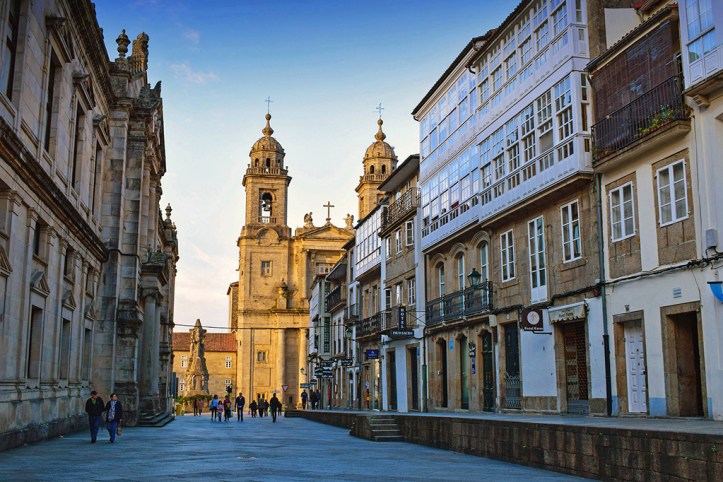
What to do In Santiago de Compostela in 24 Hours
S antiago de Compostela is big enough to have just about anything you need, but small enough to feel like a friendly and welcoming community. You can see the whole city in one day but the spirit of Santiago de Compostela will lure you in to wanting to stay longer! However, if you only have 24 hours in Santiago de Compostela, here are some ideas on how you can make the most of your time there.
Start Your Day at Santiago de Compostela Cathedral And Plaza del Obradoiro
The Way of St. James, often known as the Camino de Santiago, is a network of historic pilgrimage paths that crisscrosses Europe and ends at the tomb of St. James (Santiago in Spanish) in Santiago de Compostela. Once you check in your hotel , the star of Santiago de Compostela is its Cathedral.

Every day, more than 10,000 visitors come to visit The Cathedral of Santiago. Not only is it impressive to look at, but you can just stand in front and people watch for hours! The full tour includes the museums, the tribune, and the climb to the roofs, but the access to the main area is completely free. If you are visiting the Cathedral for the first time there is a ritual: see the Portico de la Gloria, hug the Saint James figure, go down to the crypt, and finally up to the rooftop!

Once you’ve done this, you can find the Museum of Santiago and the Pilgrimages near the Cathedral – if you want to know more about Camino de Santiago and it’s history definitely check it out. It might inspire you to try it yourself!
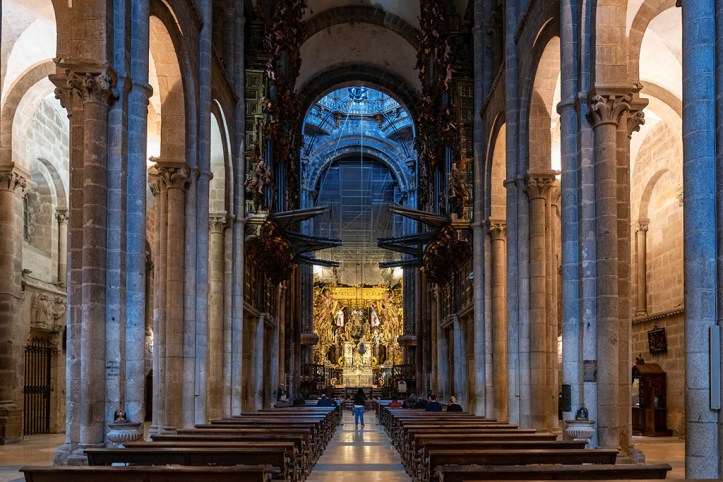
Explore Mercado de Abastos
Down Virxe da Cerca street, which runs north to south through the old walled city, lose yourself in the market has been held every week since 1873. The current market complex was built in the 1940s, and the eight halls’ granite walls and whitewashed barrel-vaulted ceilings are reminiscent of the nearby church.

Around 70 different vendors run their businesses out of the stands in these halls, selling everything from just caught fish and shellfish to fresh fruits and vegetables (many of which are grown in Galicia’s northwest region). Even if you don’t like shellfish, it’s fun to wander by the ice beds and see the bright, striped fish, the scallops that are Santiago’s national symbol. There is no better spot to find authentic Galician goods like cured meats, soft cheeses, empanadas (savory pies), and homebrewed wine!

Take a Walk Through The Historic Center
Santiago de Compostela is extremely picturesque, everywhere you go seems to resemble a sort of a fairytale. Spend a part of your 24 hours in Santiago de Compostela getting lost in the old town.

Countless restaurants and bars where you can enjoy the delectable seafood of Galicia, an old town center that is a UNESCO World Heritage Site, daring contemporary art ,charming squares like Praza das Praterías (with the best view of the belltower, La Berenguela), or Praza da Quintana with its pretty stairs, as well as other monuments like the Monastery of San Martiño Pinario. Stop in all the shops – they have so many interesting things to see. From religious souvenirs to historical artifacts, from colorful interesting clothes to incredibly unique art!

See The Faculty of Geography And History
Often missed by travelers because it’s not exactly a monument, this place is definitely worth seeing. It’s located in the old town near the Cathedral, and it’s a perfect spot to go for some quiet time. The most magnificent of all buildings is Compostelana University and its rooms include the Central Hall (decorated with frescoes by Fenollera and González), the Rectorship (with a fabulous 17th century stall), and the Libraries. If you are a digital nomad or just want to get away from the crowds, you can study or work in the library. The library itself is amazing – even if you don’t have work to do- check it out!

Stop for a Bite at Casa Manolo
There are plenty of places to eat in Satiago de Compostela, but the one we recommend for lunch is Casa Manolo. You will find the place packed with pilgrims tired from their recently finished journey and you will find huge portions for a good price! Casa Manolo is a restaurant located in an incomparable setting within the old town of Santiago de Compostela, known worldwide among the pilgrims who come to the city, its traditional Galician food at a good price has made it famous to be selected in multiple guides as a necessary place of passage on the way. After that have a coffee in one of the many cafe’s around and continue your one day in Santiago de Compostela.

Visit Contemporary Art Center of Galicia
Some of the best views of Santiago de Compostela’s old district may be seen from the terraces of this unusual museum. The Galician Contemporary Art Centre (CGAC), designed by Portuguese architect lvaro Siza, is a striking structure. It creates a harmonious ensemble where the historic and modern aspects of the city merge, along with the San Domingos de Bonaval Convent and the corresponding park. Visitors can see works by modern Galician artists in addition to the Arco Foundation collection, as well as a variety of transient shows focused on the current major trends in art. The center features a number of rooms for both ongoing and one-time exhibits, as well as an auditorium, a library, a café, and office space.
See Casa do Cabildo
Constructed in 1758, this lavish aristocratic palace is recognized for its magnificent facade and it is one of the best examples of Baroque architecture in the Galicia region. The structure is situated on the Plaza de las Plateras (Praza das Praterías) with a large fountain in the middle. In his work “Mi Hermana Antonia”, Spanish author Valle-Inclán describes how the Casa del Cabildo served as inspiration. The structure underwent renovation in 2011 and was transformed into an exhibition room; the monument is a part of Santiago de Compostela’s association of museums. When there are art exhibitions held here, the Casa del Cabildo is accessible to the general public.

Watch the Sunset at the Parque da Alameda
Close to the Old Town, this beautiful and lush park, which is a must see in Santiago de Compostela. Both locals and tourists enjoy the gorgeous views of the Cathedral and the city! The park dates back to the 16th century, is a significant component of the urban landscape of the city and provides stunning views of the west front of the cathedral.

The Parque de La Alameda is a haven for Mediterranean vegetation, subtropical species, exotic blooms, and a wide range of roses. The eight-hectare park’s three distinct gardens and notable structures like the Iglesia de El Pila r (1717) and the well-known Porta dos Leóns (Lions entrance), carved in 1835, are among its many outstanding features.

Spend The Night in One of The Interesting Bars
There is a surprising amount of places to eat and drink in Santiago de Compostela. Every little alley has a cool bar, tapas restaurant or a cafe. But we’ve tried a few we really liked! The first one is Paraiso Perdido . A very interesting bar with a long history in Santiago de Compostela. You will find many locals here!

If you are in Santiago de Compostela on a monday or tuesday however, Paraiso Perdido is closed. In that case our second place goes to Modus Vivendi – the first pub in Galician history! Amazing for live music and live theater shows. Definitely check it out! And the third place goes to Fuco Lois where you can have reasonably priced drink in a great atmosphere, we loved it!
Where to Stay In Santiago de Compostela

Hotel Montenegro Compostela
Rúa de Xelmírez, 18, 15705 Santiago de Compostela
The elegant rooms of the Hotel Montenegro Compostela are housed in a 16th-century townhouse and are situated in the picturesque old town of Santiago de Compostela. Original elements like exposed stone walls and beamed ceilings are blended with contemporary white furnishings in each room at the Hotel Montenegro Compostela. Within 100 meters of the hotel are Santiago’s renowned cathedral and the terminus of the Camino de Santiago pilgrimage route. It takes five minutes to walk to Monte da Almáciga Park, and there are lots of eateries nearby.
BOOK A ROOM HERE

Hotel Praza Quintana
Rúa da Conga, 9, 15704 Santiago de Compostela
The Cathedral of Santiago de Compostela, Plaza de las Plateras, Plaza de la Quintana, and Plaza del Obradoiro are all within a minute’s walk of the opulent Hotel Praza Quintana , which is situated in the heart of Santiago de Compostela’s historic district. On the fourth level, with sloping ceilings and a partial view of the Cathedral of Santiago de Compostela, are the rooms with views.

Rua Das Galeras, 18, 15705 Santiago de Compostela
In the center of Santiago de Compostela, near public transportation, the Hostal Costa Azul provides accommodations that are family-friendly and good if you’re on a budget. A communal bathroom and heating are provided in each room. There are some rooms with the views of the Cathedral. Hostal Costa Azul is 300 meters from Santiago de Compostela Cathedral, and the tourism office is 700 meters away.
Day Trips From Santiago de Compostela
Just an hour away from Santiago de Compostela, situated beside the Atlantic Ocean, A Coruña is a beautiful city whose history has maintained close links with its old fishing and commercial port. The Aquarium Finisterrae, Domus and the Science Museum are a few of the spaces that show the more modern and playful side of the city of A Coruña, which offers one of its most beautiful scenes on the wide Riazor and Orzán beaches. The food of A Coruña combines the best of the coast and the interior!
An hour south from Santiago De Compostela. Everything is within walking distance in Pontevedra, and there is a ton to see. Real treasures, such as the superb jewelry dating back 4,000 years and the collection of gold and silver objects at the Museum of Pontevedra, which is unique in Europe. Additionally, there are other gems like the Church of Santa Maria, the Santo Domingo Ruins, and the Church of San Bartolomé. There are parks, tree-lined streets, riverside walks right in the midst of the city, and Galicia’s most significant historic district after Santiago. populated squares with fountains and gardens, stone homes with coats of arms on their facades, and sidewalk cafés with a vibrant ambiance that lasts into the early hours.
The city that gives the Ras Baixas’ southernmost estuary its name, Vigo, is located in the Galician province of Pontevedra on the coast of the Atlantic Ocean. A historical neighborhood with a distinct nautical flavor has been left behind from its fishing roots, which contrasts with the contemporary amenities of its marinas. The cities and villages along the Vigo estuary and the Cés Isles, which are a part of the National Park of the Atlantic Islands, may both be visited from this city very easily. An additional reason to visit this area is the cuisine, which is based on fish and shellfish, the best in Galician coast!
Finisterre (Fisterra) – End of The World
On the rugged Costa da Morte is a fabled location known as Finisterre, or Fisterra in Galician. The Romans, who considered the settlement to be “the end of the world,” gave it its name. Today, Finisterre serves as many pilgrims’ camino’s conclusion, where they watch the sunset and burn their garments in a ritual to commemorate their rebirth. Cape Finisterre has one of the most stunning sunset in the world! It should come as no surprise that one of Europe’s westernmost locations would have a spectacular sunset, but it’s even more spectacular than you could imagine. Additionally, Cape Finisterre is located at a significant altitude above sea level so you have a magnificent view of the ocean from the cliffs near to the lighthouse. In June the sun sets at approximately 11.30 p.m, just before midnight!
Extra Tips for Visiting Santiago de Compostela
- Spanish siesta – in Galicia and rest of Spain businesses and stores close between 2 and 4 p.m.
- Lunch and dinner hours – lunch is at around 2:00 – 3:00 pm, after that most places close the kitchen. Dinner starts around 9pm in the winter and even later in the summer – so plan accordingly!
- Bring an umbrella – if you happen to be in Galicia anytime but the summer – bring an umbrella, it rains a lot!
- Spanish and Galician Language – locals speak Spanish and Galician language, Galician is closest to Portuguese, but it reflects influence from Spanish.
Make sure you have everything you need
What to pack for your next trip.
Make your next trip as simple and as enjoyable as possible by packing smart. It’s amazing how much stress top travel items can save you, so choose carefully. Things like lightweight travel backpacks, for example, are ideal for short trips and allow you to move around with ease, and a passport holder will make sure you keep your documents safe at all times. Check our travel checklist guide for 2021 to make sure you haven’t missed anything, and travel to your next destination in style and with maximum comfort.
Related posts:

Romi is a llama coach from Split, Croatia. This sounds made up but it’s true. She lived in Toronto, Canada for about ten years, give or take, but she wasn’t working with llamas. She was working in PR, restaurants, daycares, one yoga clothing store. She doesn't know how she got that job as she has never done yoga at that point. She taught English in Colombia and Vietnam. Traveled the world for two years. Then she got into writing. Actually, she was always writing, but then someone paid her to write. Then more people paid because they saw she was making them money. Then it became a thing she does for a living. And here we are now. Specializing in travel, real estate, and digital nomad guides, familiar with SEO, and always ready to learn something new so she can branch out and take over the world.
Leave a Reply Cancel reply
Your email address will not be published. Required fields are marked *
Save my name, email, and website in this browser for the next time I comment.
Notify me of follow-up comments by email.
Notify me of new posts by email.

Home » Travel Guides » Spain » 15 Best Day Trips from Santiago de Compostela
15 Best Day Trips from Santiago de Compostela
Santiago de Compostela is one of the most historic and religiously important cities in Spain. This small city is the heart of Galicia, and it’s well known as the end point of the famous long-distance walking route, El Camino de Santiago, a route that for centuries has been taken by pilgrims and today, tourists too.
Santiago de Compostela is said to be the final resting place of Saint James, one of the original twelve apostles. For that reason, the city has held a prestigious place in Spanish history.
More than this though, Santiago de Compostela is in the perfect location to make it a great base for exploring the rest of Galicia.
The wild Atlantic coastline is just a short drive away, and here you can find rural fishing villages, incredible scenery and enormous waves.
The cities of Leon or A Coruna are not too far a journey away, and you could spend an eternity exploring the local communities in search of food, tapas and good wine, which you are sure to find everywhere.
To the south, the Portuguese border is never too far away. Cross over and you can easily reach the dynamic cities of Braga or Porto on day trips from Santiago de Compostela.

The city of Vigo is on the Galician coast, just an hour to the south of Santiago de Compostela. This is the largest city in the wider region of Galicia, and it’s must-do day trip while staying nearby.
The historic centre is a great place to learn more about Vigo, stroll through medieval streets, visit wonderful museums, and eat as much tapas as you can lay your hands on. Really though, the city is as much about its incredible setting as it is about its history.
The city faces out over the beautiful Bay of Vigo, and nearby you can explore the exceptional coastline, hike along rugged cliffs or sit back on some of Spain’s amazing but unfairly underrated beaches.
2. Cies Islands

These islands are located off the coast of Vigo. This collection of spectacular islands is part of the larger Atlantic Islands National Park, but are some of the most accessible and beautiful of the areas protected within this aesthetically striking offshore landscape.
The Cies Islands would look more at home in the Caribbean than off the coast of northern Spain. Picture white sand beaches framed by rocky cliffs which gaze across colourful, clear bays and inlets.
There are three main islands within the Cies Archipelago and you can easily reach them from the port of Vigo.
The island of Monteagudo has even been said to be home to the best beach in the world by notable media organisations.
3. Cape Finisterre

To the east of Santiago de Compostela can be found ‘The End of the World’. This is Cape Finisterre, a windswept peninsular that juts out far into the Atlantic Ocean.
The name is derived from the Latin term for the end of the world, as this is where the Romans, during their conquests of Galicia, believed the world literally ended.
This Cape marked the end of the Roman world. In its dramatic, rocky and strangely beautiful way, you can imagine why they believed this when you stand at the edge of the cliffs and look out over the seemingly endless expanse of water ahead of you.
4. Pontevedra

Pontevedra is a small city located to the south of Santiago de Compostela. This city is about as picturesque as you can get in Galicia.
The streets and buildings sprawl along green hillsides and reach the wide banks of the river below. The historic centre is completely pedestrianised, allowing you the freedom to stroll at your own leisure through the ancient alleys, cathedrals and museums. The most striking sight to see is a panoramic view of the iconic bridges that span the river, which could be one of the most beautiful scenes in Galicia.
5. Combarro

Combarro is a small village that’s located just long the coast from Pontevedra. This is a rural, seaside community that offers visitors an authentic look at Galician life as it has been for centuries along the coast.
This is very much still a fishing village, despite its increasing popularity amongst tourists. You can explore the ramshackle streets and the old harbour to really experience the local charm.
Watch the boats returning from the Atlantic with their hauls, admire the distinctive architecture of Combarro, and sample some local delicacies in the tavernas and bars.

Northwest of Santiago de Compostela is the coastal town of Muxia, a place which is becoming one of the most popular day trips in the region.
This is one of the towns along the infamous Coast of Death, a long stretch of shore that through the centuries has been plagued with shipwrecks and shipping disasters.
From the town, you can gaze out across the violent waves and see why this place has caused so much anguish amongst mariners.
For pilgrims, Muxia has long been an important destination too, as this is a stop along El Camino de Santiago. For centuries, religious travellers have visited Muxia to see the shrines and hermitages that are found here.
7. A Coruna

Follow the Coast of Death further to the north of the village of Muxia and you reach the city of A Coruna.
This is one of the largest cities in Galicia and is arguably the most important, having been the Kingdom of Galicia’s capital for many years in centuries past.
Known as the ‘Celtic City,’ along the coast here you can find many examples of ancient Celtic ruins.

Ezaro is a rural community found an hour towards the coast from Santiago de Compostela.
The village is known for the nearby waterfall, Cascada del Ezaro, which is known as an iconic natural feature of Galicia.
The staggeringly tall waterfall reaches heights of 155 metres.
The many multiple layers add to the natural spectacle and ensure that this is a popular day trip to make.
9. Cambados

Cambados is a charming town that’s located near the city of Pontevedra.
It’s a wonderful day trip to make from Santiago de Compostela, particularly for wine lovers.
This colourful town is the base for the region’s main wine production.
In the countryside, you can explore the wineries and see fields of grapes and vines dotting the landscape, while in Cambados itself you can visit the many local wine sellers stocking local bottles, or wash down some fresh seafood with a glass or two of vintage.

Inland of Santiago de Compostela, to the east, is the city of Lugo. This is an ancient city, with a heritage that dates back to the Celtic era.
The Romans, though, were to leave the longest-standing mark on Lugo, as the huge defensive walls that they built are still a prominent feature of the city and attract tourists from across the world.
Explore the walls and the incredibly well-preserved Roman ruins before enjoying some local tapas in the many tavernas in the old city.
11. Ourense

Ourense is a relatively unknown city when it comes to tourism in Galicia, but that’s all the more reason to call in for a visit.
The town was established here by the Romans, who built the beautiful arched bridge that still spans the river and who flocked here to take advantage of the natural hot springs that bubble out of the ground.
Today, one of the best activities in Ourense is still a visit to the Roman Baths, and you can sit back in the warm, geothermal waters and relax after a day spent exploring the city.

Oviedo is a good drive north and then east from Santiago de Compostela, but it’s worth the long journey to experience a different side of Spain, as this is the capital city of the Asturias region.
This city dates back to the middle ages and is home to some lovely medieval architecture, including cathedrals and rambling historic streets. These are fantastic places to spend the day exploring, and subtly different to what you see in the cities of Galicia.

Leon is around 3 hours away from Santiago de Compostela. This makes for a slightly longer day trip, but an excellent opportunity to experience the long history of this important Spanish city.
You can also explore the renowned Gothic-style architecture of the historic centre, much of which is recognised as a UNESCO World Heritage Site.

Two hours south of Santiago de Compostela and just across the Portuguese border is the city of Braga.
This is one of the biggest cities in northern Portugal and has played an important role in local history, particularly when it comes to religion.
There are many elegant cathedrals as well as some excellent Portuguese architecture to discover in Braga.

Further south, along the Portuguese coast, you can visit the large city of Porto on a day trip from Santiago de Compostela.
It’s a two-and-a-half hour drive but it’s an opportunity to discover Portugal’s second city.
Delve into the local cuisine and culture and explore the wonderfully historic UNESCO World Heritage Sites that are found in the city.
Porto is a vibrant and colourful place, with a great culinary scene to sample, and if you hang around, a lively nightlife too.
15 Best Day Trips from Santiago de Compostela:
- Cies Islands
- Cape Finisterre
Visit Santiago de Compostela, Spain; one of the most beautiful cities of Spain

Visit Santiago de Compostela
Santiago de Compostela is in the province of A Coruna and is the capital of the Galicia region of Spain.
Santiago de Compostela is one of the most beautiful cities in Spain . It is also the final destination for one of the most famous and most popular pilgrimage's in the world, the Camino de Compostela. There are various routes which lead to Santiago de Compostella and its fabulous St James Cathedral. The main route is from St Jean Pied de Port in France.
Explore Santiago de Compostela
Santiago's medieval centre is utterly beautiful and very well preserved. Ambling round the narrow streets there are churches, plazas, Baroque and Romanesque mansions and of course the Cathedral of Santiago itself. (Santiago means St James in Spanish).
The Praza do Obradoiro is the main square in Santiago and the cathedral occupies one side of the square. Other fine buildings are on the square making the square one of the finest world-wide.
The Santiago Cathedral with its Baroque towers is a very striking building. It is a Romanesque building and was built during the 11th and 12th centuries. Its ornate Portico de Gloria is an important work of Medieval Art.
The Portico de Gloria is carved with a vision of Purgatory and the Last Judgement and Christ and his Apostles stand above the main door. Saint James statue sits below that of Christ with the Tree of Jesse below him. Pilgrims perform the act of supplication with their five fingers pressed into the roots of the Tree of Jesse. Millions of pilgrims have done this and five holes (for each finger) have been worn into the marble.
Pilgrims then enter the cathedral and approach the High Alter, kiss the silver cape of the statue of St James and receive their cerificate called a Compostela.
Try to visit the cathedral during one of the special services when the incence is swung. There is a pulley system for swinging the incense burner (Botafumeiro) and this is operated by eight priests. The incence was originally used to fumigate the pilgrims!
The bones of Saint James are said to be buried in the crypt beneath the alter. The Cathedral also has some excellent Gothic cloisters.
The Cathedral of Santiago de Compostela was voted one of the top twelve 'Treasures of Spain' in a national TV and radio competition in 2007.
The Palace (Pazo) of Xelmirez is on the other side of the cathedral from the cloisters. This was the Palace of the Archbishop Xelmirez, an important figure in the history and development of Santiago.
Also on the Praza de Obradoiro, the main square, is the Hostal de los Reyes Catolicos. This was built as a hospital and accommodation for sick pilgrims but is now a magnificent parador, the Parador de Santiago de Compostela. Fernando and Isabel had this built as thanks for their conquest of Granada.
There are various beautiful squares in Sandiago including the Praza das Praterias and the Praza de Inmaculada. The latter is home to the Convent of San Martino Pinario whose church has a carved Plateresque facade. The Praza da Quintana looks onto the cathedral's elaborate clock-tower.
The Convento de San Paio de Antealtares is the oldest monastery in Santiago. It was built in the 9th century to house the bones of Saint James before these were removed to the cathedral.
The Camino de Compostela
The Cathedral in Santiago de Compostela is the final destination for the Camino de Compostella also known as the 'Way of Saint James'. The most popular pilgrim route to Santiago begins at Saint Jean Pied de Port in France and is 730 km long. An alternative route from Leon is 350km. Pilgrims spend the nights in refugios which have communal dormitories often with kitchens which are for pilgrims walking or cycling the route.
There are various museums in Santiago de Compostella including the Museo das Peregrinaciones which is a museum of pilgrimage including a 12th century guide for pilgrims.
The Museo de Pobo Gallego is housed in the Santo Domingo convent which has a wonderful triple stairway and a peaceful convent garden. The museum features Galician traditions.
The Centro de Arte Contemporaneo de Galicia has contemporary art and sculpture and is housed in a building designed by Alvaro Siza.
Places to visit nearby
Pontevedra with its lovely setting on the Pontevedra ria is a charming city. Nearby Betanzos is considered to be another of Spain's most beautiful towns.
You can find more local travel ideas in the A Coruna guide and the Galicia guide .
Map of Santiago de Compostela and places to visit
Santiago de compostela places to visit.

Pontevedra is a lovely town with cobbled alleys, colonnaded squares, masses of flowers and even a very welcoming night out in one of the tapas bars.

Combarro is famous for its large collection of horreos (grain silos) lining the waterfront.

Betanzos is an ancient town with steep, narrow streets and remnants of the medieval walls. One of the most beautiful towns in Spain.

A Coruna has a busy port and one of Europe's oldest working lighthouses, the Torre de Hercules.

Finisterre is the end of the Pilgrim Way, the Camino de Compostela, and is the most westerly point of Spain.
...or see all our recommended places to visit in Galicia
Select your language
Spain This Way - copyright 2009 - 2024
- privacy policy
Protect Your Trip »
Best places to visit in spain.
Spain's dynamic metropolises, breathtaking beaches and cultural offerings are second to none, making the country an undisputed stop on many travelers' European vacation itineraries. With so many varied destinations, each with its own celebrated sites and unique hidden gems, it may be hard deciding which cities are worth visiting. U.S. News factored in sights, culture, seasonality and expert opinion to come up with the best places to visit in Spain for all types of travelers – from city slickers to beach bums to outdoorsy types. Have an opinion? Vote below to influence next year's ranking.
Santiago de Compostela
Costa brava, san sebastian, canary islands.

In addition to being one of Europe's top travel destinations , Barcelona is without a doubt Spain's cultural capital. The Catalonian city's urban sprawl is dotted with Antoni Gaudí's whimsical architecture, including Basílica de la Sagrada Família and Park Güell, as well as museums carrying world-renowned artists, such as the Picasso Museum. You can also explore centuries-old neighborhoods like Barri Gòtic, which dates back to the Roman Empire. Don't forget to take advantage of the city's equally magnificent outdoor offerings, too, including La Barceloneta beach.

The final stop on an ancient pilgrimage route called Camino de Santiago (or Saint James' Way), this medieval city in northwestern Spain attracts hundreds of thousands of travelers every year. With centuries-old architecture and a UNESCO World Heritage-listed Old Town, Santiago de Compostela is an ideal destination for history buffs and culture hounds. First up on your to-do list should be a tour of the awe-inspiring Santiago de Compostela Cathedral, a massive Romanesque structure said to house the remains of Saint James the apostle. Then, take advantage of the city's number of beautiful parks, museums, restaurants and nightlife.

You won't want to skip this romantic Spanish city about 55 miles northwest of Madrid on your next trip to Spain. See for yourself what makes Segovia special while you stroll through the enchanting Plaza Mayor, home to a mix of restaurants and shops, or soar high above the city on a hot air balloon ride. Can't-miss sights include the two-tiered Aqueduct of Segovia, one of the world's best-preserved Roman aqueducts, and Alcázar De Segovia, a massive, fairy-tale fortress dating back to the 12th century.

Stretching from the idyllic resort town of Blanes all the way to the French border, this coastal region in northeastern Spain offers miles of shoreline along the Mediterranean Sea. After spending the day with your toes in the sand at one of Costa Brava's gorgeous cove beaches, indulge in a delicious dinner at one of the region's many seaside restaurants. But Costa Brava is not just for beach bums. Whether you're touring the unique Dalí Theatre-Museum in Figueres or exploring the Santa Clotilde Gardens in Lloret de Mar, Costa Brava is a can't-miss destination on any Spain itinerary.

The UNESCO-listed historic center of Cordoba is the stuff of Spanish dreams. Its winding, compact cobblestone streets are lined with whitewashed inns, shops, restaurants and homes that feature stunning Andalusian accents, including wrought-iron balconies, bright blue planters and painted archways. Visitors can also enjoy all of the city's famous historical sites, such as the Castle of the Christian Monarchs and the Mosque-Cathedral of Cordoba, commonly referred to as the Great Mosque, which is one of the best-preserved structures in Spain.

Mallorca's smaller sister island is a solid option for travelers wanting to visit the Balearic Islands without the crowds of Ibiza and Mallorca. Menorca offers the same kind of jaw-dropping beaches (think: white sands overlooking clear turquoise waters) you'd expect to find on other Balearic Islands – travelers say Cala Mitjana, Cala Macarelleta, Cala Turqueta and Cala Pregonda are some of the island’s most popular shorelines. You'll also discover several architectural marvels throughout Menorca. Head to Ciutadella (the island's original capital) to see old-world structures like the Catedral de Menorca and the Convent of Sant Agusti, which houses the Diocesan Museum.

Travelers who want to experience small-town Spain without venturing far from a big city will love visiting Toledo. This UNESCO World Heritage-listed city, which sits 45 miles southwest of Madrid, is breathtaking thanks to its location on a hilltop overlooking the Tagus River and its historical architecture. For the best views, visit Mirador del Valle, a scenic overlook boasting breathtaking panoramic vistas. Then, get a sense of Toledo's rich history by checking out attractions like Catedral Primada and San Juan de los Reyes Monasterio. Don't forget to try some of the city's famous marzipan before you leave.

Of all the cities in Spain, Madrid is the one that knows how to show travelers the best time. The city's party-hard reputation is really all it's cracked up to be, but that's not all Spain's capital has going for it. Madrid is filled with varied, vibrant neighborhoods, plus stunning parks, enviable shopping and some of the best art institutions in Europe, including the world-renowned Prado Museum and the Thyssen-Bornemisza National Museum. Not to mention, the city’s grandiose architecture – showcased by structures like the Royal Palace and Plaza Mayor – makes the perfect backdrop for a romantic getaway.

Mallorca is easily one of Spain's greatest assets. This dreamy island getaway features sun-kissed beaches, picturesque small towns and outdoor pursuits that draw tourists and lovebirds in droves. Revel in the see-through blue waters of Playa de Muro and Cala Llombards, then hop in a car and drive around the striking mountains that make up Serra de Tramuntana, a UNESCO World Heritage Site. Make sure you spend your downtime taking leisurely strolls along the darling streets of Alcúdia's old town and by the water to admire the awe-inspiring Palma Cathedral (La Seu).

This beautiful Andalusian city in southern Spain is awash with romantic allure. During the day, you'll find outdoor cafes along cobblestone streets and horse-drawn carriages meandering through pastel-colored plazas. And when night falls, flamenco dancing comes out in full force. Seville is the kind of place you should allow yourself to get lost in, but don’t forget to carve out time for must-see sites such as the Plaza de España, the Real Alcázar and the Catedral de Sevilla, the largest Gothic cathedral of its kind in the world.

Situated along Spain’s northern coast in Basque Country, San Sebastian is one of the most underrated destinations in Spain. Locals understand its majesty and every summer flock to this beach destination for its breathtaking shorelines, hiker-friendly mountains and unmatched foodie scene. For a quintessentially Basque experience, travelers suggest pintxo bar hopping in San Sebastian’s city center, Parte Vieja, or signing up for a pintxos (Basque tapas) food tour. Don’t leave without taste testing San Sebastian’s world-famous anchovies and txuleta, a specialty steak that is made from aged grass-fed beef.

Granada's Arabic influence makes this destination different from the rest of Spain. Thanks to its history as part of the Moorish Empire, Granada is home to tapas bars and flamenco venues that rub elbows with Moroccan tea cafes and Arab bathhouses. This confluence allows you to experience two cultures simultaneously. And you must make time to behold the breathtaking local treasures, including the Alhambra, the white-washed caves of the Sacromonte district and the snow-capped mountains of Sierra Nevada National Park.

A popular daytrip destination for travelers visiting Barcelona, Girona stands out for its medieval architecture and wealth of attractions. From the magnificent Girona Cathedral to the city's famous 12th century Arab baths, travelers are sure to find something to suit their interests in this Spanish city. Spend some time in La Devesa Park, one of the largest green spaces in Catalonia. Don't forget to pack your walking shoes – whether you're exploring the winding, cobblestone streets of Girona's Jewish Quarter or strolling the Passeig de la Muralla path atop Girona's ancient city walls, the best way to enjoy this historic city is on foot.

Rioja is Spain's wine country. Like France's Champagne, winemakers can't label a wine "Rioja" unless it is produced and distributed from the Spanish region of La Rioja. As such, you'll want to sample plenty of vino while you visit, which will be pretty easy to do since there are more than 500 wineries plus many restaurants that serve large selections of Rioja wine. If you're looking for other things to do, take advantage of Rioja's Michelin-starred restaurants and lively tapas bars when you're not hiking or skiing its surrounding mountains.

This northern city in Spain’s Basque Country sits in the middle of a beautiful valley, affording incredible views of the city and its rolling hills. Visit Casco Viejo (the city's old town) for authentic pintxos and to explore Parque Etxebarria, where you'll find some of Bilbao's best vistas. Or, ride the Funicular de Artxanda for even more spectacular panoramas. No visit would be complete without checking out the world-renowned Guggenheim Museum Bilbao and other local cultural institutions, such as the Museo de Bellas Artes de Bilbao.

Plan a trip to this small Andalusian town if you enjoy visiting destinations with unique geography and stunning architecture. Ronda sits atop a striking gorge that separates the town. To cross the gorge, walk across the Puente Nuevo, a beautiful bridge built in the 18th century. Below, you'll get an eyeful of El Tajo canyon and the Guadalevín River. After admiring your surroundings from the Puente Nuevo, visit the Plaza de Toros de Ronda, the historic old town and the Baños Árabes, well-preserved 13th- and 14th-century Arab baths.

Spain’s third-largest city stands out for offering a little taste of both the old and the new. You'll get to experience classic architecture at the Gothic-style Valencia Cathedral and the Plaza del Ayuntamiento, as well as modern sites like the City of Arts and Sciences and the Valencia Institute of Modern Art. After you've gotten your fill of city life, take a detour to breathe in some fresh air at the Albufera Natural Park or unwind at nearby beaches. What's more, with plenty of free attractions to choose from, Valencia is one of Europe's most affordable travel destinations .

If you live to party, Ibiza is a great place to dust off your dancing shoes. This Spanish island is known worldwide for its nightlife scene, so much so that people often say you must visit during the peak summer months. However, one look at Ibiza's natural offerings and you'll understand how this island stands on its own outside of its party-hardy reputation. Beaches here are so clear that you can see your feet touch the sand as they enter the ocean. Plus, the historical charm found in Dalt Vila, Ibiza's old town, will certainly stop you in your tracks.

This cluster of Spanish islands located off the northwestern coast of Africa is one of Spain's premier beach destinations. In addition to picturesque shorelines, the Canary Islands are also teeming with outdoor attractions that will make any adventurer swoon, including four national parks. In between hiking and relaxing on the beach, take some time to stroll the neighborhoods of Santa Cruz de Tenerife, located on the largest of the Canary Islands, or Las Palmas de Gran Canaria, the archipelago's most populated city, to get a taste of local life.

Situated in southwestern Spain, Cádiz is one of the country's most underrated travel destinations. As one of the oldest inhabited cities in Europe, travelers can expect a bevy of historic attractions, from the Torre Tavira watchtower to the grandiose Cádiz Cathedral. Plus, there are several beautiful outdoor spaces to explore, including Genovés Park and the laid-back beaches of La Victoria and La Caleta. When you want to wind down, Plaza de España and Plaza de San Juan de Dios are excellent places to people-watch.
Vote to Add these Destinations to the Rankings

Costa del Sol

You May Be Interested In

Best Places to Visit in Europe for 2023-2024
Best places to visit in france.

Best Cheap European Vacations for 2023-2024

Best Honeymoons in Europe for 2024

Best Beaches in Portugal

Best Beaches in Spain
If you make a purchase from our site, we may earn a commission. This does not affect the quality or independence of our editorial content.
Recommended
The 25 Best Beaches on the East Coast for 2024
Timothy J. Forster|Sharael Kolberg April 19, 2024

The 50 Best Hotels in the USA 2024
Christina Maggitas February 6, 2024

The 32 Most Famous Landmarks in the World
Gwen Pratesi|Timothy J. Forster February 1, 2024

9 Top All-Inclusive Resorts in Florida for 2024
Gwen Pratesi|Amanda Norcross January 5, 2024

24 Top All-Inclusive Resorts in the U.S. for 2024
Erin Evans January 4, 2024

26 Top Adults-Only All-Inclusive Resorts for 2024
Zach Watson December 28, 2023

Solo Vacations: The 36 Best Places to Travel Alone in 2024
Lyn Mettler|Erin Vasta December 22, 2023

26 Cheap Beach Vacations for Travelers on a Budget
Kyle McCarthy|Sharael Kolberg December 4, 2023

The 50 Most Beautiful White Sand Beaches in the World
Holly Johnson December 1, 2023

The 26 Best Zoos in the U.S.
Rachael Hood November 16, 2023

- Es noticia:
- Tyreek Hill
- Patrick Mahomes long throw
- Taylor Swift Webbys Voting
- Darren Waller Break up
- NFL Rookie Contracts
- Brittany Mahomes
- Patrick Mahomes Andy Reid
- Ryan Garcia Timothy Bradley
- Ryan Garcia Gervonta Davis
- Caitlin Clark Indiana Fever Practice
- Brittney Griner
- Vince McMahon
- Paige Spiranac
- Taylor Swift
- Latest News
- Medicaid vs Medicare Income
- VA 100 Percent Permanent Benefits
- Emergency Food Stamps Texas Application
- Where is my Refund 2024
- Volver a: UFC
- Olympic Games
Ilia Topuria reveals when UFC Spain will take place at the Bernabeu and its strange schedule
'El Matador' is in Madrid and has revealed several details ahead of the UFC landing in the European country

- ENRIQUE MELLADO
- ADAPTED BY SAM
- Compartir en Facebook
- Compartir en Twitter
- Compartir en Telegram
- Compartir en Whatsapp
- Enviar por email
- UFC. Conor McGregor shares alcoholic beverages with Justin Bieber as comeback fight draws closer
- UFC. WWE and UFC announce historic collaboration that fans will love
Ilia Topuria is currently in Madrid, Spain, where he made a trip that included a visit to the Mutua Madrid Open tennis tournament.
During his time there, he had the opportunity to meet with Carlos Alcaraz , the defending champion of the Madrid Masters 1000.

The pair spent some time chatting and playing tennis, and 'El Matador' even imparted some fighting techniques to the third-ranked ATP player inside an octagon set up at the Caja Magica.
What did he reveal about UFC Madrid?
While focusing on tennis, the featherweight champion is also looking ahead to his future in the fighting world.
Various challenges are emerging, with Brian Ortega as a potential opponent, though the idea of facing Max Holloway , the BMF belt holder, is particularly appealing.
Ilia is especially motivated by the prospect of this fight, envisioning defending his title in Spain, specifically at the Santiago Bernabeu.
Ver esta publicaci�n en Instagram
Although this plan is not feasible for September or October, when Topuria plans to return to action, he has already set a date for the UFC's arrival in Spain.
"We are aiming for the first quarter of next year. It's likely UFC Spain will take place at the Santiago Bernabeu," he added.
"When I was there for the kick-off, I couldn't help but imagine and visualize the moment I would enter the octagon in such a legendary stadium."
In a conversation with El Espanol, Ilia expanded on his plans.
"It will be a pay-per-view event and will need to be scheduled late. The main fight will likely happen around four or five in the morning. It will be a nighttime affair."
Organizing a nighttime event poses logistical challenges, particularly for pay-per-view broadcasts, which is why UFC Spain's plans are postponed. Nonetheless, it will become a reality in 2025.
- Ilia Topuria - English
- UFC - English
- Women's World Cup 2023
- UEFA Nations League
- Copa America
- Concacaf Gold Cup
- Real Madrid
- Atletico de Madrid
- Transfer Market
- Atlanta Hawks
- Boston Celtics
- Brooklyn Nets
- Charlotte Hornets
- Chicago Bulls
- Cleveland Cavaliers
- Dallas Mavericks
- Denver Nuggets
- Detroit Pistons
- Golden State Warriors
- Houston Rockets
- Indiana Pacers
- Los Angeles Clippers
- Los Angeles Lakers
- Memphis Grizzlies
- Milwaukee Bucks
- Minnesota Timberwolves
- New Orleans Pelicans
- New York Knicks
- Oklahoma City Thunder
- Orlando Magic
- Philadelphia 76ers
- Phoenix Suns
- Portland Trail Blazers
- Sacramento Kings
- San Antonio Spurs
- Toronto Raptors
- Washington Wizards
- Arizona Diamondbacks
- Atlanta Braves
- Baltimore Orioles
- Boston Red Sox
- Chicago Cubs
- Chicago White Sox
- Cincinnati Reds
- Cleveland Guardians
- Colorado Rockies
- Detroit Tigers
- Houston Astros
- Kansas City Royals
- Los Angeles Angels
- Los Angeles Dodgers
- Miami Marlins
- Milwaukee Brewers
- Minnesota Twins
- New York Mets
- New York Yankees
- Oakland Athletics
- Philadelphia Phillies
- Pittsburg Pirates
- San Diego Padres
- San Francisco Giants
- Seattle Mariners
- St. Louis Cardinals
- Tampa Bay Rays
- Texas Rangers
- Toronto Blue Jays
- Washington Nationals
- Arizona Cardinals
- Atlanta Falcons
- Baltimore Ravens
- Buffalo Bills
- Carolina Panthers
- Chicago Bears
- Cincinnati Bengals
- Cleveland Browns
- Dallas Cowboys
- Denver Broncos
- Detroit Lions
- Green Bay Packers
- Houston Texans
- Indianapolis Colts
- Jacksonville Jaguars
- Kansas City Chiefs
- Las Vegas Raiders
- Los Angeles Chargers
- Los Angeles Rams
- Miami Dolphins
- Minnesota Vikings
- New England Patriots
- New Orleans Saints
- New York Giants
- New York Jets
- Philadelphia Eagles
- Pittsburgh Steelers
- San Francisco 49ers
- Seattle Seahawks
- Tampa Bay Buccaneers
- Tennessee Titans
- Washington Commanders
- Celebrities

IMAGES
VIDEO
COMMENTS
Make the most of your time in this fascinating historic city and discover the best places to visit with our list of the top attractions and things to do in Santiago de Compostela. See also: Where to Stay in Santiago de Compostela. On This Page: 1. Catedral de Santiago. 2. Hostal de los Reyes Católicos. 3.
11. Hostal dos Reis Católicos. Source: flickr. Hostal dos Reis Católicos. In the 1400s the Catholic Monarchs, Ferdinand and Isabel walked the Camino de Santiago across northern Spain. After completing it they provided the pilgrimage route with a lot of new infrastructure, including churches, bridges and hostels.
According to tradition, this is the burial place of the relics of James the Apostle, discovered in the 9th century. But Santiago de Compostela is very much a living city, with other attractions for travellers, pilgrim or not: countless restaurants and bars where you can enjoy the delicious seafood of Galicia, a UNESCO World Heritage old town ...
Things to Do in Santiago de Compostela, Spain: See Tripadvisor's 171,413 traveler reviews and photos of Santiago de Compostela tourist attractions. Find what to do today, this weekend, or in May. We have reviews of the best places to see in Santiago de Compostela. Visit top-rated & must-see attractions.
Here's our pick for the top 20 must-visit attractions in this Galician city. 1. Catedral de Santiago de Compostela. Cathedral. Share. Add to Plan. The Santiago de Compostela Cathedral is without a doubt the city's most famous sight - the culmination of various pilgrimage routes across Spain and Portugal.
Tips for Sustainable Tourism. Santiago de Compostela is a beautiful city, that attracts millions of pilgrims and tourists every year. It is the final destination of the Camino de Santiago, a network of ancient routes that lead to the cathedral where the remains of Saint James are said to be buried. The city is a UNESCO World Heritage Site, with ...
Things to Do in Santiago de Compostela, Spain: See Tripadvisor's 171,350 traveller reviews and photos of Santiago de Compostela tourist attractions. Find what to do today, this weekend, or in April. We have reviews of the best places to see in Santiago de Compostela. Visit top-rated & must-see attractions.
Puerta Santa. Santiago de Compostela. The cathedral's Puerta Santa, giving access to the cathedral from Praza da Quintana, is opened only in holy years (2021, 2027). Constructed between 1611….
Santiago de Compostela. Spain, Europe. The final stop on the epic Camino de Santiago pilgrimage trail, Santiago is a unique city imbued with the aura of a millennium's worth of journeys. Long-gone centuries live on in its arcaded streets and magnificent stone architecture, of which the famous cathedral is the jewel in the crown.
Top Things to Do in Santiago de Compostela, Spain: See Tripadvisor's 171,281 traveller reviews and photos of Santiago de Compostela tourist attractions. Find what to do today, this weekend, or in April. We have reviews of the best places to see in Santiago de Compostela. Visit top-rated & must-see attractions.
15 Things that you should do and visit in Santiago, Spain. 1. Catedral de Santiago de Compostela. Photo by Mariano Mantel CC BY-NC 2.0. Catedral de Santiago de Compostela is a world heritage site in Galicia, Spain. It is believed to be the burial place of Saint James the Great, the apostle of Jesus Christ.
Santiago de Compostela (Old Town) This famous pilgrimage site in north-west Spain became a symbol in the Spanish Christians' struggle against Islam. Destroyed by the Muslims at the end of the 10th century, it was completely rebuilt in the following century. With its Romanesque, Gothic and Baroque buildings, the Old Town of Santiago is one of ...
The tower, known as Berengial, is around 700 years old and still rings true to this very day. 11. Cathedral Museum. Timing a visit to the Santiago de Compostela Cathedral to experience the swinging of the Botafumeiro is a must. However, you can round out the experience by wandering through the Cathedral Museum.
Plan Your Visit to Santiago de Compostela's Cathedral The Basilica (Sepulchre of Saint James the Apostle) is open every day, from 7 am to 9 pm. The museum is open with visits to the permanent Collection, Gelmírez Palace, and Portico of Glory on Tuesday to Saturday, from 10 am to 2 pm and 4 pm to 7 pm, and Sundays, from 10 am to 2 pm.
Drawing in thousands of people on foot through the famous Camino de Santiago, and offering a delicious introduction to Galician culture through food, history, culture, and tradition, Santiago de Compostela is a must-visit destination to visit in Spain's repertoire of incredible cities! Adventure your way through Santiago's history and tradition by admiring the Cathedral of Santiago de ...
The Camino de Santiago (Way of St. James) is a Europe-wide network of trails that converge at Roncesvalles and Jaca near the Spanish border and then continue the 800 km route west through northern Spain to Santiago. The most popular route, of the 7 Caminos or routes available, is the Camino de Frances.
This place will change you, whether you are just passing by or staying a few days, if you find yourself in Spain - do not miss a chance to visit Galicia and Santiago de Compostela. Best Time to Visit Santiago de Compostela. The best time to visit Santiago de Compostela is between March and May or between September to November. Winters are ...
Cross over and you can easily reach the dynamic cities of Braga or Porto on day trips from Santiago de Compostela. 1. Vigo. Source: Maria Madrinan / shutterstock. Vigo, Spain. The city of Vigo is on the Galician coast, just an hour to the south of Santiago de Compostela. This is the largest city in the wider region of Galicia, and it's must ...
Santiago de Compostela is one of the most beautiful cities in Spain. It is also the final destination for one of the most famous and most popular pilgrimage's in the world, the Camino de Compostela. There are various routes which lead to Santiago de Compostella and its fabulous St James Cathedral. The main route is from St Jean Pied de Port in ...
A visit to the Cathedral is a must-do thing in Santiago de Compostela. The city plays an important role in the history of the Camino de Santiago, one of the main pilgrimage routes in Europe.Since the rediscovery of the tomb of St.James in the 9th century hundreds of thousands of people arrived in Santiago following different Camino routes.Even if you're not a pilgrim the city is a great ...
The Santiago de Compostela railway station is only about 1.5 km (0.9 miles) from the city center so it's possible to walk to your hotel. Otherwise, you can take a taxi. BY BUS: Traveling by bus is another good option. You can check for bus routes on Alsa. We took an Alsa bus from Santiago de Compostela to Porto.
Najera vineyards. Across the entire Camino, pilgrims pass through diverse and excellent wine country, but this 6.5-mile (10.4 km) stretch in Rioja wine country is especially pleasing for the ...
Bilbao. #15 in Best Places to Visit in Spain. This northern city in Spain's Basque Country sits in the middle of a beautiful valley, affording incredible views of the city and its rolling hills ...
Ilia Topuria is currently in Madrid, Spain, where he made a trip that included a visit to the Mutua Madrid Open tennis tournament.. During his time there, he had the opportunity to meet with ...